
Title: Western Bird Guide: Birds of the Rockies and West to the Pacific
Author: Charles K. Reed
Illustrator: Rex Brasher
Harry F. Harvey
Chester A. Reed
Release date: June 10, 2014 [eBook #45918]
Most recently updated: October 24, 2024
Language: English
Credits: E-text prepared by Stephen Hutcheson, Chris Curnow, and the Online Distributed Proofreading Team (http://www.pgdp.net)
The Project Gutenberg eBook, Western Bird Guide, by Chester A. (Chester Albert) Reed, Harry F. Harvey, and Rex I. Brasher

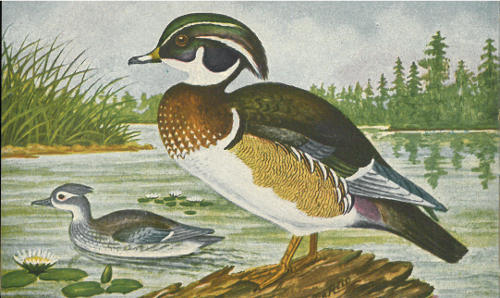
ILLUSTRATIONS BY
CHESTER A. REED, B.S.; HARRY F. HARVEY; R. I. BRASHER

Garden City New York
DOUBLEDAY, PAGE & COMPANY
1917
Copyright, 1913, by
CHAS. K. REED, WORCESTER, MASS.
The numbers and names used in this book are those adopted by the American Ornithologists’ Union, and are known both in this country and abroad. The lengths given are averages; our small birds often vary considerably and may be found either slightly larger or smaller than those quoted.
On some of the pages a number of sub-species are mentioned. Sub-species often cause confusion, because they are usually very similar to the original; they can best be identified by the locality in which they are found.
The nests and eggs are described, as they often lead to the identity of a bird. We would suggest that you neatly, and with ink, make a cross against the name of each bird that you see in your locality, and also that you write at the top of the page the date of the arrival and departure of each bird as you note it; these dates vary so much in different localities that we have not attempted to give them. As many will not wish to soil their books we would suggest that they have a leather-covered copy for the library and a cloth one for pocket use.
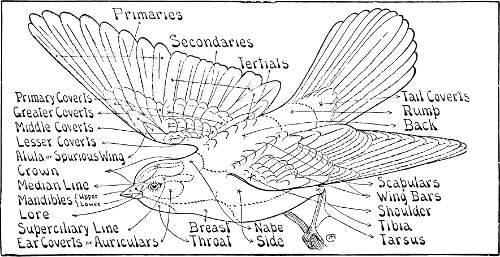
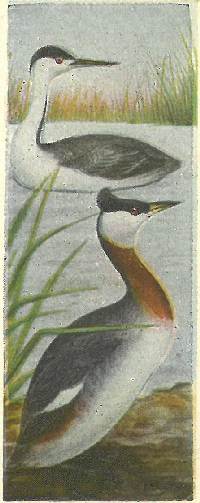
This is the largest of the grebe family. In summer the back of the neck is black, but in winter it is gray like the back.
Nest.—A floating mass of decayed rushes, sometimes attached to the upright stalks; 2 to 5 pale bluish white eggs are laid, usually much nest stained (2.40 × 1.55). Breeding in colonies.
Range.—Western North America, from the Dakotas and Manitoba to the Pacific, and north to southern Alaska.
This is next to the Western Grebe in size, both being larger than any of the others. In summer, they are very handsomely marked, as shown in the illustration, but in winter have the usual dress of gray and white.
Nest.—Similar to above, the eggs averaging smaller (2.35 × 1.25).
Range.—North America, breeding from northwestern Alaska, in the interior of Canada and North Dakota. Winters usually on the coasts.
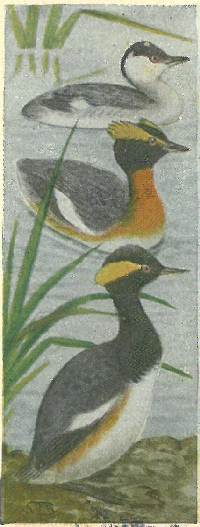
In winter this Grebe is one of the plainest in its dress of gray and white, but summer brings a great change, making it one of the most attractive, with its black, puffy head, and buffy white ear tufts, the front of the neck a rich chestnut color. Their food consists almost wholly of small fish.
Nest.—Is a loosely built mass of vegetation floating in the bog and water holes of the western prairies. The eggs, 3 to 7 in number, are brownish yellow (1.70 × 1.15).
Range.—Breeds from Dakota and Illinois northward; winters to the Gulf of Mexico.
This species is rarely found as far east as the Mississippi River. In summer the neck is black, lacking the chestnut color of the former. It can always be distinguished from the Horned by the upper mandible being straight on the top.
Nest.—In colonies similar to the above, laying from 3 to 8 eggs, which are usually nest stained to a brownish cream color.
Range.—From the Mississippi to the Pacific, nesting from Texas to British Columbia.
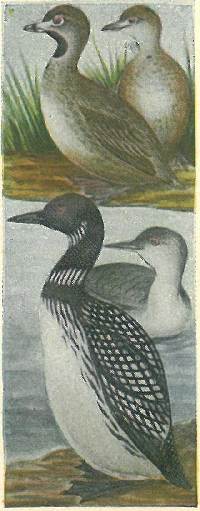
This species cannot be mistaken for any others of the grebes in any plumage, because of its stout compressed bill and brown eyes, all the others having red eyes. In summer the bill is nearly white, with a black band encircling it; the throat is black; breast and sides brownish-gray; the eye encircled with a white ring.
Nest.—Made of a mass of decayed weeds and rushes, floating in shallow ponds or on the edges of lakes among the rushes. Five to 8 brownish white eggs are laid (1.70 × 1.18).
Range.—Whole of N. A., breeding in small colonies or pairs.
In shape and motions the loons very much resemble the grebes, except in size, being much larger. The common loon is the most beautiful of them all, having a velvety black iridescent head with slashes of white on the throat and neck and spots of white on the wings and back.
Nest.—Usually built under some shelter of bushes or rushes on the edge of some of the larger ponds or lakes. The two eggs are a yellowish brown, with black spots (3.50 × 2.25).
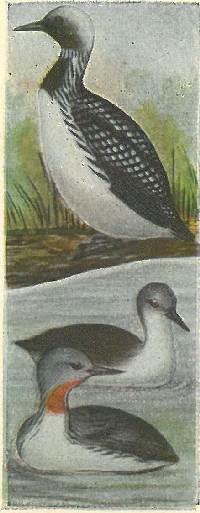
This species differs from the Loon in having the crown gray, and white streaks down the back of the neck, and in the color reflections of the black on the head. It is a trifle smaller also.
Nest.—Similar to the former, the eggs being more of a greenish brown, with the black spots mostly on the larger end (3.10 × 2).
Range.—Western N. A., breeding in Alaska and British Columbia; winters along the Pacific coast to Mexico.
The smallest of the Loon family. The back and head are gray, there is a large patch of chestnut on the fore-neck; under parts white. Owing to the straight top to the upper mandible the bill has a slightly up-turned appearance.
Nest.—Similar to the other Loons, placed within a few feet of the water. The eggs are an olive brown with more markings usually than the others, and mostly on the larger end (2.90 × 1.75).
Range.—Along the western coast of North America.
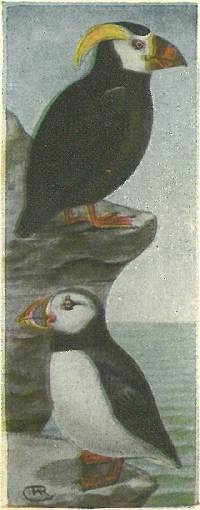
This is the largest of the family, they are odd looking birds, with short legs, stout bodies and very large, thin bills, highly colored with red and yellow, the feet are red and the eyes are white. They stand erect upon their feet and walk with ease.
Nest.—They breed commonly on the islands of the Pacific coast, laying their single white egg in burrows or crevices of the rocks. In some sections two or three broods are raised in a season (2.80 × 1.90).
Range.—Pacific coast from southern California to Alaska.
This Puffin is similar to the common Puffin of the east, excepting that the blackish band across the throat extends upwards in a point to the bill.
Nest.—The same as the above, the single egg averaging smaller (2.65 × 1.80).
Range.—Islands of the northern Pacific to the Arctic ocean.
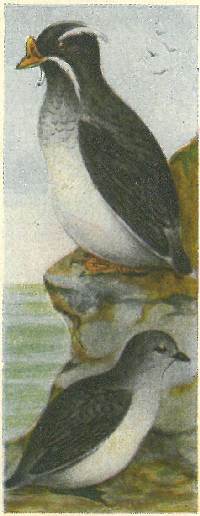
These birds have a much smaller bill than the Puffins; in the summer plumage there is a small horn at the base of the bill from which it is given its name. These birds do not stand upright as do the Puffins; but sit upon their tarsus.
Nest.—A single egg is laid in either burrows or in crevices of the rocks, usually without any attempt at nest making (2.70 × 1.80).
Range.—Coast and islands of the northern Pacific. Breeds from Oregon to northern Alaska.
A plain appearing bird, breast and throat grayish and belly white with blackish upper-parts relieved only by a small white spot over the eye. This Auklet is fairly abundant on the Farallones and islands off the Lower California coast.
Nest.—A single egg, dull white, the inside of the shell being a pale green when held to the light. These are laid in burrows or tunnels under the rocks, at times three or four feet long (1.80 × 1.30).
Range.—Pacific coast of N. A., Alaska to Lower California.
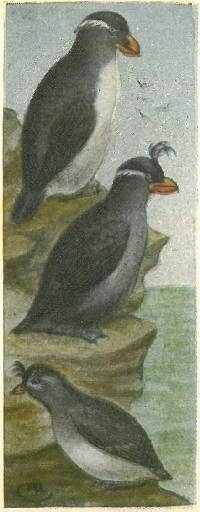
This bird is much like Cassin Auklet, but lacking the white spot over the eye and having a white breast. The bill is very peculiar, being quite deep and rounded and having an upward tendency. It is orange red in color.
Range.—The Alaskan coast, usually farther south in winter. Nesting in the Aleutian Islands, a single white egg is laid (2.25 × 1.40).
Breeds quite abundantly on some of the Aleutian Islands. The single white egg is laid in burrows or crevices of the rocks (2.00 × 1.25).
Similar in form and plumage to the Paroquet Auklet, except the whole under parts are gray.
Nest and Range.—On the islands and main land of the Alaskan coast, laying only one chalky white egg in crevices or burrows under the rocks.
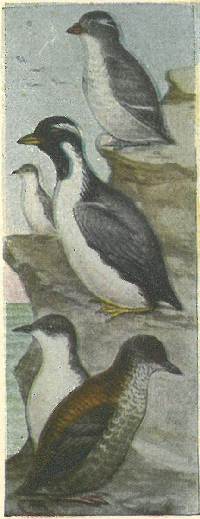
This is the smallest of the Auklets, and in habits are the same as others of the same family. They are one of the most abundant of the water birds of the extreme Northwest.
Nest.—Only one single white egg is laid upon the bare rocks or in crevices, on the islands of the Alaskan coast (1.50 × 1.10).
The Murrelets have no crests or plumes and the bills are more slender than the Auklets and are not highly colored.
Nest.—One or two eggs are laid either in burrows or crevices of the rocks, buffy white in color, with faint markings of light brown.
Range.—Pacific coast from southern California to Alaska, breeding north of the United States.
Nesting habits and eggs are similar to the Ancient Murrelet (2.20 × 1.40) and range is same as above, possibly breeding a little farther south.
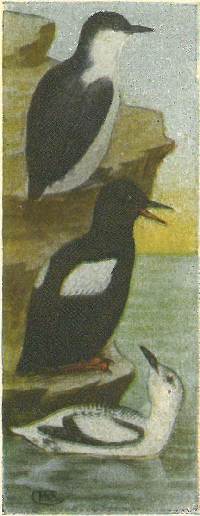
This bird is a dull black above, and entirely white below, including the sides of the head below the eye. The under-surface of the wing is also white.
Nest.—The single egg is laid at the end of burrows or under the rocks in dark places similar to the other Murrelets. It is a pale buffy white, and thickly but finely dotted with brown over the entire surface, heaviest on the larger end (2.05 × 1.40).
Range.—Resident along the coast of southern and Lower California, where it breeds on many of the islands.
This bird is very similar to the Black Guillemot except that the under-surfaces of the wings are dark. The nearly straight and slender bill is black, feathered to the upper edge of nostrils. Feet and inside of mouth bright red.
Nest.—Their two eggs are laid on the bare rocks in dark places under the rocks, are pale blue or green in color with black or brown markings and paler spots of lilac.
Range.—Pacific coast of North America.

This is one of the most abundant birds breeding on the Farallones. Large numbers of their eggs are taken yearly to the San Francisco and other market places and disposed of as a food product, and as yet the birds do not seem to diminish to any great extent.
Nest.—But a single white egg is laid on the bare ledges. They vary greatly in color, from nearly white without markings to a deep greenish blue with an endless variety of patterns in light and dark brown (3.40 × 2.00).
Range.—Pacific coast, breeding from the Farallones north to Alaska.
These birds are slender and graceful in form and flight, but are the real pirates of bird life, especially among the terns and gulls. This species has two color phases regardless of sex or age. In the light plumage the top of the head is black, rest of the bird brownish. Easily identified by the lengthened central tail-feathers.
Nest.—Two olive brown eggs spotted with black (2.20 × 1.70).

This bird has the two phases of color similar to the last. The two central tail-feathers are longer and more pointed, projecting about four inches beyond the others. All of the Jaegers have grayish blue legs with black feet, and brown eyes.
Nest.—A slight hollow in the marshy ground in which the two brownish eggs are laid (2.15 × 1.65).
Range.—Northern part of North America, south in winter to southern California, breeding in the Arctic regions.
This is the most swift and graceful of this family in flight. Similar to the last species, but the central pointed tail-feathers extend eight or ten inches beyond the others. It is more often found in the lighter phase.
Nest.—Their eggs are either laid on the bare ground or in a slight depression, scantily lined with grass (2.10 × 1.50).
Range.—Arctic America; south in winter to South America.
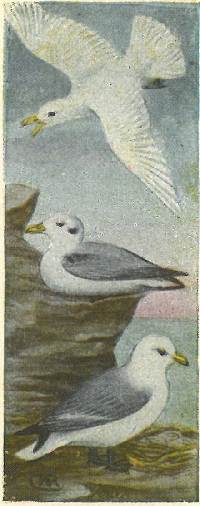
The little Snow Gull, as it is often called, in the breeding season is entirely white; the bill is tipped with yellow and there is a red ring about the eye.
Nest.—Of grasses and seaweed, on the cliffs in the Arctic regions. Three grayish buff eggs are laid marked with brown and black (2.30 × 1.70).
Range.—North of the Arctic Circle, and winters south to British Columbia.
These birds breed in immense rookeries on some of the islands in the Bering Sea.
Nest.—On almost inaccessible cliffs, made of sticks, moss and seaweed, making the interior cup-shaped, to hold the two or three eggs, which are buffy brown or grayish, spotted with darker shades of brown (2.20 × 4.70).
Range.—Coast of the North Pacific, wintering as far south as Lower California.
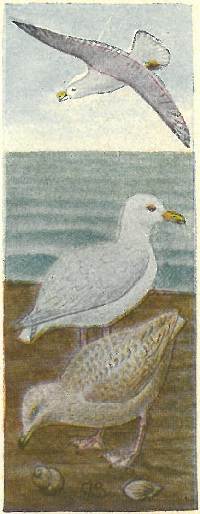
This Kittiwake is very much like the former, excepting that the legs are bright red, the mantle is darker and the bill shorter. They usually nest in separate colonies from the former, and can be readily identified when in flight by the red legs.
Nest.—They have been found abundantly on the islands of the Bering Sea, nesting on the higher ledges and cliffs. The color of the eggs is buffy or brownish, blotched and spotted with lilac and shades of brown.
Range.—Northwestern coast and islands of Bering Sea.
This is one of the largest of the Gulls; mantle light gray; it is distinguished by its size and the primaries, which are white to the tips. It is a powerful bird that preys upon the smaller Gulls, eating both the eggs and young.
Nest.—Of seaweed on ledge of sea cliff, eggs three in number, in shades of light drab to brown, spotted with brown and black.
Range.—Arctic regions, in winter south to San Francisco Bay.
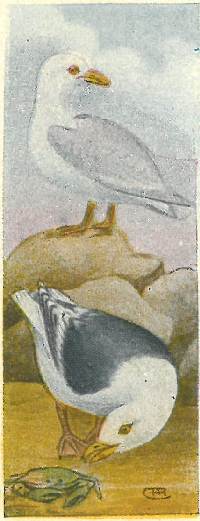
The primaries are the same color as the mantle on this gull except that the primaries are tipped with white. They breed in large numbers both on the rocky cliffs and on the low sandy islands of the Aleutians. On the cliffs large nests of seaweed are built, while on the low sandy islands no attempt is made at nest building.
Nest.—Two or three eggs are the usual complement, of a greenish brown ground color with various shades of brown spots, most thickly covered on the larger end (2.75 × 2.05).
Range.—North Pacific coast, breeding from British Columbia northwards, and wintering to southern California.
This large gull, with its almost pure white head and neck and slaty colored back, is one of the prettiest. They often nest in colonies with other gulls, building their small mounds of seaweed on the higher parts of the islands.
Nest.—Usually contains sets of two or three grayish colored eggs, spotted with dark brown and lavender (2.90 × 2.00).
Range.—Northern Pacific and Arctic oceans.
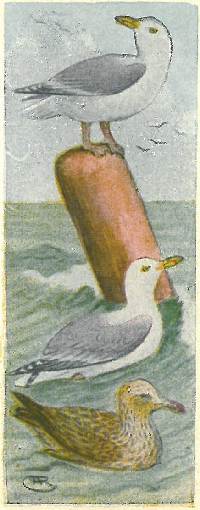
This bird is the most southerly distributed of any of the large Gulls, and can be seen about the harbors of California at all seasons of the year. They are great thieves, robbing the Murres and Terns wherever eggs are left unprotected, and are the greatest enemy that the Murres have to contend with.
Nest.—Their nests are made up of weeds and grass, and the full set contains three eggs of grayish brown spotted with dark brown, showing the usual variation found in color in the Gulls’ eggs (2.75 × 1.90).
Range.—Pacific coast, breeding from southern California to British Columbia.
These Gulls nest in colonies in favorable localities, usually on the ground, sometimes making a bulky nest of seaweed quite a distance from the water. A few pair nest on the islands of some of the inland lakes and it is not uncommon to see nests built in low trees ten or fifteen feet from the ground.
Nest.—They lay three eggs of a grayish brown color spotted with black and brown.
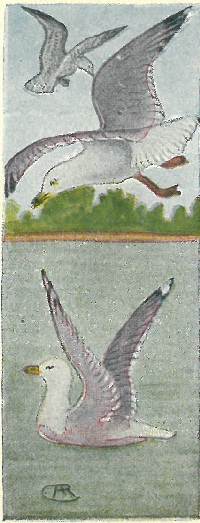
A small Gull with light gray mantle, black primaries with white tips and always to be identified in the breeding season by the black band around the middle of the greenish yellow bill. They nest in large colonies on the islands in the interior of the country. They frequent lakes and ponds at high altitudes in Colorado. Thousands of them breed about the lakes of the Dakotas and northward.
Nest.—Commonly lay three eggs, placing them in a slight hollow on the ground generally on the grassy portion of some island (2.80 × 1.75).
Range.—North America. On the Pacific coast from Lower California to British Columbia.
This is a slightly smaller Gull than the Cal. Herring Gull and the primaries are grayish instead of black. Bill yellow, with red spot near end of lower mandible; feet greenish yellow.
Nest.—Abundantly around Great Salt Lake, placing their nests generally upon the bare ground. Three or four eggs constitute a set, and they are the usual color of the Gulls’.
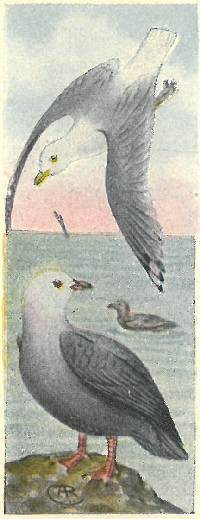
The short-billed Gull or American Mew Gull is much like the European variety. Adults in breeding plumage; mantle pearly gray; rest of white; outer primary nearly black with a white spot at the end. Bill, feet and legs greenish.
Nest.—On islands in the lakes and rivers of Alaska. The nest is generally made of moss, grass and weeds and placed on the ground.
Range.—Breeds from the interior of British Columbia to Alaska. Winters in the south to Lower California.
A handsome little species, often called the White-headed Gull. In summer the entire head, neck and throat are white, with a red bill and legs. The body color shades abruptly from the neck into slaty, both the upper and under parts. The primaries and tail are black.
Nest.—Similar to others of the Gull family, with three eggs greenish drab in color marked with brown, black and lilac (2.45 × 1.50).
Range.—Pacific coast of North America.
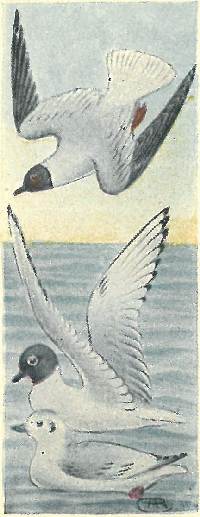
In summer, tip and outer web of outer primaries black; inner web and shaft white, with a black bill. The head and neck are gray; while in winter the head is white with gray spots back of the eyes. Young birds have the back mixed with brownish and the tail with a band of black near the tip. They are rarely found in the U. S. with the black hood.
Nest.—They nest in great numbers in the marshes of the northwest. The nests of sticks and grass are placed on the higher parts of the marshes and the usual complement of three eggs is laid. The eggs are grayish to greenish brown, marked with dark brown spots (1.90 × 1.30).
A handsome bird, having the slaty hood bordered behind with a black ring; the primaries black, white tipped, and the tail slightly forked. In winter the head and throat white with the back of the neck dusky.
Nest.—They breed abundantly on the marshes of northern Alaska and Greenland. The two or three eggs are greenish brown in color and marked with dark brown (1.75 × 1.25).
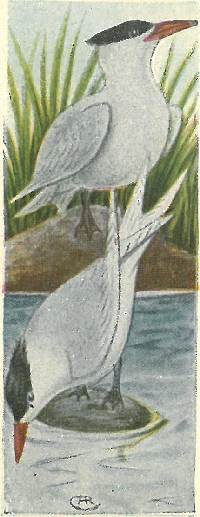
The largest and most beautiful of the Tern family. The bill is large, heavy and bright red. The crest with which this species is adorned is black. The mantle is pearl color and the breast is white. Winter birds have the crown mixed with white, and the young are blotched with blackish in the wings and tail.
Nest.—They sometimes nest in large colonies and then again only a few pair will be found on an island. Eggs vary from gray to greenish buff, marked with brown and lilac. The two eggs usually being laid in a hollow in the sand.
Range.—North America, breeding from the Gulf Coast and Lower California to the Arctic regions.
In the breeding plumage the under parts of the Terns are tinged with rosy, which probably first gave the birds their name.
Nest.—They lay but a single egg, in a slight depression in the sand, creamy brown with light brown markings (2.40 × 1.40).
Range.—Central and South America, in summer to California.
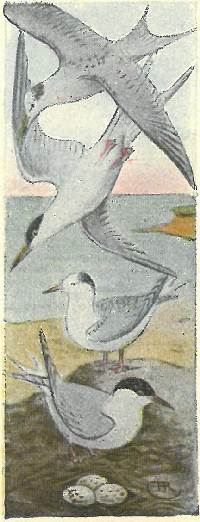
These beautiful birds are often known as “Sea Swallows,” because of their similarity in flight to those well-known land birds. They are the picture of grace as they dart about high in the air, bill pointed downward, alert and ready to dart down upon any small fish that may take their fancy.
Nest.—A slight depression in the sand, rarely lined with grass, in which are laid three, sometimes four, eggs varying in color from almost white to brownish, thickly spotted with brown and lavender (1.80 × 1.30).
Range.—Throughout North America; breeding from Manitoba to the Gulf Coast.
This bird differs from the above in the red of the bill being more blackish at the tip, and the under parts being a pearly gray in place of white, tail not quite as much forked, and shorter; edge of outer primaries and outer tail-feathers blackish.
Nest.—These breed much more abundantly on the Atlantic coast. Their eggs are more rounded (1.75 × 1.40).
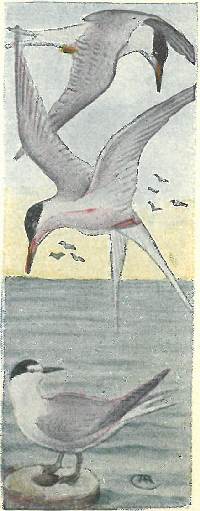
A similar bird to the last; more northern in its distribution; and the pearly gray mantle somewhat darker both above and below. Bill quite red and feet much smaller and bright red. When their nesting colonies are approached they will rise in clouds, circling about high in the air, uttering at times their peculiar cry.
Nest.—Similar to the others, with very little if any attempt at nest building. Usually placing the two or three eggs on the bare sand or gravel just above the water line. There is no difference in the color or markings of the eggs from the others (1.75 × 1.40).
Range.—More northerly than the preceding, to the Arctic Regions and wintering from California to the Gulf States.
This handsome Tern is of the same form and size as the Common Tern, but has a darker mantle, and the forehead is white, with a black line extending from the bill to the eye.
Nest.—Is much the same as the Arctic, but the eggs are somewhat smaller and narrower (1.70 × 1.15).

This is the smallest of our Terns; not much larger than a swallow and in flight are much the same, darting through the air, taking insects the same as swallows, or dipping into the water for small minnows that are showing themselves near the surface.
Nest.—Simply a depression in the sand or gravel just above the water line, with two to four creamy white eggs beautifully marked with different shades of brown and lilac (1.25 × .95).
Range.—Throughout the United States to northern South America, breeding abundantly on the coast of southern California.
We always think of the Terns as light colored birds, either white or pearly; but here we have one nearly black. Adults in summer having the head, neck and under parts black, with the back, wings and tail gray.
Nest.—Their nesting habits vary also as much as their color. Nests are of weeds and grass in the sloughs on the prairies. Two to four eggs are a dark greenish brown with black spots (1.35 × .95).
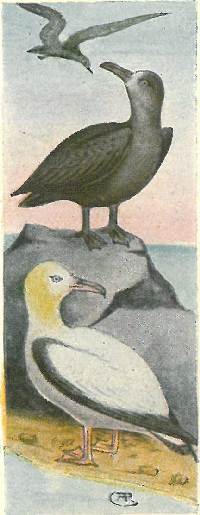
This bird is of a uniform sooty brown color shading into whitish at the base of the bill, which is rounded. It is noted for its extended flights, following vessels day after day without any apparent period of rest.
Nest.—They lay a single white egg upon the ground (4.00 × 2.40).
This bird is much more shy than the former, and when following a vessel will keep a long distance behind in its search for food. With the exception of the primaries, which are black, as are also the shoulders and tail, the entire plumage is white, tinged with yellow on the back of the head.
Nest.—They breed on the islands in the North Pacific off the coast of Alaska. A single white egg is laid upon the bare ground or rocks.
Range.—Northern Pacific ocean in summer from Lower California to Alaska; most common in northern part of the range.
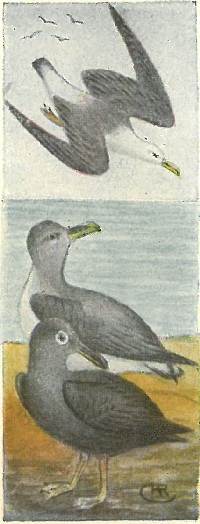
These birds are white with the exception of the back, wings and tail, which are black; bill and feet yellow.
Nest.—Their single white egg is laid upon the ground or rocks (4.00 × 2.35).
Range.—This species breeds in large numbers on the island from which it takes its name—Layson Island, of the Hawaiian Group—appearing rarely off the coast of California.
This is a species which inhabits the South Pacific and Indian oceans and is said to occur rarely on the California coast. An egg in the collection of Col. John E. Thayer, Lancaster, Mass., was taken on Gough Island Sept. 1st, 1888. The nest was a mound of mud and grass about two feet high. The single white egg measured 3.75 × 2.25.
This species is entirely sooty brown except the white rim around the eyelids. One white egg is laid (4.10 × 2.75).
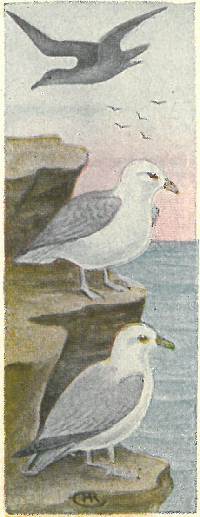
In markings these birds closely resemble the Gulls. Bill is shorter and stouter, strongly hooked at the tip, and with the nostrils opening out of a single tube, prominently located on top of the bill. Their flight is graceful like that of the Gulls.
Nest.—On the islands and cliffs of the mainland of the Northern Pacific they nest in large colonies. Every crevice in the rocks having its tenant. They lay but a single white egg on the bare rocks (2.90 × 2.00).
Range.—Northern Pacific, southerly to Lower California.
This species has a paler mantle than others of the family, and the primaries are black.
Range.—Southern seas, appearing on the Pacific coast of the United States in the summer. They probably breed in the far south during our winter, although we have no definite record relative to their nesting habits.
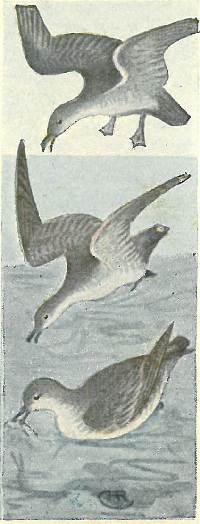
Very little is known of the breeding habits of this bird. Upper parts and under-tail coverts are a pale brownish color, darkest on the wings; top of head dark, with throat and breast white, with yellowish bill and pink colored feet.
Range.—From Monterey, California, to South America.
Similar to the previous, only smaller and somewhat lighter in color. Quite common in southern California and much more so in Lower California.
Range.—From northern United States to Lower California. A single white egg is laid (2.00 × 1.30).
A more southern species; occurs occasionally on the lower California coast and islands.
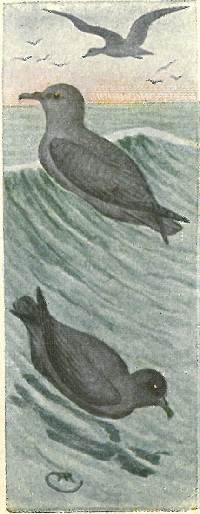
This is a southern species which, after nesting on the islands in the far south during our winter months, comes north and appears off the Pacific coast of the United States during our summer months, as far north as Alaska. They are a dark sooty gray, except for the under-coverts, which are whitish.
Nest.—Habits are the same as the others of the family. The single white egg is laid at the end of the burrows or in crevices under rocks (2.40 × 1.65).
This is much smaller than the preceding, otherwise resembling it in color and markings, being a little lighter under the throat, and the bill more slender in proportion to the size of the bird. Bill and feet nearly black, as is also the one above.
Nest.—Nesting habits and range of the bird are the same as the Dark-bodied Shearwater; it is not found on the N. A. coast as commonly as the other.
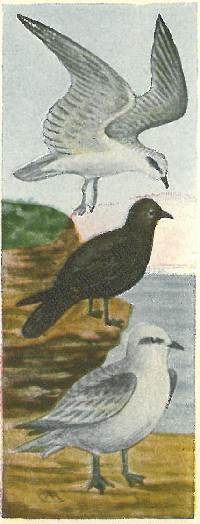
This is a handsome bird known only from the type specimen taken off Kadiak Island, Alaska, by Mr. Fisher.
This is the smallest of the family. Their plumage is entirely dark sooty.
Nest.—They have been found breeding on the islands of Lower California, and they probably do on others farther south. The single egg of this bird is white with a wreath of tiny brown specks about the larger end.
These birds have a plumage of bluish gray, the wings being darker and the under parts lightest.
Nest.—Single egg is laid at the end of a burrow on the ground. Egg white with a fine wreath of purplish black specks about the larger end. Found breeding on the islands of Alaska.

This bird is similar to the following, but a trifle smaller and the tail less deeply forked. Its range is from northern California to Mexico, breeding in the southern part of its range.
These are quite common on both the eastern and western coasts, breeding from the Farallones northward to the Aleutians. They are of a sooty brown color, upper tail-coverts and side of under-coverts white. They burrow in the ground for two or three feet, but make no attempt at nest building; placing their single white egg on the bare ground at end of burrow. These birds generally take turns in the task of incubation, one remaining at sea during the day and returning at night. They are rarely seen in the vicinity of their nests during the day.
Very similar to the preceding, having more of a forked tail and somewhat longer. Breed on the islands of Lower California.
Nest.—Same as above with one white egg, usually much nest stained.
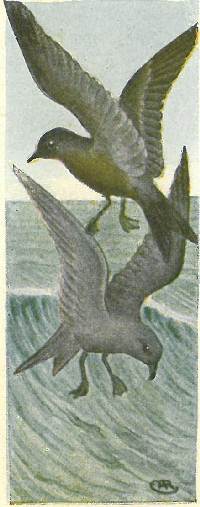
These birds are sooty black all over, lacking the white rump of the two or three preceding. All of the Petrels have a very offensive musky odor, which is always noticeable about an island inhabited by them. The skins and eggs of the birds always retain this odor.
Nest.—Made in burrows similar to the others, but sometimes containing a small amount of nesting material; grass and roots.
Range.—Southern California southward to Mexico.
This species breeds most abundantly on the Farallone Islands, sooty gray in color, their plumage matching their surroundings so closely that, unless one is looking for them, they will easily be overlooked.
They sit very close when nesting, and will even allow themselves to be removed from the nest by hand, so tame are they. They build in burrows or in any crevice of the rocks, laying their single white egg on the ground or rock without much, if any, lining to the nest.
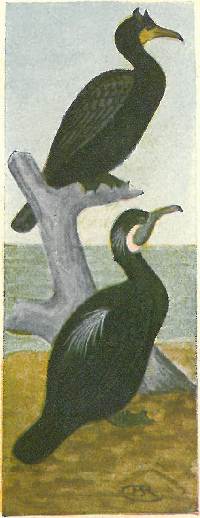
Plumage glossy greenish black, with back and wings slaty. These birds breed in large numbers on the Farallones, placing their nests well up on the higher ridges and also in the trees on some of the inland islands, or near large ponds or lakes. They build large nests of sticks and roots, lined with grass, seaweed and moss.
Nest.—Three to five chalky, greenish white eggs are laid (2.40 × 1.50).
Plumage, under parts are same as above. Bill more slender and nearly straight. The young are hatched without feathers or down and the skin is nearly black. The young for two or three months are the food supply for the larger Gulls. Like the other Cormorants breeding on these islands, they stay closely by their nests to protect them from the Gulls that are always on the watch for either the eggs or young.
Range.—Pacific coast, breeding along the whole coast of the United States.
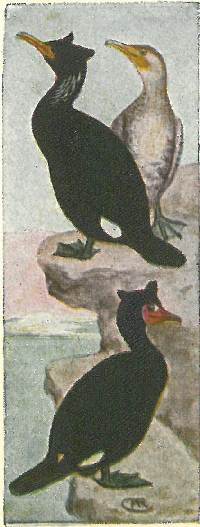
This smaller Cormorant breeds on the Pacific coast from Washington south to Mexico. It is not nearly as common as the former species and not inclined to breed in colonies with the others, but is more secluded.
Nest.—Their nest building is very similar, using the rocks and cliffs on which to place their nests mostly, and very seldom building in trees. Their eggs are much smaller, averaging 2.20 × 1.40.
The plumage of this species differs from the above chiefly in having the forehead bare. Their breeding habits are the same as other members of the family. That the Cormorants are expert fishermen may be seen from the fact that the Chinese tame them to catch fish for them, placing a ring about their necks to prevent their swallowing the fish.
Nest.—The nesting places of these as well as other members of this family are very filthy, being covered with excrement and the remains of fish that are strewn about their nests (2.50 × 1.50).
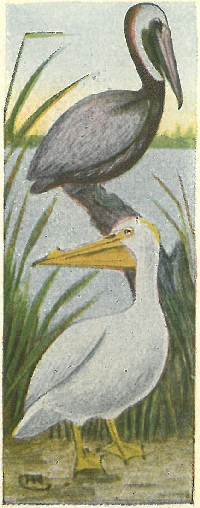
Plumage mostly white, with black primaries; eyes white; bill and feet yellow, the former in the breeding season having a thin upright knob about midway on the top of the upper mandible. They get their food by approaching a school of small fish and suddenly dipping their head beneath the surface, sometimes scooping a large number of fish at a time; they contract the pouch, allowing the water to run out of the sides of the mouth, and then swallow the fish.
Nest.—On the ground made of sticks and weeds, generally only a lining about the outer edge; the eggs being placed upon the ground. Two or three eggs are laid, pure chalky white (3.45 × 2.30).
Upper parts gray; lower brownish streaked with white; back of neck rich velvety brown; head and throat white.
Nest.—On the ground or in small trees, composed of sticks and weeds. Three or four chalky white eggs (3.10 × 1.95).

In comparison with their weight, these birds have the largest expanse of wing of any known bird. Weighing only about four pounds they have an extent of from seven to eight feet. The length of the bird is about 40 inches, of which the tail comprises about 18, more than half of this being forked. They can walk only with difficulty and are very poor swimmers, owing to their small feet and long tail, but they are complete masters of the air and delight to soar at great heights. Their food of small fish is secured by plunging, or preying upon other sea birds.
Nest.—A frail platform of sticks in the tops of bushes or low trees. A single white egg (2.80 × 1.90).
These birds have the bill long, not flattened, but edged with sharp teeth to grasp the fish, upon which they live to a great extent.
Nest.—In holes of trees, cavities among the rocks, or on the ground; 6 to 9 creamy buff eggs are laid (2.70 × 1.75).
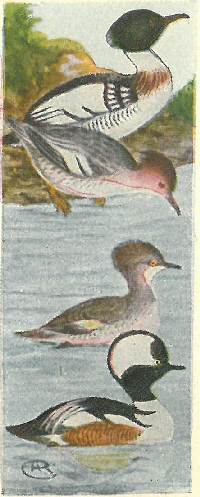
This species is more abundant than the preceding, and is found commonly on our large ponds, lakes and rivers, more than on the coast. The male has the head, neck, and crest iridescent greenish black, breast brownish with black spots. The female has the head, neck and crown a deep chestnut color and the upper parts and tail a gray in place of the black found on the males.
Nest.—They lay from seven to ten eggs of a creamy buff color, making their nest of moss and grasses, placed under or in tufts of grass or in crevices of rocks; usually lining the nest with feathers (2.50 × 1.70).
Range.—Whole of North America, breeding from central United States to British America.
Bill short, compared with the preceding. The large crest with which both sexes are adorned will easily distinguish this from the others. The male having the crest black with a large white patch, and that of the female plain brown.
Nest.—In holes of trees; 8 to 12 eggs, grayish white (2.15 × 1.70).
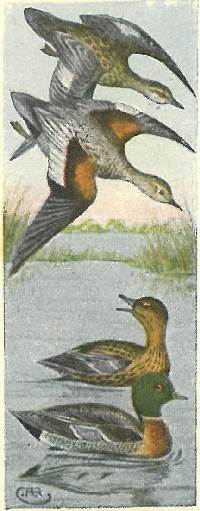
Male with chestnut wing coverts and white speculum; the female is similar but the back and wings are brownish-gray. As is usual with many of the ducks these do most of their feeding early in the morning or after dusk, and spend the greater part of the day in sleeping. They are one of the most noisy and active of the ducks.
Nest.—They nest on the ground among the reeds of marshes or in the long grass of bordering fields. They lay from 7 to 12 eggs of a creamy buff color (2.10 × 1.60).
Range.—Includes the whole of North America, breeds from British Columbia to southern California.
These are regarded as one of the best table birds. They feed on mollusks and marine insects which they generally reach by tipping in shallow water.
Nest.—In close proximity to ponds or lakes, placing their nests in the tall grasses of which it is made and lined with feathers. Breed from Alaska to southern California (2.25 × 1.25).
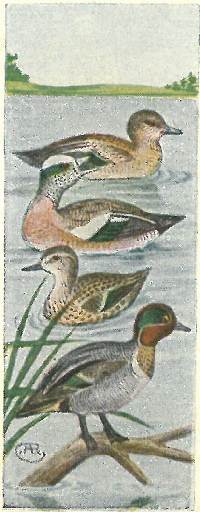
These are common and well-known birds throughout North America, where they are called by a great variety of names, most of which refer to the bald appearance of the top of the head, owing to the white feathers. They can usually be identified at a distance by the absence of any dark markings, and when in flight by the whiteness of the under parts.
Nest.—Made of grass and weeds neatly lined with feathers, on the ground or in marshes. 6 to 12 cream colored eggs are laid (2.15 × 1.20).
These are the smallest of the Duck family, and are eagerly sought for by sportsmen, both for their beauty and the excellence of their flesh. The male may be easily identified by the reddish brown head and neck, with the large green patch behind each ear.
Nest.—On the ground under the shelter of tall grasses, it is made of weeds and grass and lined with feathers. 5 to 9 buffy eggs are laid (1.85 × 1.25). Breeds abundantly in California and Oregon.
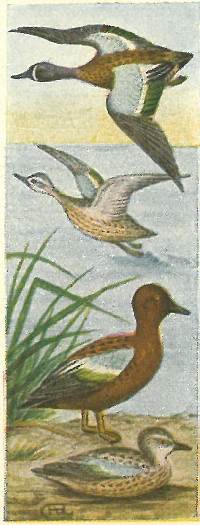
Male has the head a dark gray with white crescent in front of the eye; under parts chestnut heavily spotted with black; wing coverts bright blue. Female similar to female Green-wing, but has the blue wing coverts. In flight can be easily separated from the Green-wing by its darker under parts. Their flight is very rapid, and usually in compact lines. This is more common east of the Rockies than the other.
Nest.—Made of grass and nicely lined with feathers placed in the reeds bordering marshes. 8 to 12 creamy colored eggs are laid.
Range.—North America, breeding more abundantly than the former farther north in its range.
This is the most abundant of the Teal family west of the Rockies. It is on the male a bright cinnamon color on the under parts; also the head and neck, being darkest near the bill and lightest on the back. Wing coverts blue; speculum green, divided by a line of white.
Nest.—Made same as above with 6 to 14 eggs (1.85 × 1.35).
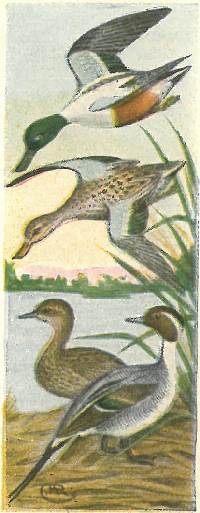
Easily recognized in any plumage by the large broad bill, which is out of all proportion to the size of the bird. Head, neck and speculum dark green, under parts reddish brown, breast and back white, wing coverts blue. If it were not for the large ungainly bill, this duck would be classed as one of our most beautiful during the breeding season.
Nest.—It makes its nest on the ground in marshy places of grass, weeds and lined with feathers; laying from 6 to 10 grayish white eggs (2.10 × 1.50).
Range.—North America; breeding most abundant on the western coast from southern California to northwest Alaska.
A long-necked duck and with a long pointed tail. Male with head and stripe down the back of neck, brownish; back and sides barred with white and black wavy lines.
Nest.—On the ground like the other ducks, well-lined with feathers generally placed near the water, laying from 6 to 12 eggs of a dull olive color (2.20 × 1.50).
Range.—North America.
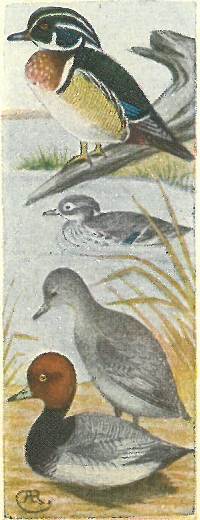
This bird, without doubt, is by far the most beautiful of any of the duck family. Both the male and female have a long crest; that of the male of the most beautiful shades of blue and iridescent green colors, with stripes of white, the throat and under parts also white, breast chestnut with white arrow head marking, sides buff with black and white line markings.
Nest.—In the hollow of a tree, usually near the water. The birds are said to carry the young from the nest to the water in their bills. 6 to 10 eggs, buffy in color (2.25 × 1.60).
Range.—Temperate North America, breeding from Canada to the Gulf of Mexico.
This bird, the preceding and the one following are considered as the best table birds of the duck family.
Nest.—Placed on the ground in marshes. Eggs 6 to 14 in number, buffy white in color (2.40 × 1.70).
Range.—North America, breeding from Minnesota northward.
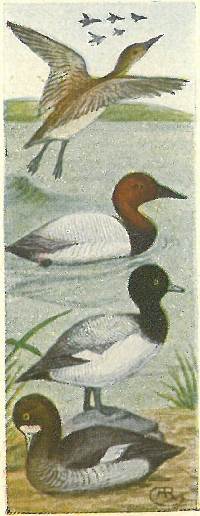
Differs from the Redhead in the shape of its black bill, its blackish forehead, very light colored back and red eyes, the Redhead having yellow eyes. Like the last species, these birds are excellent swimmers and divers, and secure their food from deeper water than many of the ducks. Their food consists of various fresh water plants and small fish; shell fish and frogs. These usually command the highest market price, and are much sought after by gunners.
Nest.—On the ground in marshes or sloughs, lined with grass and feathers. 6 to 10 eggs of a pale olive (2.40 × 1.70).
Range.—North America; breeding from central British Columbia south to Oregon and Minnesota.
This and the following are widely known as Blue-bills owing to the slaty blue color of that member. Head, neck and breast are black; speculum and under parts white, and eyes yellow.
Nest.—In marshes about many of the ponds in the interior of British Columbia. 6 to 10 eggs pale greenish gray (2.50 × 1.70).
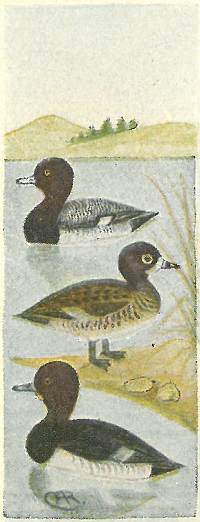
Slightly smaller than the last, and with the head of the male glossed purple instead of green on the black. They are one of the most abundant migrants, and are one of the most active of the family, diving at the flash of a gun. The immense flocks generally keep out in the open waters of the lakes or rivers; where they feed by diving.
Nest.—Is made of marsh grasses and neatly lined with feathers from the breast of the female. 6 to 9 eggs of a pale gray color (2.25 × 1.55).
In appearance and general habits this duck is much the same as the two preceding. Male with head, neck and breast black with purple shades, having a ring of chestnut about the neck, which at a little distance is not noticeable. Bill blackish, with a bluish band near the end; eye yellow.
Nest.—Same in every way as above, and general distribution the same, breeding from Oregon and Minnesota northward.
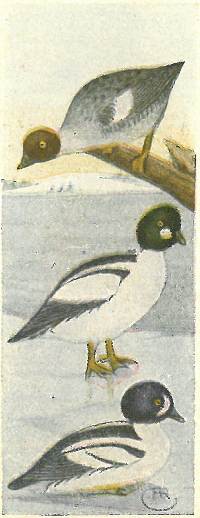
These are handsome ducks, known as “Whistlers,” from the noise of their wings when flying, and also “Great-heads,” because of the puffy crest. The head is greenish black with a large round white spot in front of and a little below the eye. The rest of the plumage is black and white.
Nest.—Built in the hollows of trees near the water, lining the cavity with fine grasses, moss or leaves and then lining the nest with feathers, in which they place from 6 to 10 eggs of a grayish color (2.30 × 1.70).
Range.—North America, breeding from Alaska south to the most northern of United States. Winters to southern California and the Gulf Coast.
Head of this species a bluish black, with a crescent white spot between the bill and eye; which is yellow as also is the preceding.
Nest.—The range and nesting habits are the same as above, possibly breeding a little farther south on the Pacific coast.
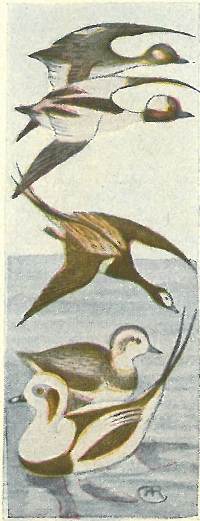
This handsome little duck is also known as “Butter-ball” and “Dipper-duck,” the latter name given to them on account of the ease with which they can disappear under the water. They are always on the alert and will dive at the flash of a gun. Head iridescent blue, green and purple, and with a large white patch extending from eye to eye, across the back of the puffy crest. Their flight is very rapid, and they can take wing from the water easier than the majority of ducks.
Nest.—In holes of tree stumps or in the banks along the sides of rivers, 8 to 14 eggs of a light grayish color (2.00 × 1.40).
One of the very few ducks that change their plumage in summer and winter. Both sexes are marked similarly, but the female is somewhat duller and lacks the long tail feathers of the male. They are excellent swimmers and dive to great depths in search of their food.
Nest.—Generally concealed in the long grass near the water, made of grass and lined with feathers. 6 to 10 eggs (2.00 × 1.50).
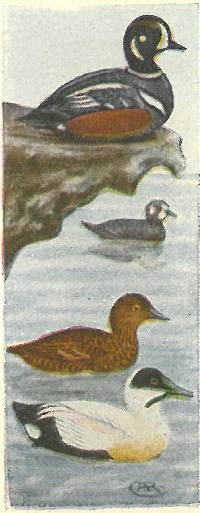
A beautiful and most attractive bird as shown in the illustration. It is not the colors alone that make them so attractive, but the way the colors are placed. The white being in long stripes, crescents or large spots, with black, gray and chestnut. They are usually found only in pairs among the swiftly running streams, or in the winter in small flocks on the coasts.
Nest.—Is nicely woven of weeds and grasses and lined with down placed on the ground in crevices of rocks or sometimes in the hollow of a tree. 5 to 8 greenish buff eggs (2.30 × 1.60).
Range.—Northern North America, breeding from Alaska to the central part of California among the mountain streams.
This bird is in plumage like the Northern Eider, except that it has a black V-shaped mark on the throat. They nest sparingly on the Aleutian Islands, but in great numbers farther north.
Nest.—They make their nests of seaweed and grass, warmly lining same with down from their breasts. 6 to 8 eggs (3.00 × 2.00).

A very beautiful species; head white, washed with greenish on the forehead and nape; chin, throat, neck, back, tail and crissum, black; under parts chestnut; wing coverts white, the long scapulars black and white.
Nest.—Are made of grasses and heavily lined with down. It breeds on the rocky coast and islands of Bering Sea. The six to nine eggs are pale olive green in color (2.25 × 1.60).
Range.—Arctic regions in America, chiefly on the Aleutian Islands and northwest coast of Alaska.
This species is black on the under parts and mostly white above. The head is largely washed with sea green, leaving a large patch of white, narrowly bordered with black around each eye, thus resembling a pair of spectacles and giving it the name it has.
Nest.—Is made of seaweed, grass and lined with down from their breast; they are placed upon the ground under overhanging stones or clumps of grass. 5 to 9 eggs (2.70 × 1.85).
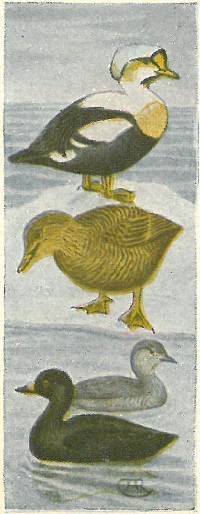
This species is very different from any of the preceding, the crown being of an ashy blue, and the long scapulars black in place of the white of the others. It also has a broad V-shaped mark on the throat and a black crescent between the eye and bill. Like all of the other Eiders the females are mottled brown and black, the different species being very difficult to separate.
Nest.—These are usually a depression in the ground lined with the down from the breast, and contain from 6 to 10 eggs of a greenish color (3.00 × 2.00).
Range.—Northern North America, breeding along the coast of Siberia, Bering Sea and Arctic coast of America.
Scoters or “Coots,” as they are generally called, are Sea Ducks whose plumage is almost wholly black; base of the bill is yellow and orange. This species nest similar to the Eiders, concealing it under overhanging rocks or in tufts of grass. 6 to 10 eggs of a dull buff color (2.50 × 1.70).

This is the largest of the Scoters, and may easily be distinguished from the others by the white speculum on the wing and a white comet extending from the eye backwards. It also has a yellow eye.
This species often feeds in very deep water, like others of the family.
Nest.—They nest on the ground, generally in long grass or under low bushes, making a coarse nest of grasses, and sometimes twigs, lined with feathers; 6 to 8 pale buff eggs (2.75 × 1.70).
Range.—North America, breeding in British Columbia and Alaska.
The male of this species is entirely black, excepting a white spot on top of the head and another on the nape; eye white; bill red, white and yellow with a large black spot near the base. The female is a grayish brown, lighter below; also with a spot of dull white in front of the eye and the same in back.
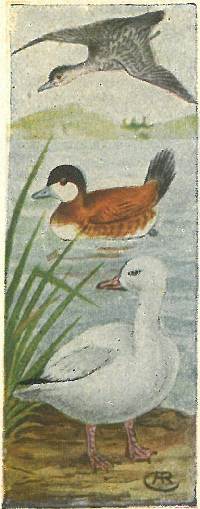
This species may always be recognized by the reddish brown upper parts; blackish head, with white cheeks and chin and under parts silvery white with grayish wash next to the ruddy. Bill is very stout and broad at the end, and the tail feathers are very stiff and pointed. Females have back, crown and sides grayish, cheeks showing traces of white as on the male. These ducks are very quick either in the water, on land, or in flight.
Nest.—They are usually made of grass and rushes and generally lined with down in which are placed their eggs to the number of from 8 to 12 of a grayish white color (2.40 × 1.75) unusually large for the size of the bird.
Range.—The whole of North America, breeding from Central British Columbia southward as far as Lower California.
Plumage entirely white with primaries tipped with black. This is the smallest species of the Snow Goose, the eastern variety being some ten inches longer, found in N. A., west of the Mississippi River.
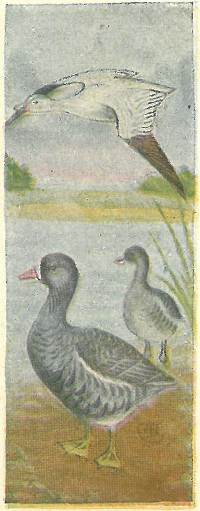
This beautiful species, with its breeding range unknown, winters in California and as far south as the Gulf of Mexico, and is the smallest of the family.
These birds may be recognized by their mottled plumage, dark head and white forehead; bill and feet orange. They are the most common on the western coast and large numbers of them are sold in the markets.
Their food consists mostly of vegetable matter, frogs, snails, and insects.
Nest.—These are placed upon the ground in a slight depression and made of dried grasses, feathers and down. Eggs are from four to nine in number, of a dull buff color (3.00 × 2.05).
Range.—Western and central North America, breeds on the Arctic coast south to the lower Yukon Valley, winters from British Columbia to southern California. During the spring flight immense flocks of these birds pass through Oregon and follow down the west coast.
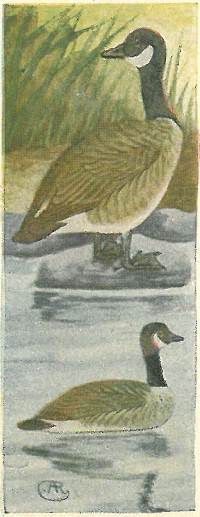
This species is the most widely known of the family, and is the most numerous. Its familiar “honk” has long been the signal of the coming spring, and the V-shaped formation in which the flocks migrate is always an object of interest to every one; large birds, with long necks outstretched, wings beating the air in unison, and all following the leadership of one bird in their journey over their invisible path.
Nest.—Of grasses and feathers lined with down, placed on the ground in marshes or near lakes or ponds; four to nine eggs of a buff or drab color are laid (3.50 × 2.50).
Range.—The whole of North America, breeding from northern United States northward, and wintering in the southern part of U. S. to Lower California.
This is a perfect miniature of the above, the difference being only in the size. It breeds in Alaska and along the Arctic coast and migrates in winter along the western coast south to southern California. Eggs are buff color; 4 to 9 (2.90 × 1.95).
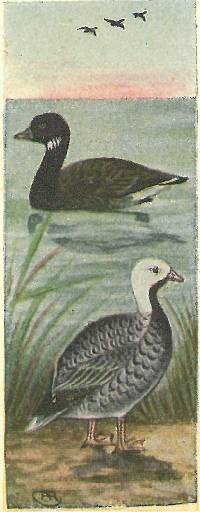
Head, neck and breast black with a broad white collar nearly encircling the black neck, back a grayish brown; under parts mostly white. They are very inquisitive and easily come to decoys, and consequently large numbers of them are shot each year for the markets. They are a noisy bird especially when in large flocks. They get most of their food by tipping up in the shallow waters, where they feed upon the tender water plants and roots gathered from the bottom.
Nest.—A depression in the ground lined with grass and feathers and the down from their breasts; four to eight eggs are laid of a grayish color (2.80 × 1.75).
Range.—Western North America, breeding abundantly in northern Alaska and wintering on the Pacific coast from British Columbia to Lower California.
This handsome species may be known by the mottled or scaly appearance of the feathers; the head is white with a black chin and throat. Their 3 to 7 eggs are a dull buff color (3.10 × 2.15).
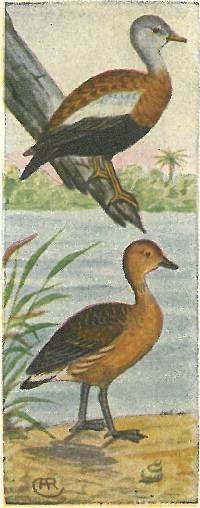
These odd-shaped ducks, with their long legs and neck, are very common in southern Texas and along the Rio Grande. They are not timid and are frequently caught and domesticated. They can walk and run gracefully, and feed in grain fields at considerable distance from the water. They usually raise two broods in a season, each brood having from ten to as many as twenty.
Nest.—They build their nests in hollow trees, oftentimes at a great distance from the water. The nest is lined with a few feathers and down. The eggs are a creamy white (2.05 × 1.50).
In form this duck is much like the last, but in color is more of a rufous all over, being darkest on the upper parts. It has no white markings. It is fully as abundant as the preceding and is found farther north and west to the Pacific coast in southern California.
Nest.—Their nesting habits; their eggs and the size of them are identical with the former. As many as 32 eggs have been found in one nest, but these were probably laid by two birds.
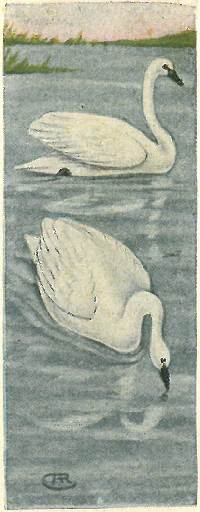
These large birds are snow white, with the exception of their bill and feet, which are black. The nostril is situated nearer the end of the bill than it is to the eye. It is distinguished from the next by the small yellow spot on either side of the bill near its base.
Nest.—Are made of a large mass of rubbish, weeds, moss, grass, feathers and a few sticks, generally placed in marshy places near ponds or lakes. Three to six greenish or brownish buff eggs are laid (4.00 × 2.75).
Range.—North America, more common in the east, breeding in Alaska and the Arctic islands, wintering from British Columbia to the central part of California.
This magnificent bird, over five feet in length, with a spread of wing nearly ten feet, is found more in the interior than on the coast. Its plumage is the same as above, except that the bill is entirely black and the nostril is located nearer the eye. Their nesting habits are the same as above, the eggs averaging a trifle larger.
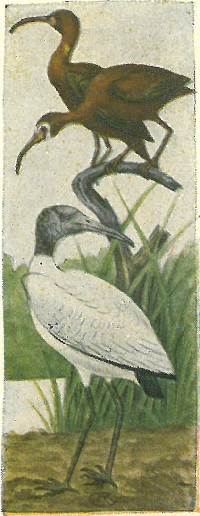
The neck and body of this bird is a rich dark chestnut color, glossy with purplish on the head; wings and tail glossy greenish black; bill, legs and feet carmine red, bill much curved downward.
This bird is just the same as the White-faced Glossy Ibis which is occasionally found in southern California, with the exception that the latter has the forehead and feathers, bordering the bill, white.
Nest.—Strongly and compactly woven of dead rushes attached to living stalks, and well cupped. Eggs 3 or 4 deep greenish blue color (1.95 × 1.35).
Head and neck unfeathered and covered with scales, which are pale bluish in color as are also the legs. Plumage entirely white except for the primaries and tail, which are glossy purplish black. This is the only true Stork which occurs in North America, and is found only in the southern part of California and the most southern states near the Gulf of Mexico. They lay 3 or 4 white eggs (2.75 × 1.75).

This small variety of Bittern is very common in the southern portions of the United States. They are very quiet and sly birds, and their presence is often unsuspected when they are really quite abundant. Their nests are made of rushes woven about the upright stalks; 3 to 5 eggs, bluish white (1.20 × .90).
These are birds of the bogs and marshes, and will keep concealed so closely that one may pass within a few feet of them and they not take flight. They are known by a variety of names, nearly all of which have reference to their “booming” sound while in the bogs. The most common name given them being “Stake Driver” and again “Thunder Pumper.” They are much variegated with brown and yellowish brown; adults with a long, broad black stripe on either side of the white throat; eye is yellow; bill and legs, greenish yellow.
Nest.—They build in swamps or marshy places, placing their nest usually in a tussock of grass on some bog surrounded by water. They lay from three to five brownish colored eggs (1.95 × 1.50).
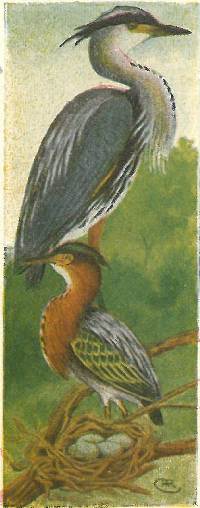
This handsome Heron in general color in the adult stage is bluish gray, relieved by a black crest, and black primaries and patches on the sides and a white crown. Young birds are much duller colored and lack the crest of the old birds. It takes several years for them to obtain their perfect plumage. In the South they breed in large colonies, often in company with many other species.
Nest.—Is usually built of sticks, making a rude platform in the trees near swamps or wet woods. In some localities as many as 40 nests have been found in a single tree. Three to five eggs of a greenish blue color (2.50 × 1.50).
Range.—North America except the extreme northern part, breeds from British Columbia to southern Lower California.
This is the smallest of our Herons, and is well known all over the country. In most sections of the country they will be found nesting, one of two pairs together, along the border of some swamp or stream; 3 to 5 pale greenish blue eggs (1.45 × 1.10).
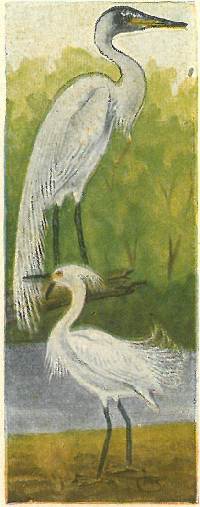
This is our most beautiful pure white Heron; one which has persistently been hunted for its beautiful plumes for millinery purposes. They usually breed in colonies with several others of the Heron family.
Nest.—Is generally a frail platform in small trees or bushes over the water in which they lay three or four light bluish green colored eggs (2.25 × 1.45). Breeds in Oregon and California.
Plumage white; in breeding season with numerous recurved plumes growing from the middle of the back; long crest of plumes on back of the head, and on the breast. Bill black, greenish at the base; legs black and feet yellow. With the protection which has been placed on these birds and the large breeding places in their favorite locations made into Government reservations we hope to see these become more abundant within a few years. Their nesting habits are the same as above, only the eggs are smaller (1.80 × 1.25).
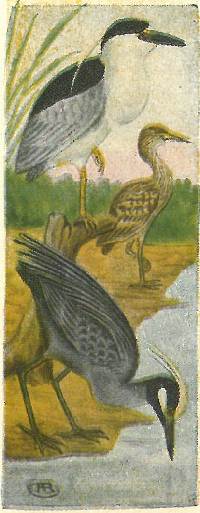
A well-known bird often called “quawk” from the note which it makes during its evening flights. They are usually found nesting in large colonies, while in some places a few secluded pairs nest; a favorite place being among pine trees on the edge of muddy ponds.
Nest.—Is built of sticks, with no lining, and placed in the higher limbs of the trees, not unusual to find a dozen or more in each tree. Eggs are pale greenish color (2.00 × 1.40).
The head of this species is adorned with three long, rounded white plumes; in life these plumes are rarely separated, but are nested together so that they appear to be as one. On the back they also have long lanceolate gray plumes; crown and a comet shaped patch under the eye of a yellowish white. As dusk approaches, these birds start out from their roosting places, and, with slow, measured flaps, wing their way to their feeding grounds, which are fresh water bogs, their food consisting of insects, frogs, snails and small fish.
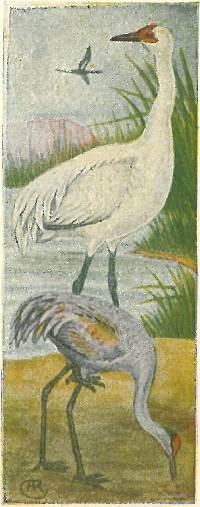
This is the largest of the family in America. The plumage of the adults is pure white, with black primaries; the bare parts of the head and face are carmine; eyes yellow; bill and feet black. These great birds are not uncommon on the prairies of the interior of America.
Nest.—Either upon the solid earth or marshy places on the bogs, the nest being very bulky, a mass of grass and weeds two or three feet in diameter. They lay two eggs of a brownish buff color blotched with shades of brown and gray (3.75 × 2.50).
Range.—Interior of North America, breeding to the Arctic regions and wintering to the Gulf states and southward.
This smaller variety is very much like the Sandhill Crane, but more brown, especially on the wings. When in flight this family always carry the neck fully extended, while the Herons draw the neck back between the wings. Unlike herons the young birds are born covered with down, and can run about as soon as they appear.
Range.—In northern Canada, where it breeds.

They inhabit the grassy marshes, and keep closely concealed if any danger is lurking about the locality where they are. They are very quick to get away in the tall grass if startled, and rarely take to the wing for protection. This species is found about the marshes in southern California.
Color above olive-grayish, with no strong black markings; cinnamon colored breast. It is an abundant species on nearly all of the marshes along the coast. They are excellent runners, and are very difficult to start from the marsh grass in which they are concealed. Its nest is built on the ground on the higher parts of the marsh, where it is comparatively dry, building it of grass and strips of rushes.
Nest.—They lay from four to nine eggs of a light buff color, spotted and blotched with brown and lilac (1.75 × 1.25). The young of this family are born covered with a shining black down, and remain in the nest but a few hours.
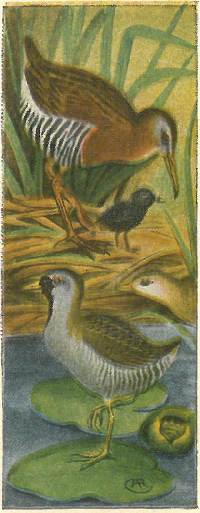
Back handsomely patterned with black, olive-brown and gray; wing coverts grayish brown, neck and breast cinnamon brown, brightest on the breast. Sides sharply barred with black and white; chin and line over the eye white, side of head slaty color. Like others of this species, it is found in either the fresh or salt marshes, but more abundant in the fresh.
Nest.—Of grasses on the ground or in tufts of rushes; eggs of a creamy white spotted and blotched with brown and lilac; six to ten are the number laid (1.25 × .90).
Range.—North America, breeding from British Columbia to southern California and the Gulf of Mexico.
Adults with throat and face black; young with no black on the head. Unless disturbed they pass the greater part of the day in quiet and do most of their feeding after dusk, when their clucking notes may be heard all over the marshes.
Nest.—A rude structure of grass in the rushes; 6 to 16 eggs, buff colored with reddish-brown specks (1.25 × .90).

This is a very handsome species, with plumage of glossy brown, yellowish buff; black and white barred side feathers. The back is blackish with the feathers edged with white. These small Rails are like field mice, hard to locate or obtain sight of when in the marsh grass. They object to flying unless forced to do so, and trust to their small size and their agility to get through rushes to avoid being seen.
Nest.—Is placed on the ground and made of grass woven and twisted together; the six to twelve eggs are rich buff color, specked with reddish brown in a wreath about the larger end (1.10 × .80).
Range.—Locally distributed in temperate America from southern California to British Columbia.
This is the smallest of the Rails. A dark slaty colored bird, with back a dark brown thickly spotted with white, gray feathers on the sides and flank spotted and barred with white.
Nest.—These are woven of strips of rushes and grass, nicely cupped to hold the eggs, which number from six to twelve; creamy white, specked all over with reddish brown (1.03 × .75).
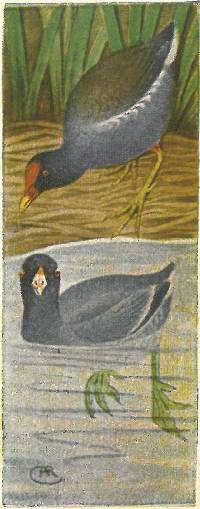
Plumage gray, changing to blackish about the head; the back a brownish color. Bill and frontal plate bright red, the former being tipped with yellow, legs greenish with a red ring about the top. The grayish side feathers tipped with white at the wing and lower ones with black. They have an almost endless variety of notes; all of them harsh and explosive.
Nest.—They build in colonies in the marshes, making their nests of rushes and grasses woven together and attached to stalks of rushes quite often over the water. They lay from six to ten eggs of a creamy buff color (1.60 × 1.15).
Head and neck nearly black, shading into a gray over the whole bird. Toes lobed and scalloped along the edge; bill white with a blackish band near the tip; shield narrow and brownish, ending in a point.
Nest.—This is placed in the same localities as are the Rails, and they have the same retiring habits. Six to fifteen eggs of a grayish color finely specked all over with black or brown (1.80 × 1.30).
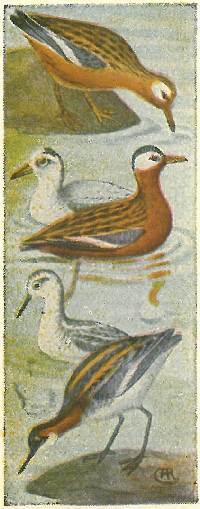
These birds are very rarely seen in the United States in their breeding plumage; when they come in the fall nearly all have changed to their winter dress, and they retain this until after they leave us in the spring. In summer the under parts and neck a reddish brown; sides of the head white; top of head blackish; wings bluish gray crossed by a white band. The female is the larger and brighter plumaged bird.
Nest.—A hollow in the ground, lined with a few grasses. Three or four eggs greenish buff color, spotted and blotched with brown or black (1.20 × .80).
Range.—Northern hemisphere, breeding in the far north, and in winter migrating to middle portions of United States on both coasts.
This is a maritime species that nests in the far north, and appears on the coasts a short time during migration. Like the last they are expert swimmers, and pass most of their time when not breeding upon the surface of the water. They feed upon minute insects secured from beds of floating kelp. Nest and eggs similar to above.

This is the most handsome species of the family, being of a very graceful form, of a grayish and white color, with a broad black stripe through the eye and down the side of the neck, where it changes gradually into a rich chestnut color. Bill is long and slender. It is a bird of the interior, and is only rarely met with on the coasts. It does not congregate in large flocks, as the two preceding, and is not as often seen upon the water, although a good swimmer.
Nest.—Made of grasses on the ground, usually concealed in a tuft of grass near the border of a marsh or pond. Three or four greenish-buff eggs with black markings (1.30 × .90).
Range.—Interior of North America, breeding from Canada to southern California and inland to Colorado and Dakota.
This species to a great extent frequents the open marshy meadows with its winding brooks. They procure their food by boring in the muddy banks of the meadows, the tip of the bill being flexible.
Nest.—On grassy edge of ponds or marshes; 4 eggs (1.50 × 1.10).
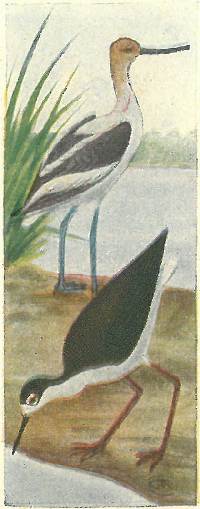
In summer the head and neck are pale cinnamon color; young birds and winter adults have the head and neck white. Feathers on the under part white and very thick and, duck-like, being impervious to water. Bill slender and recurved; feet webbed. Large patches of white on the wings, making them very conspicuous at all times. During the breeding season, if not molested, they become very tame.
Nest.—Is simply a lining of grass in a slight depression in the ground. They lay three or four eggs of a dark greenish or brownish buff color, spotted and blotched with brown and black (1.90 × 1.30).
Legs extremely long and bright red; neck and bill moderately long and slender. Male black and white as shown; female and young with back brownish. They are strong and swift upon the wing.
Nest.—On the ground, made of weeds, twigs and grass. Three or four eggs, greenish buff, with numerous markings of brown and black about the larger end.
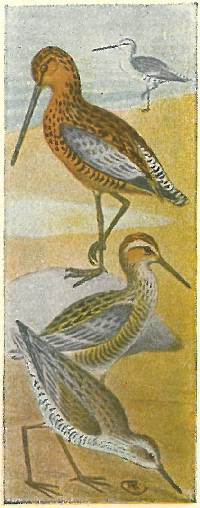
Bill very long like that of the Snipe. In summer these birds are reddish brown below; more or less specked with black on the breast and barred with black on the sides; above mottled with brown and black, lighter or even white on the rump, crossed with wavy lines of black.
In winter they are gray above and white below. By the gunners known as “Red-breasted Snipe” in the spring and summer and as “Graybacks” in the winter months.
Nest.—Placed in a slight hollow on the ground and lined with grass and leaves; three or four eggs of a greenish buff color boldly marked with brown most heavily about the larger end (1.75 × 1.15).
These seem to be one of the least abundant of our shore birds, single individuals being found in flocks of other species rather than in flocks by themselves. Bill slender and only moderately long. In summer the entire under parts are a rusty white, closely barred with blackish. In winter they are gray above and white below.
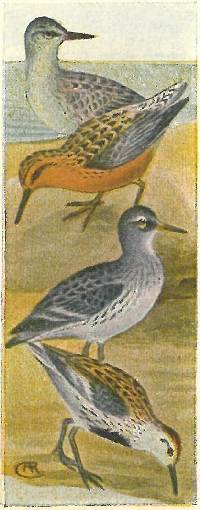
This is one of the birds that feed along the ocean beaches, following out each wave as it rolls away and eagerly picking the small insects from the sand, and hurrying back to get clear from the next wave. Bill moderately long and quite stout; form more robust than most of the shore birds. Adults in summer mixed with brown and grayish above and of a reddish uniform brown below. In winter plain gray above and white below.
Nest.—They are supposed to breed in Arctic America, but no eggs are known as yet in any collections.
Range.—Arctic regions in summer; in winter south through the United States to South America.
This bird has the feathers of the upper parts edged with rusty and the under parts light, with a distinguishing patch of black on the breast. Three or four eggs of a grayish buff color, spotted and blotched with brown, laid on the ground in a depression with a light lining of grass (1.50 × 1.05).
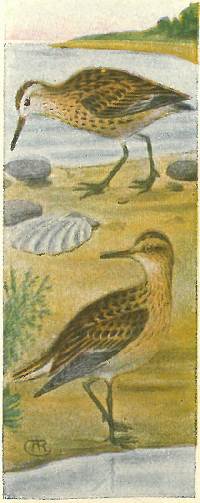
This species is blackish-brown above, feathers strongly edged with reddish brown, white below except the breast, which is reddish brown. Fairly common in summer on the coast of Alaska; in winter supposed to migrate south wholly on the Asiatic side of the Pacific.
A peculiar species, having the power during the mating season of inflating the throat to a great extent. They have more the habits of the Snipe than do most of the Sandpipers, frequenting grassy meadows or marshes, and feeding along the muddy flats in place of the sandy beaches. They are very dark brown above, with much lighter brown edging the feathers, and are white below and on the throat; the breast is brownish. These are well-known birds, and are called by gunners “Grass Snipe” or “Jack Snipe” as a more common name.
Nest.—Are grass-lined depressions, in which are laid three or four grayish or greenish buff eggs (1.45 × 1.00).
Range.—Whole of North America, breeding in the Arctic regions and wintering south of the United States.
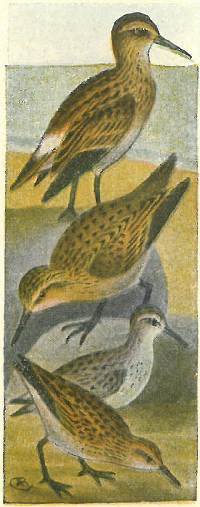
Back, wings and top of head brownish streaked with black, below white, but with the breast and throat streaked; primaries black; upper tail coverts white. Nesting habits the same as those of the majority of the family, breeding from Labrador northward, and wintering to Central America. Eggs 1.30 × .90.
Very similar to the preceding, but without the white rump, being of a blackish color instead.
Nest.—In the grass bordering fresh water ponds rather than near the seashore. Their nest is a slight hollow in the ground lined with grasses and usually concealed in a bunch of grass. Three to four eggs of a grayish white marked with shades of brown and lilac (1.30 × .90).
This is the smallest of the family; except for size they are the same in color and markings as the preceding. Found more on the seashore. Nesting habits and eggs are the same as the two above.
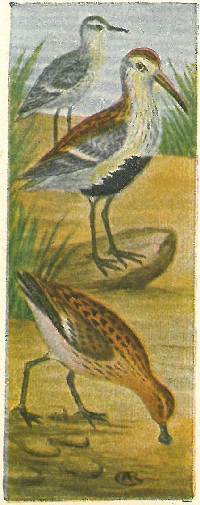
Bill slightly decurved and rather stout. Adults in summer, with the upper parts largely bright chestnut, spotted with black; belly black; head, throat, breast and sides strongly streaked with black.
In winter, dull brownish-gray above and white below, with the breast washed with grayish and slightly streaked with dusky. These small birds are found in large flocks both on the Atlantic and Pacific coasts, during migrations, but rarely in the interior. Their flight is very rapid and performed in compact flocks, that act as if governed by one impulse.
Nest.—Usually built on dry grassy knolls, a hollow in the earth being lined with a few dried grasses; they lay three or four eggs with a greenish or brownish buff color, heavily spotted and blotched with shades of brown and chestnut (1.40 × 1.00).
A very rare Asiatic species, which is taken in Alaska. It is a very peculiar bird, having the end of the bill broadened and flattened into a sort of spoon shape.
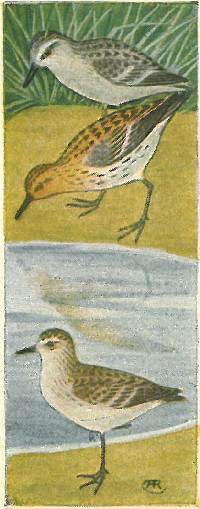
These are a handsome and abundant species, found during migrations by thousands. On the coast it is one of the boldest of the shore birds, feeding on the edge of the outer beach, often under the combing crest of the incoming waves, retreating just as the wave breaks and is dashed to foam on the beach. They are usually very shy, and will not allow a close approach. Toes are short and stout; no hind toe. Adults in summer, variegated above with bright reddish brown and black. In winter, plain grayish above and white below.
Nest.—The three or four greenish buff eggs, spotted and blotched with brown, are laid in nests that differ but little from others of this family (1.45 × .90).
Range.—Found in all parts of North America, breeding within the Arctic Circle, and wintering to southern California.
Their appearance is very similar to the Least Sandpiper, but they are slightly larger and the feet are partially webbed. Their nesting habits are the same, and eggs are very much alike.
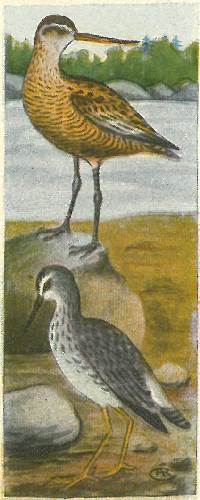
These large waders are found in moderately large flocks both in the interior and on the coast in the fall. They are like large Plovers, with long, slightly upcurved bills. Back, wings and tail rufous barred with black; rump white.
Nest.—Their eggs are laid upon the ground, sometimes there is no lining to the nest, and again a few grasses may be twisted about the depression. Three or four eggs with a ground color of grayish buff, sometimes quite dark, are blotched with dark brown (2.25 × 1.60).
Head and neck streaked with gray and white; back dark gray margined with white; rump white; tail barred black and white; primaries black; bill long and rather slender; legs long and yellow.
Nest.—The eggs are laid in a depression on the ground with very little attempt at nest building. Three or four eggs, grayish white, heavily blotched with shades of brown and lilac (1.65 × 1.25).
Range.—North America, breeding in the British Provinces.
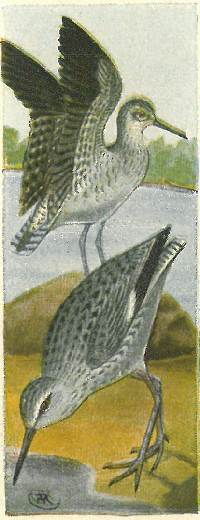
A bird with a greenish gray back, barred with buff, and white below. These are almost always met with in pairs or singly, and are very rarely seen even in small flocks. They prefer small ponds or streams in wet woods or open meadows, rather than marshes, which are frequented by other species. As their name signifies they are inclined to be alone.
Nest.—Is usually well concealed in a clump of grass, near some small piece of water, and is only a slight hollow with very little lining of grasses. Three to five eggs are clay colored, spotted with dark shades of brown (1.30 × 1.00).
These breed in small colonies in the marshes in central Oregon and northern California, and are quite abundant in many localities. Upper parts a brownish gray, specked with black; under parts lighter gray, with lighter streaks of darker gray. Primaries white at the base and black on the outer end.
Nest.—Is placed upon the ground secreted in clumps of grass just barely out of reach of the water. Three or four eggs; buff blotched with umber (2.00 × 1.50).
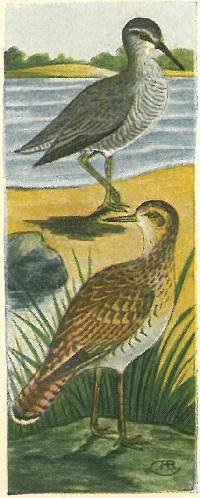
This is a handsome species, uniform gray above and white below, closely barred (in summer) with blackish, the bars becoming broken on the throat, forming spots. In winter the under parts and throat are white. During the breeding season it is found on the coast and islands of Alaska, building its nest along the marshy shores and banks of streams.
This is a bird of the hillsides or prairies, seldom being found near the water, their food consisting more of insects and worms than is usual with others of the Plover or Sandpiper families. They are quite shy, and are one of the birds much hunted for the table. Upper parts almost black, with feathers all edged with buff, giving them a very mottled appearance. Black on top of the head; neck light buff, streaked with black; under parts white.
Nest.—Usually placed in fields of grass, in slight hollows of the ground, lined with grass. They are frequently made and eggs deposited in good mowing fields just about the time for cutting the grass, and many nests are destroyed at this time.

Above, brownish black; each feather edged with buff; under parts buff, as are also the neck and head; blackish spots on the sides extending up the back of the neck and top of the head; primaries black.
Nest.—Placed in tufts of grass or in open fields; nest scantily lined with grass, in which three or four eggs, having a grayish white ground color, spotted with rich brown and chestnut, are placed.
Range.—Interior of North America, breeding from the Hudson Bay region to the Arctic coast. During migration, casual on the Pacific coast, and abundant in the interior, to South America.
This is one of the most abundant of all the shore birds, covering the whole United States. Its note, “peet-weet,” is a familiar sound to every bird observer. It has a peculiar habit of continually moving its tail up and down when at rest or when running along the shore, which has given it the name of “Teeter-tail” or “Tip-up.”
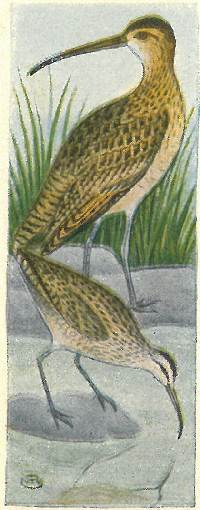
These birds, “Sickle-bills” as they are often called, are one of the largest of our shore birds. They are very conspicuous when in flight, or walking on the marshes or sandbars, their size appearing gigantic when in company with a flock of smaller birds, as sometimes happens. They feed both on the marshes and in shallow water, their food consisting of insects and small crustaceans, the latter which they pull from their holes in the sand with their long curved bill. They fly in compact flocks, evidently led by one leader, for they wheel and circle in perfect unison.
Nest.—Their nests are placed upon the ground, in meadows or on the prairies, and three or four eggs are laid of a greenish buff color, covered with numerous spots of dark brown (2.50 × 1.80).
This is more grayish than the above; primaries black; a white stripe along the top of the head; is fairly common, winters in California. Three or four eggs, same color as above, only smaller (2.25 × 1.60).
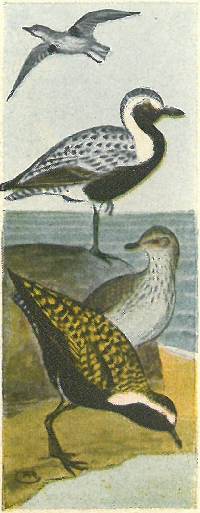
A remarkably handsome species when in their summer dress. The upper parts are largely white, with black spots and bars on the back, wings and tail; the sides of head, throat, breast and fore under parts are black. This species has a small hind toe. In winter they are brownish-black, somewhat mottled above; below, dull white. This is a very familiar bird to sportsmen, and is known better by the name of “Beetle-head” or “Bull-head.” They are very numerous in the fall.
Nest.—Is made as usual with the Plover, without much lining and placed in a tuft of grass; three or four eggs, brownish-buff in color and boldly marked with black (2.00 × 1.40).
The black of the under parts extends to the lower tail coverts, and the upper parts are variegated with black, golden yellow and white. These are often found in large flocks with the above, especially in the fall, during migration. The habits are also the same.
Nest.—Abundantly along the coast of the Arctic ocean, on the mainland and also on the islands. Three to four eggs (1.90 × 1.30).
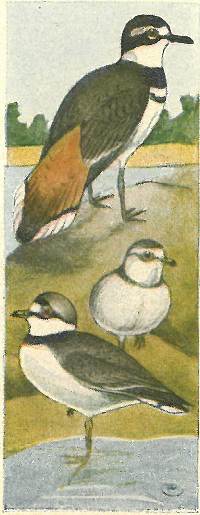
Next to the Spotted Sandpiper this is one of the most commonly known of the shore birds throughout the United States. They are very noisy, continually uttering their note of “Kil-deer—kil-deer,” from which they take their name. Rump and base of tail reddish brown; with a black line across the tail near the end; the two central feathers black to the end, the others white at the end. Breast crossed by two bands of black; a white forehead, and white streak back of the eye.
Nest.—Is placed on the open ground, with a few pieces of grass for lining. The four drab-colored eggs covered with dark brown spots are usually placed in the nest with the small ends in the center (1.50 × 1.10).
The “ringed” plover is smaller than the above but one black band across the breast; black line from base of bill to eye and up over the top of the head. Forehead white. Abundant along the shores.
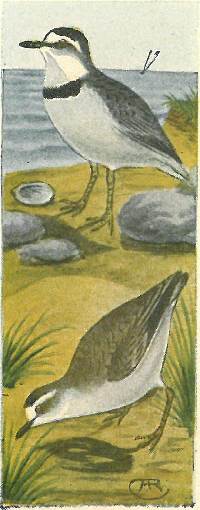
A very common Plover, which may be distinguished from the preceding by the much heavier bill; it has no black on top of the head and white on the forehead extends back behind the eye; the black band across the breast is heavier and does not extend around the back of the neck.
Nest.—Is usually placed on pebbly “shingle” or back in the marsh grass on the bare ground; eggs are olive gray, scratched all over with markings of brown and gray (1.40 × 1.05).
Range.—Abundant on the Gulf Coast and of Lower and southern California.
A peculiar species, inhabiting even the driest portions of the western prairies and plains even at high altitudes. It is more quiet, and seems to be less aquatic than any of the Plovers, and is rarely found in the vicinity of the water.
Nest.—Placed on the bare ground in a simple hollow are four eggs, brownish gray, spotted and blotched with shades of brown (1.50 × 1.10).
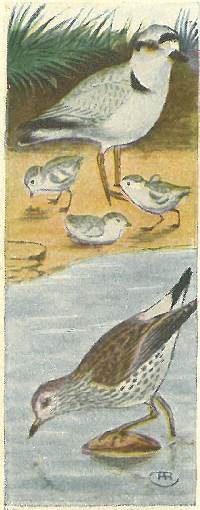
This is the palest of the Plovers, and one of the smallest. A small black crescent-shaped patch on either side of the breast; a black spot under and back of the eye, and one also on top of the head. They are about the color of the dry sands of the beach, and the young when hatched and running about resemble a small bunch of cotton being blown about on the beach.
Nest.—A simple hollow in the sand placed just above high water, lined with pieces of broken shells. The eggs are about the color of the sand and it is almost impossible to see them a few feet away. Four eggs, clay colored; very lightly marked with fine dots (1.20 × .90).
Range.—Breeds along the Pacific coast of the United States. Winters from California to South America.
This species, which is found on the Pacific coast, from Alaska to South America, seems to be the connecting link between the Plovers and Turnstones, having the habits of the latter combined with the bill of the former.
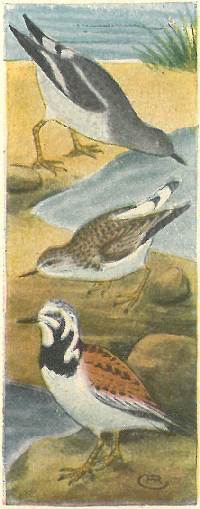
Upper parts a greenish black color; head, neck, breast and throat black; a white spot in front of eye and on forehead; under parts white.
Nest.—In the far north on the shores of Alaska and more northern islands, laying their sets of four eggs in hollows with a few grasses for lining; the eggs are light gray, marked with various shades of brown and lilac (1.60 × 1.10).
Range.—Pacific coast of North America, wintering to Lower California.
This species has the upper parts variegated with reddish brown, black and white; the under parts are pure white with a wide black band across the breast, as in illustration. It has a peculiar, slightly upturned bill, which is used, as the name implies, for turning over pebbles and stones in their search for food. From the coloring the bird is known as “Calico-bird,” “Checkered Snipe,” etc.
Nest.—About Hudson Bay and Alaska; eggs laid in a hollow in the ground near water. Four eggs (1.65 × 1.10).

The plumage on this bird is entirely black, with a bluish wash on the upper parts, and brownish black below. They are found upon the rocky coasts and islands more frequently than on the sandy beaches. Their eggs are laid upon the rocks or small pebbles with no attempt at nest building; three or four eggs are laid of an olive buff color spotted and blotched with shades of black and brown (2.20 × 1.55). Found on the Pacific coast of North America, from Lower California to Alaska.
This is very similar to the American Oyster-catcher; possibly having the colors a little darker on the back. Bill very long, heavy, compressed, and thin and chisel-like at the tip. Bill and eyes red; legs flesh color; under parts white, and a white wing bar. These are large, awkward looking birds, and are not uncommon in their somewhat restricted range in Lower California.
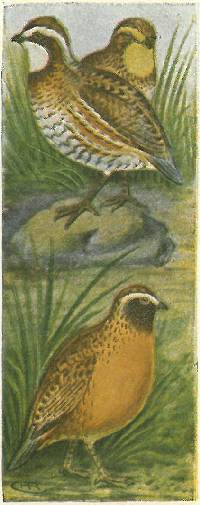
This is one of the most celebrated of the “Game Birds,” or best known. Throughout New England it has been so persistently hunted that it is getting to be a rare bird; it gets to be more common as we go south as far as Florida, and through the middle west. It has been introduced in many places on the Pacific coast, and now is fairly abundant in parts of California, Oregon and Washington. They feed largely upon insects and grain, and about the grain fields is where they are mostly found.
Nest.—These are built along the roadsides or beside stone walls or any dry locality affording good shelter. It is concealed in the tall grass or weeds, and arched over with grass. They lay from ten to twenty pure white eggs. Often two broods are reared in a season (1.20 × .95).
This handsome species is marked similar to the “Bob-white” on the upper parts, but has a black throat, and the rest of the under parts are of a reddish brown.
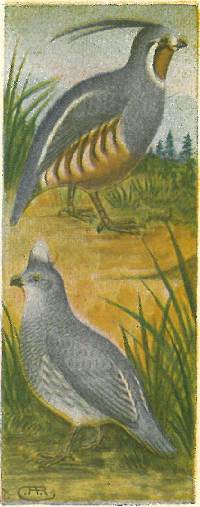
This is a beautiful bird, with its long black crest and rich coloring. Upper parts an olive brown; the top of the head a rich gray. Throat and sides a beautiful shade of chestnut, with wide bands of black and white on the sides; breast a clear gray. Female very similar to the male, but not as brightly marked and with a shorter crest.
Nest.—These birds nest abundantly in the mountainous region of northern California, and in Oregon, and gradually increasing more northerly. The nest is placed on the ground under bush or grass for protection. Eight to fifteen eggs of a pale reddish buff color are laid (1.35 × 1.05).
This is a bluish gray colored bird nearly all over. The feathers on the neck and under parts have narrow dark borders, which give the appearance of scales, from which the bird is given its name. They have a small tuft of whitish or buffy feathers on the top of the head.
It is especially abundant in the dry arid portions of its range, being found often many miles from water.
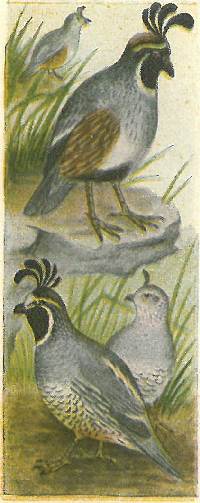
With its crest of black feathers rising from the crown and curving forward so that the broadened ends hang directly over the bill, this is one of the most beautiful of the family. Upper parts a grayish brown, with buff stripes along the sides of the back; throat black, bordered with white; under parts white, with feathers edged with black, making a shell marking, and having a chestnut patch in the center; breast gray.
Nest.—Usually concealed in a brush pile or in the grass; ten to twenty eggs; of a creamy white or buffy ground color, handsomely blotched with brown of varying shades (1.20 × .93).
Head with an elegant recurved crest of six or seven feathers; normally these are carried as one feather, so closely do they nest together, but when excited or during the mating season, they may separate the feathers, or sometimes curve them forward so as to touch the bill. Hindhead and sides chestnut, the sides with white or buff streaks; the middle of belly black.

These strange birds are very local in their distribution in the southwest, rare in some localities and quite abundant in others. They are so confiding in their disposition, that this, in connection with their clownish plumage, has given them the name of “Fool Quail.” The bill is very stout and compressed; crest large, puffy and flat. They frequent dry deserts, valleys or mountains to quite a high altitude. Their eggs, which are pure white, are not distinguishable with certainty from the Bob-white, possibly average a little longer (1.25 × .90).
Plumage gray, white and black; darkest on the back and tail, which is margined with a light gray. Female smaller, browner and more barred above. Like the Ruffed Grouse, during the mating season, the males of this species strut with tail fully spread over the back, and head thrown back until it nearly touches the tail.
Nest.—They build their nests under fallen trees or at the base of standing ones. They lay from six to ten eggs of a buff color, spotted and blotched with shades of brown (2.00 × 1.40).
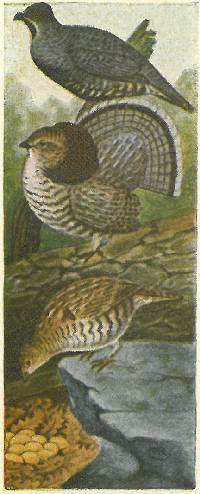
Upper parts dark gray, marked with black bands, and narrower bands of lighter gray; tail feathers black to the tip, with the upper tail coverts strongly barred with white; tail having sixteen feathers. Like the preceding these birds are at home in the dense evergreen forests. It is very similar to the eastern bird, the Canada Grouse, and has the same local name given it from its unsuspicious nature, of “Fool-hen.”
Nest.—Is placed on the ground under logs or low branching fir trees, and from eight to fifteen eggs are laid. These are brownish buff in color, spotted and blotched with rich brown (1.75 × 1.30).
A darker form of the eastern variety, the under parts being more heavily marked with brown. Found in the northern United States and southern British Provinces, from Maine and Nova Scotia west to Oregon and British Columbia. Eight to fourteen eggs of a brownish buff color (1.55 × 1.15).

These are Grouse-like birds, feathered to the toe-nails; they have many changes of plumage, in winter being nearly pure white and in summer largely reddish brown, mottled and barred with black. This bird has a black tail and bill, the latter very stout. In the breeding plumage they have a bright red bare spot over the eye.
Nest.—They nest on the ground in hollows of the rocks filled with moss, lining the nest with leaves and grass, and sometimes a few feathers. They lay from six to sixteen eggs, which have a ground color of buff, heavily speckled, blotched and marbled with blackish brown (1.75 × 1.25).
This is somewhat smaller than the above, with a smaller bill, and in summer the plumage is more gray than brown. Its nesting habits are the same as the others; eggs slightly smaller (1.70 × 1.20).
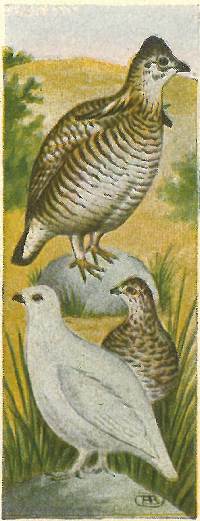
This is the most familiar game bird of the West; brownish above and white or buff below, with broad black bands on the back and finer black lines on the under parts. In place of the ruffs on a grouse are long tufts of rounded or square ended feathers, and below these a peculiar sac; bright orange in the breeding season, and capable of being inflated to the size of a small orange; this is done when the bird makes its familiar “booming” noise. They are one of the best “table birds,” being of good size and excellent flavor.
Nest.—In hollows on the ground in the cover of tufts of grass; they lay from eight to fifteen eggs, having a buffy ground color, finely sprinkled with brown spots (1.70 × 1.25).
Found in the higher ranges of the Rocky Mountains, from Colorado north to Alaska. This species differs from any of the preceding in having at all seasons of the year a white tail; it is also somewhat smaller than the Rock Ptarmigan. From six to twelve creamy white eggs; speckled and blotched with chestnut brown (1.70 × 1.15).
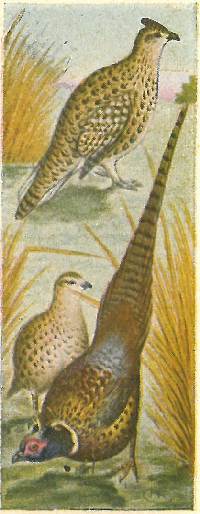
These have no pinnates or ruffs on the neck, but the head is a little more crested than that of the Prairie Hen. The tail has the central feathers nearly two inches longer than the others, which are also graduated so that the outside ones are much the shortest, and are lighter in color than the central ones. It is not barred like the former, but the black markings on the back and under parts are more in the form of crescents. It is also much lighter in general color.
Nest.—They are usually concealed in thickets or tufts of grass and contain from six to fourteen eggs of a drab color, finely dotted all over with dark brown (1.70 × 1.25).
Range.—Northwestern United States and British Columbia to central Alaska.
The male of this beautiful Pheasant varies greatly in length according to the development of the tail, it sometimes being 36 inches long. These birds have been introduced in Oregon and Washington, as well as in many places in the East, and are becoming very abundant.
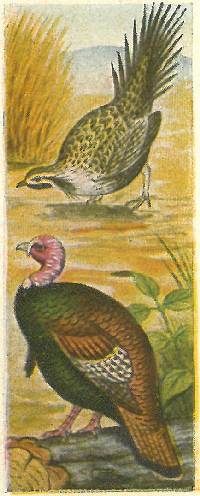
The female of this large and interesting Grouse differs from the male only in its smaller size and paler plumage. They are found in abundance on the dry sagebrush covered plains about the Rocky Mountains and to the westward. In fall and winter their food consists almost entirely of the leaves of the sagebrush, their flesh being unfit to eat at this season. In the mating season they indulge in the usual antics of the grouse family. They have the same peculiar sacs on the sides of the neck which they inflate so that the whole neck is a small orange colored balloon, at the same time spreading their long pointed tail feathers to their fullest extent, and strutting about after the manner of the turkey.
Nest.—Are shallow hollows in the ground, under, generally, a sagebush or some protection to cover the nest; six to twelve eggs of a greenish drab color, spotted with brown (2.15 × 1.50).
Female much duller and smaller than the male. The plumage is a coppery bronze color and their upper tail coverts are a dusty color with no white edges. 8 to 16 eggs; buff spotted with brownish (2.55 × 1.90).
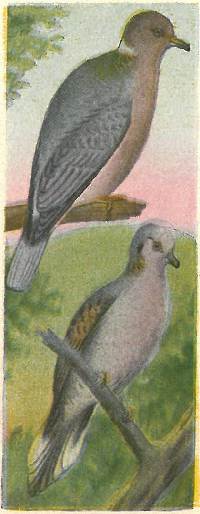
This large species may be recognized by the white crescent on the back of the neck, by the broad gray band; bordered with black at the end of tail. Back, near the neck, brownish shading into a gray nearer the tail. Head and neck of iridescent colors, very changeable in different positions. They are very abundant on the mountain ranges, sometimes in immense flocks. They feed on grain, wild berries and acorns, and are found mostly in the oak and pine woods.
Nest.—Is a rude platform of sticks, just enough to barely keep in place the single white egg (rarely two) which they lay (1.55 × 1.10).
Range.—The Rocky Mountains and westward to the Pacific, from British Columbia to Mexico.
Now that the Passenger Pigeon has become extinct, this is the only one to be found nearly all over the United States, and is common in the southern, central and western parts. Nests are placed at low elevations in the trees. Two white eggs (1.15 × .80).
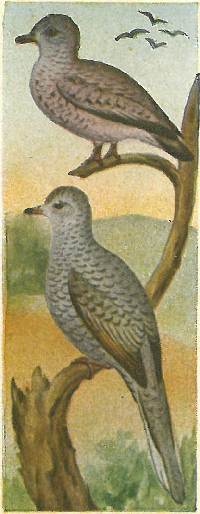
Size very small; tail short and nearly square; back of head and under parts with breast a pinkish gray, with feathers tipped with black, giving a scaly appearance; back brownish gray, faintly barred; several black spots on wing coverts.
Nest.—Is made of weeds and twigs, placing the flat, frail structure either in bushes or on the ground, in which are placed the two white eggs (.85 × .65).
Range.—Border of the United States, from Texas and southern California southward.
Tail is longer than preceding and more rounded, and the outer feathers are tipped with white. Head, neck and whole body of a pinkish gray; scaled as is the former. These are very tame, and are to be met with in the roads, barnyards, and seem to be almost domesticated in their habits, even feeding with the poultry about the farmhouse.
Nest.—These are rather more compactly made, of twigs, rootlets and weeds, and placed near the ground in low bushes; only two white eggs are laid (.85 × .65). Not as common as the previous.
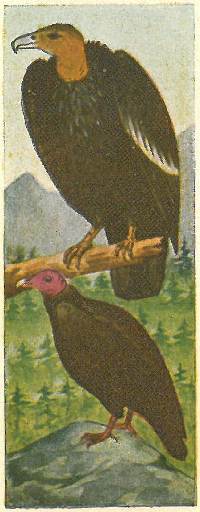
The largest of the Vultures, with an extent of about ten feet, and weighing twenty pounds or more. Its plumage is blackish, with lengthened lanceolate feathers about the neck. Head and neck without feathers and of an orange color. Wing coverts grayish, tipped with white in adult birds. The birds are very rare in their restricted range, and becoming more so each year, owing to their being shot and the nests robbed. While the eggs are but rarely found, and obtained at great risk, they are not as unobtainable as many suppose.
Nest.—They lay but a single egg, placing it generally in caves or recesses of the rocks in the face of cliffs, hundreds of feet from the ground; ashy gray in color (4.45 × 2.55).
The plumage of this bird is darkish brown, the naked head being red. It is very common in the southern and central portion of its range, where it may be seen about the streets and dooryards picking up any refuse that may be edible. It is a graceful bird upon the wing, and can readily be identified at a distance by the upturned ends of the wings.
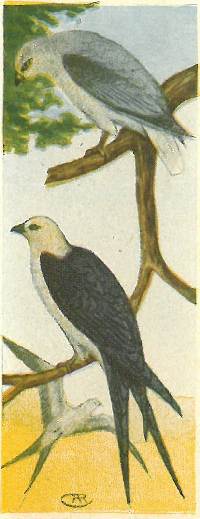
This species may be recognized by its light bluish gray mantle, black shoulders and white tail. It is a very active and graceful bird, feeding upon insects and reptiles, and small birds and mammals.
Nest.—Is usually made of sticks, weeds and leaves, placed well up in oaks or in willows beside the rivers. The eggs are creamy white, profusely blotched and spotted with reddish brown (1.65 × 1.25).
This most beautiful Kite can never be mistaken for any other; its whole head, neck and under parts are snowy white, while the back, wings and tail are a glossy blue black, the tail being long and deeply forked; feet short, but stout; bill black, with cere and feet bluish gray.
Nest.—As a rule is placed in the tallest trees, live oaks or pines, and is made of twigs which it picks from the ground while in flight, lining the nest with rootlets and moss; two, or rarely three eggs, bluish white, spotted with brown (1.80 × 1.50).
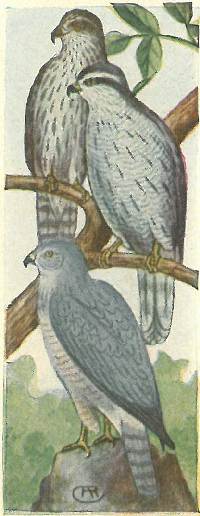
This is one of the largest, strongest, and most audacious of the American hawks, frequently carrying off grouse and poultry, the latter often in the presence of the owner. It is a handsome bird, in the adult stage, and as graceful in flight as in appearance. Adults, above, bluish gray, darkest on the crown; a white line over the eye; below, white streaked with blackish brown; tail with four black bands, and very long.
Nest.—Is usually placed in the tallest trees in deep forests, and is made of sticks, lined with twigs, leaves and grass; three or four eggs, bluish white, usually unmarked (2.30 × 1.70).
The adults of this species are very light colored; bluish gray above and white beneath. Young birds of the first two years are brown, much lighter on the under parts. In both the old and young they have a large white patch at the base of the tail. Nest is made in and on swampy ground; four to seven eggs; white (1.80 × 1.40).
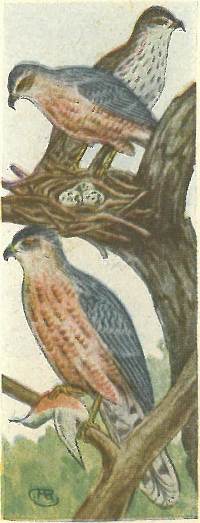
This little hawk is one of the most active of the family, and from this fact it gets its name (Velox), meaning swift. It is often seen in woods, orchards or even in large cities, in which latter place it does good service in catching English sparrows. They also eat a great many mice and meadow moles. It is one of the most daring as well as beautiful of the small hawks.
Nest.—It is a rude and very frail platform of twigs and leaves placed in the crotch of a tree, usually at about fifteen feet from the ground, sometimes higher. Three white eggs, blotched with brown.
The markings of this bird are the same as the preceding and its larger size is the only difference. Also like the last this is a very destructive species to the small birds and chickens. Their nests are placed in taller trees at higher elevation from the ground than the former, and built in the same manner. Three bluish white eggs unmarked or faintly specked with brown (1.90 × 1.45).
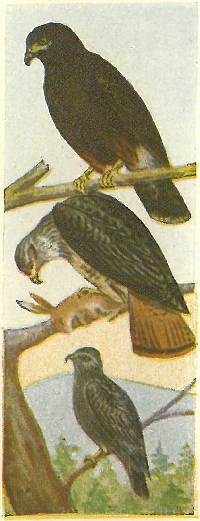
This is a peculiar dark colored species; black under parts; lighter on the back; shoulders, thigh and under-wing coverts reddish brown; tail coverts, base and end of tail white. Bare space in front of eye, except for stiff hair like bristles, yellow, as is also the cere.
Nest.—Are made of twigs and weeds and placed usually in low trees. The three or four eggs are a dull white in color, faintly specked with a few spots of brownish (2.10 × 1.65).
Range.—Southern California, Arizona, Texas and New Mexico.
This bird varies greatly in its coloration; from the same as the eastern form to a sooty color above and below, with the dark red tail crossed by several bands, where the eastern bird has only one broad band.
Nest.—Placed for choice in evergreen trees at heights from the ground varying from 30 to 50 feet. Two to four eggs, white, usually spotted and blotched with different shades of brown (2.35 × 1.80).
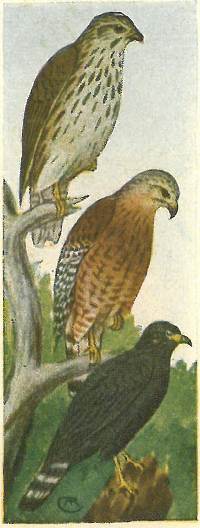
These birds are darker in color than the Red-shouldered Hawk of the East, and in their habits very much resemble the Red-tail; for food they prefer the large variety of small rodents and rarely disturb poultry or birds. The under parts are a bright reddish brown, without bars. They may be found covering the same territory as the Red-tail on the Pacific Coast west of the Rockies from British Columbia south to Lower California.
Nest.—Is made of twigs lined with rootlets and leaves and feathers. They lay from two to four eggs of a white color spotted and blotched all over with a light shade of brown and lilac (2.15 × 1.75).
This whole bird is black, with the exception of the tail, which has three wide bands of white and the ends of the tail feathers tipped with white. Like others of the Buteo family they feed almost entirely on the small rodents, which they find in abundance in the marsh and prairie, or in the low brush. Eggs, two to four, white, faintly spotted with light chestnut (2.15 × 1.75).
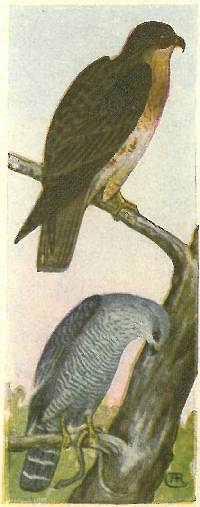
Their plumage is extremely variable, having all of the intergradations from a sooty blackish to the typical bluish gray above, and white below, with breast a rich chestnut color. Their habits are nearly as variable as their plumage. In some localities they nest wholly in trees; in others upon the ground or on rocky ledges. They seem to prefer, though, the low open lands covered with sage bush, where their food consists almost wholly of the small rodents; squirrels; mice and grasshoppers, the latter being eaten in large numbers.
Nest.—Is made similar to others of the family, laying two to four white eggs, splashed and spotted with various shades of brown, usually more about the larger end (2.20 × 1.70).
Range.—Western North America, from the Mississippi to the Pacific Ocean, and Hudson Bay to southern California.
Found in the southern borders of the United States and Mexico. These are graceful and active birds, feeding largely on small rodents.
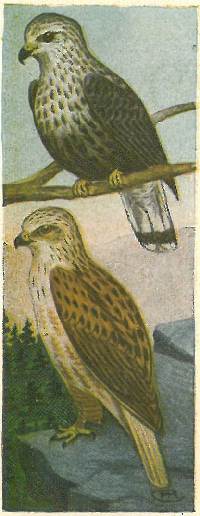
These are large, heavily built birds of prey, specially characterized by the completely feathered legs to the feet; in the normal plumage has a whitish head, neck, breast and tail, the former being streaked and the latter barred with blackish; remainder of upper and under parts, blackish brown. Eyes brown. In the dark phase they are blackish brown, more or less mixed with rusty, the tail remaining the same as in the light plumage.
Nest.—Is made of sticks and smaller twigs, lined with leaves and moss, placed in trees or more often on ledges. They lay three or four bluish white eggs, boldly blotched with different shades of brown, oftener about the larger end (2.25 × 1.75).
These are very much more of a reddish brown color than the last, on the back; head and breast is whiter, with fewer markings. Legs the same, feathered to the feet. It is much more abundant than the last and is a western bird wholly, breeding on the ledges, where its eggs are laid.
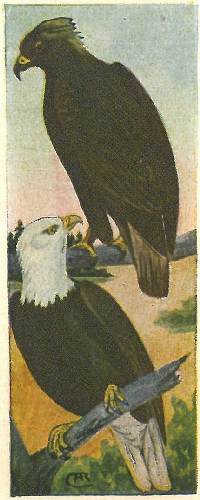
These may be distinguished from the Bald Eagle in all plumages by the completely feathered tarsus. Plumage blackish brown, adults having the lanceolate feathers on the neck of a golden brown color, and the tail more or less mixed with white.
Nest.—These are made up of large sticks, lined with smaller ones and moss, leaves and weeds, building quite a bulky affair. Their two or three eggs are very handsome, being white, speckled and spotted with shades of brown, and clouded with gray and lilac. They vary greatly in their markings (2.90 × 2.50).
Range.—West of the Mississippi, being most abundant in the Rockies and along the Pacific coast ranges.
In the adult birds, the white head and tail will always identify them, but in the first and second year they are a brownish black, the second year showing traces of the white on head and tail. They are found throughout the United States. Their food consists largely of fish.
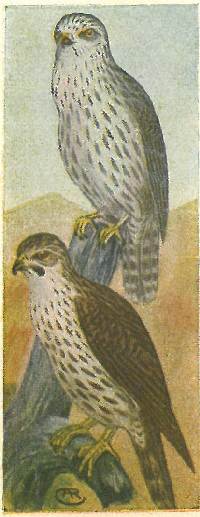
These are birds of the Arctic regions and are rarely taken in the United States even in winter.
Nest.—They build upon the ledges of high cliffs, laying three or four eggs of a buffy color, marked with fine spots and blotches of shades of brown.
This is quite an abundant species in some localities, and like the Duck Hawk in many ways is one of the most graceful, fearless and swiftest of the Falcons. A blackish patch on the sides of the throat; upper parts brownish with darker markings; under parts white, streaked with brown, much heavier on the flanks. Throat, clear white.
Nest.—Is generally placed on rocky ledges and cliffs, and sometimes in trees. Their nests are made of sticks lined with weeds and grass; three or four eggs of a reddish buff color, thickly blotched and sprinkled all over with reddish brown (2.05 × 1.60).
Range.—West of the Mississippi and from Dakota and Washington south to Mexico. Their food is mostly rodents secured on the prairies.
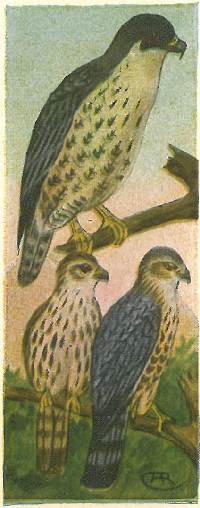
A most beautiful species, with a black patch, or moustache, on side of the throat from the bill; head and upper parts bluish gray with darker markings; under parts white, tinged with huffy on the lower part, and lightly barred with black, with the throat pure white. Their food consists mostly of ducks, which they always take while on the wing. It breeds abundantly on the Pacific coast and in some parts of Dakota on the rocky ledges.
Nest.—They are not home builders as a general thing, but lay their three or four eggs on the gravel or bare rocks of ledges or cliffs. The eggs are a reddish buff color, completely blotched and dotted with reddish brown. These are the darkest, brightest and the most beautiful of the Falcon eggs (2.05 × 1.55).
A small Falcon, similar to the Sharp-shinned Hawk, but a much darker and stouter built bird. It is a daring little fellow, and will attack birds much larger than itself. It feeds on small birds and mice.

Found in some of the more southerly states, Texas, Arizona, New Mexico and Central America. In habits it is very much the same as the following, getting its supply of food, consisting of small birds and insects, on the plains covered with the cactus and yucca, in which they build their nest of twigs, lining it with roots and grass, in which they lay three or four eggs, creamy white, strongly marked with shades of brown (1.75 × 1.30).
This is next to the smallest of the Falcons, the Eastern form being a trifle smaller. They cannot be mistaken for any other species, because of their bright color and markings as illustrated. Their flight will almost of a certainty identify them at a long distance, a few rapid wing beats, then a short sail, alternately. Their food consists of grasshoppers, mice and an occasional small bird.
Nest.—Is built in the cavity of some tree, either in the woods or open field. The eggs are placed on the decayed wood without any lining.
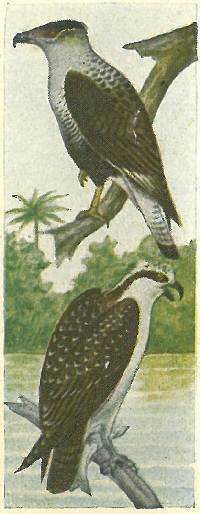
A strongly marked bird; black wings, back and under parts with neck pure white, excepting on the lower part, with many short bar-like markings. Upper part of head black, with feathers elongated, making a slight crest.
Nest.—Is a bulky affair, shabbily built of sticks, weeds and grass, piled into a promiscuous heap, generally located in bushes or low trees. Two or three eggs; brownish buff, with spots and patches of shades of brown nearly covering the under color. They vary very much in the coloration and markings from light to dark.
Range.—Southern borders of the United States.
Probably no fisherman in the United States is so well known as is this bird. It is one of the pleasantest sights along the coast to watch a number of these great birds as they soar at an elevation above the water, watching for a fish to come near the surface, when, with folded wings, the bird speeds downward and plunges into the water, rarely missing his prey. Three or four creamy white eggs, with spots of brown of different shades (2.40 × 1.80).

This is one of the lightest colored of the owls; it has a long peculiarly hooded face, from which it gets the name of “Monkey-faced Owl.” Its plumage is yellowish buff, with black spots over the breast and under parts.
Nest.—In most any situation out of sight, such as hollows in old trees, or in ledges, in barns or bell towers. It lays from four to six white eggs (1.70 × 1.30).
Range.—North America, but most common in the Gulf States and on the western coast.
This species has unusually long ear tufts, from which it is given its name; the face is brown, the under parts white and buff, with streaks and bars of brownish black; back is brown, with almost black markings; wings and tail brown; barred with black.
Nest.—Usually in trees, frequently using a crow’s nest instead of building for themselves. They are in great disfavor with the crows. They lay from four to seven pure white eggs (1.55 × 1.35).
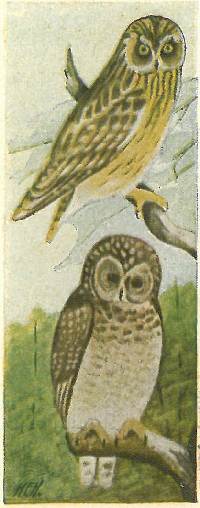
About the same size as the preceding, but readily identified from it by the short ear tufts and rounded head, and also lighter color. It is streaked on under parts and not barred. Tail is barred. Their flight is perfectly silent, which aids them in securing their prey of field mice and moles, which they usually get without stopping in their flight, just swooping down, and extending their long legs, armed with wicked little sharp claws, and it is all over with the little rodent, he being carried to a nearby stump and devoured, fur, bones and all.
Nest.—Is usually built upon the ground in marshy places, sometimes of grass and weeds, under some bush or near or under some log or stump. Four to seven pure white eggs (1.55 × 1.25).
This is very similar to the Barred Owl of the Eastern and Southern States, but spotted, instead of barred, on the back of the head and neck, and much more extensively barred on the under parts.
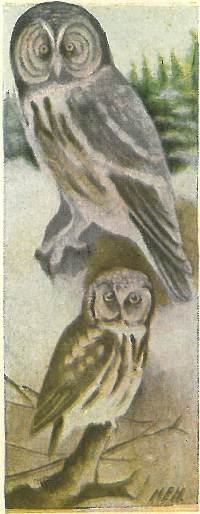
This owl in appearance is the largest of the family, but it is mostly in feathers, which are long and very fluffy. They do not weigh nearly as much as either the Horned or Snowy Owls. The plumage is dark gray above, mottled with white, and below is white with heavy streaks of brown. The facial disc is very large, and the eyes are small and yellow, while in the Barred Owl of similar appearance the face is much smaller, the eyes are larger and are bluish black in color.
Nest.—Is made of sticks and twigs, lined with leaves and moss. Two to four eggs; pure white (2.15 × 1.70).
Range.—In winter they are found quite abundantly in Minnesota and North Dakota, and occasionally in northern California and Oregon.
This bird is dark grayish and white, without ear tufts. Back and wings brownish, spotted with white; facial disc very light, with faint gray lines, and under parts light gray with brown streaks.

This species is similar to the preceding, but is smaller and more of a brownish color all over. It has no ear tufts. They are very quiet little birds, nocturnal in their habits, and cannot see well in the strong light, a fact that has allowed them to be captured by hand from their roosting places in the trees.
Nest.—They will usually select the hole of a woodpecker, in which to lay their four white eggs. Their eggs are laid and the young are hatched and out of the nests before the breeding time for woodpeckers, so that the same home may be occupied later by another family (1.20 × 1.00).
Range.—North America, breeding in the northern part of the United States and British Columbia, and wintering to southern California.
These may be found in two color phases, the red or gray with black and white markings. It is frequently called the “Little Horned Owl,” because of its ear tufts. They are easily tamed and become great pets, and about a barn are as good as a cat for catching mice.
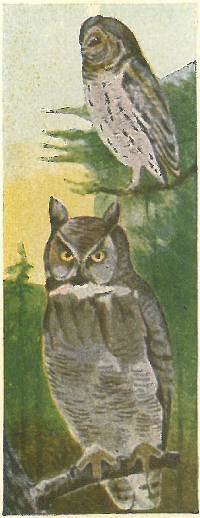
This is a trifle smaller than the two preceding, has shorter ear tufts, and the plumage is much streaked and edged with rusty. The toes are unfeathered to the base. The number of eggs and nesting habits are practically the same as the preceding, as are also the five or six sub-species between this and the last, all of which occur in the southwestern part of the United States.
These large birds are the most fierce and destructive of the family. They are powerfully built, and their size and strength allow them to attack and secure some of the larger animals, such as skunks, woodchucks, rabbits, grouse and poultry. They seem to be especially fond of skunks, and more than half of them that are killed will have unmistakable evidence of their recent and close association with this animal.
Nest.—Is usually in some large deserted nest, or in hollow cavities of large trees. Three or four white eggs, almost round (2.20 × 1.85).

Like the Horned Owls they are strong, fearless and rapacious birds, feeding upon hares, squirrels and smaller mammals, as well as Grouse, Ptarmigan and many of the smaller birds. They are locally abundant in the far north, preferring low marshy land to the more heavily timbered districts.
Nest.—Placed on the ground, on mossy hummocks on the dry portions of marshes, made of moss with a few feathers. Three to eight eggs, pure white, and the shell very smooth (2.25 × 1.75).
Range.—Arctic Regions of North America, and in winter casually as far south as California.
This owl, mottled and barred, gray and black, might readily be taken for a Hawk, because of his hawk-like appearance, and long rounded tail. They are very active birds especially in the day time, and they do most of their hunting in daylight rather than at night. Their food consists of small rodents and many small birds.
Nest.—In hollow trees or upon the ground. Four to eight white eggs (1.50 × 1.20).
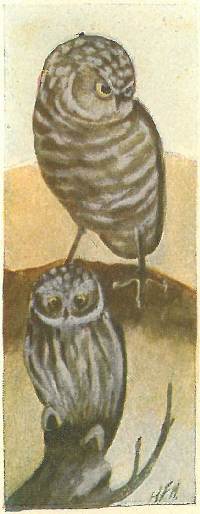
These birds are wholly different in plumage, form and habits from any other American Owls. Easily identified by their long, slender and scantily feathered legs. They are brownish above, spotted with white, and under parts are white spotted with brown. Tail dark brown, with five white bars across it. They are an abundant and useful species west of the Mississippi. They live in the same regions as the Prairie Dogs are found, and use the deserted burrows of these animals, or take them by force, for they are more than a match for these curious animals.
Nest.—Generally in quite large communities in burrows in the ground, usually lining them with grass and feathers. They may often be seen sitting at the opening of their burrows during the day time. Six to ten white eggs are laid (1.25 × 1.00).
These interesting little Owls, which are found in the Rocky Mountains, westward from British Columbia to Mexico, feed in the day time upon insects, mice and occasionally small birds. They are to be seen in the wooded districts. Nest in holes of trees. Four eggs (1.00 × .90).
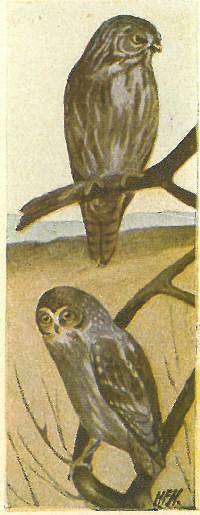
This is very similar to the last, but in color is much more rufous on the upper parts, and the tail is of a bright chestnut color crossed by several bands of black. They live largely on the small rodents and birds which they secure during the daytime. They nest in hollow cavities of trees, from ten to forty feet from the ground, laying four glossy white eggs (1.10 × .90).
This odd little bird is the smallest of the family found in America. In plumage it may be described as being very like a small Screech Owl, without the ear tufts, only with the pattern of the markings much finer. They are quite abundant in central Mexico and in southern Arizona, where they build their nests in deserted Woodpecker holes, or perhaps more frequently in the giant cactus. It differs from the preceding in being a bird of the night, rarely flying in daylight. They feed almost exclusively upon insects, and rarely a mole or field mouse. They lay from three to five white eggs, having a slight gloss (1.02 × .90).
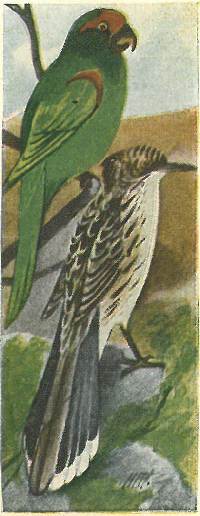
A Mexican bird, casually found north to the Mexican borders of the United States. It has a heavy, thick bill; black; and the plumage is entirely green, except for the deep red forehead and wings at the shoulder; under-coverts of wings yellowish. Their eggs are white and laid in natural cavities of trees in the deep forests.
This curious species is known as the “Chaparral Cock,” “Ground Cuckoo,” “Snake Killer,” etc. Its upper parts are a glossy greenish brown, each feather being edged or fringed with white. The tail is very long, broad and graduated, the central feathers being much the longest; the feathers being tipped with white. They are noted for their swiftness of foot, getting over the ground at an astonishing rate, aided by their outstretched wings and spread tail, which act as aeroplanes. Their legs are long, and they have two toes in front and two back. Their food consists of caterpillars, lizards and small snakes.
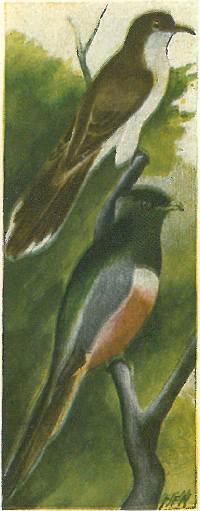
This bird is the same as the eastern variety, except being a little larger and the bill more stout. It may be distinguished by its blackish, long tail, tipped with white, and its yellow under-bill. Reddish brown patch on the wings.
Nest.—Is made of twigs loosely put together, and lined with grass, or shreds of grape vine bark. The nests are generally very shabbily built and so nearly flat on top that the eggs will frequently roll out. They are located near the ground in low bushes or trees; three or four eggs are deposited at intervals of several days, and frequently young birds and eggs are found in the nest at the same time. Like the Flicker this bird will continue laying if one egg is removed at a time, and as many as twelve have been taken from the same nest by this means. Eggs are a pale greenish blue (1.20 × .90).
This is the only member of this family of beautiful birds that reaches our borders. They nest in cavities of trees, usually in Woodpecker holes. Three or four white eggs (1.10 × .85).
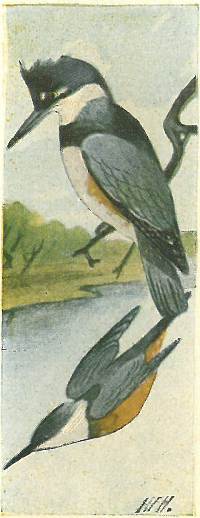
The rattling note of this well known bird is familiar in almost all localities in the neighborhood of ponds or rivers where small fish are common, throughout North America. Their food consists almost entirely of small fish, which they catch by plunging upon from high in the air, where they will hover over the water similar to the Osprey, or they will spend their time sitting upon an overhanging limb, and, when a fish is seen, drop from that upon the fish, usually taking it back to the limb to be eaten.
Nest.—Is located at the end of burrows, which they dig out of the sand banks or the banks of creeks and rivers, sometimes extending back from six to eight feet, usually with a little rise in the tunnel for the purpose of keeping it dry. They lay from five to eight glossy white eggs (1.35 × 1.05).
This is somewhat larger than the above, and found only on the most southern borders of the United States. Eggs white (1.45 × 1.10).

This species is similar in every way to its eastern relatives and for coloring is as illustrated. The nesting habits of this and the sub-species are the same, and the eggs cannot be identified as being different. Four pure white eggs are placed at the bottom of some cavity, in tall trees usually (.95 × .70).
Some lighter on the under parts than preceding (not illustrated).
A trifle larger, and white below (not illustrated).
A smaller bird than any of the preceding, similar in coloring, as illustrated. It is a more sociable bird and is found about the dwellings in country places, and even in the larger cities about the parks.
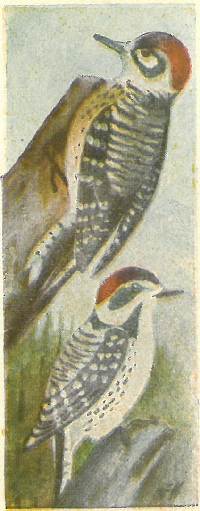
This species is brownish white below, has the back barred with black and white, on account of which it is often known as the “Ladder-back Woodpecker.” The male has the whole crown red, shading into mixed black and whitish on the forehead. Its habits and eggs are the same as the previous species.
Where the two former have red crowns, this one has a crown of black and a small red patch on the back of nape. Outer tail feathers nearly all white, while in the former they are barred with black and white. They are pugnacious little birds and will drive many of the larger Woodpeckers from their locality.
Nest.—In holes of trees, either in dead stumps or growing trees at no great elevation from the ground. Four pure white eggs are laid at the bottom of the cavity, on the decayed wood (.85 × .65). Their food is gathered from under the bark, consisting of larvæ, ants and small insects.
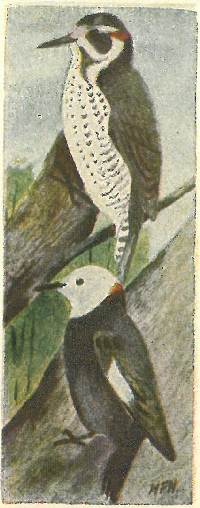
This is an entirely different looking bird from any of the others of the Woodpecker family, being uniform brownish above and a grayish white below, with black spots. The male having a crescent shaped patch of red on the back of the head, outlined mostly with white. It is locally common at the higher altitudes in the mountains of Arizona.
Nest.—Is practically the same in habits as others mentioned, nesting in holes of trees, and laying four white eggs (.85 × .60).
This odd species is wholly a dull black color, except for the white head and neck, and basal half of the primaries. It also has on the male a small red spot on the back of the neck. They are said to be more silent than other members of the Woodpecker family, and rarely make the familiar tapping and never the drumming sound. They secure their food by scaling the bark from the trees, prying it off, instead of drilling a hole. They nest at any height, but the greater number seem to prefer near the ground (20 feet), and in old dead pine stubs. They lay from four to six glossy white eggs (.95 × .70).
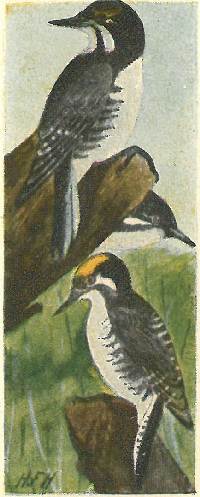
As implied by the name, members of this genus have but three toes, two in front and one behind. The plumage of this species is entirely black above, and whitish below, with the flanks barred with blackish. The male has a yellow patch on the crown. They breed abundantly in coniferous forests in mountain regions throughout their range, laying their four or five pure white eggs in decayed tree stumps (.95 × .70). They do more boring for their insect food, and, during mating season, are very persistent in their roll call on dead limbs of trees.
The greatest difference between this bird and the last is on the back, it having several narrow bars of white near the neck or a patch of white in place of the bars. Breeding habits are the same.
In every particular similar to the last, with the patch of white on the back possibly a little larger. Habits just the same (not illustrated).
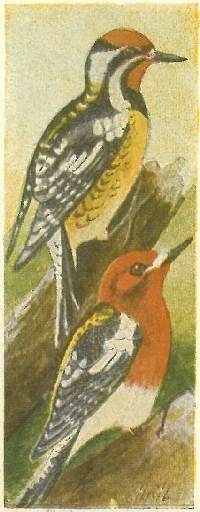
This is one of the most handsomely marked of the family; they may be identified easily by the red crown and throat (female having white on the throat), each bordered by black, forming a wide breast band, with a band of white, black and white back of it. The under parts yellow. This species and the two following are the only real sapsuckers, a crime that is often attributed to the most useful of the family. While they without doubt will take some of the sap from trees, their food consists more of insect life, ants in particular.
Nest.—Is placed in a cavity of decayed trees. Four to seven glossy white eggs (.85 × .60).
A Pacific coast bird from Lower California to Oregon. The entire head, neck and breast of this species is red, of varying shades in different individuals, from carmine to nearly a scarlet. The remainder of their plumage is similar to the above. Nesting habits the same.
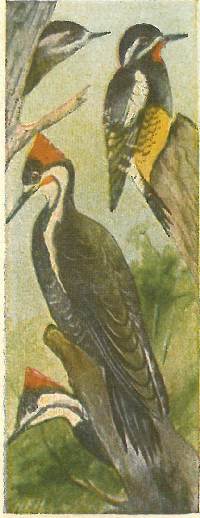
A great variation in the plumage of this oddly marked bird is found. The male is mostly black on the back and breast, with a white rump, and with only a narrow patch of red on the throat; the under parts are bright yellow. The female is entirely different, being brownish in place of the black on the male, has no red on the throat, and on the back is barred with black and white.
Their nesting habits are the same as those of the family previously mentioned. Four to seven white eggs (.97 × .67).
This is one of the largest and strongest of the Woodpeckers; they are a sooty black on the upper parts and breast; the crest is long and bright red, and the male has a red line back of the eye; sides of the neck pure white, and patch of white on the wings. Female is more of a grayish black color than the male. As the large trees are being cut away in many localities where these birds were to be found, they are gradually driven farther north or into the mountain regions, where they can find the heavy timber in which they make their homes.
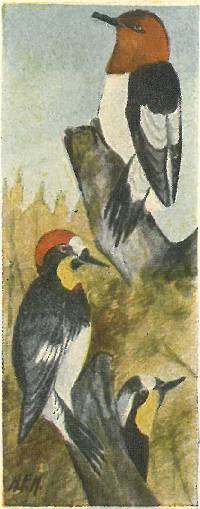
In flight, this is one of the most conspicuous of the woodpeckers. It has a bright red head, neck and breast, glossy blue-black on the back and tail, white rump, under parts and secondaries. It is more abundant in the east and middle United States, but occurs fairly common in Arizona and Texas to Colorado. It nests in any kind of trees, telegraph poles or will even drill a hole under the eaves of the barn or house in some localities. They are the most pugnacious of the woodpeckers, and often are seen chasing one another or driving away some other bird. They feed also upon ants, larvæ of insects, and small fruits and berries.
They lay from four to eight pure white eggs (1.00 × .75).
A common and attractive woodpecker throughout California and Oregon. With its red cap and white forehead, and back or upper parts black tinged with green, a solid black band across the breast, white under parts and rump, and, above all, their continual talking among themselves. Nest, eggs, food, same as above, with the addition to its diet of acorns in great numbers.

An oddly colored species, with a crimson red face, under parts streaked with crimson and white, a gray breast, and upper parts a glossy greenish black. They are more common in the mountain ranges among the tall pines from the eastern Rockies to the Pacific coast range, breeding high up in the trees. Their food consisting of insect life mostly, and acorns, which they gather and store away for future use. Four to eight eggs are pure white (1.05 × .80).
Found on the eastern slope of the Rockies and south to central Texas. It is an attractive bird, frequently called the “Zebra Woodpecker,” on account of the black and white markings on the back, wings and tail. Nests in live trees; three to five white eggs (1.00 × .75). Not illustrated.
This is also one of the “Zebra Woodpeckers” to be found in Arizona and the Mexican borders of the United States. Its preference for nesting site is the Giant Cactus. Eggs same as above.
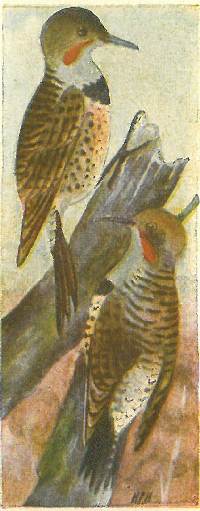
These birds are not inclined to search for their food among the trees as are most of the woodpeckers, but may often be found on the ground on the edges of the woods or in open fields, where they secure ants as their principal article of food. The top of the head is brownish instead of gray, and the under parts of the wings, tail and the quills are reddish orange and not yellow as on the eastern varieties. The male has a bright red streak from the bill extending back and below the eye, the female does not have this. The throat is a gray, with a black crescent on the breast, under parts light gray with numerous black spots, rump is white and tail is mostly black above.
Nest.—Is placed in holes of trees in the woods, or in any locality where they make or find a suitable hole.
Four to eight white eggs (1.10 × .90).
Very similar to above, with the under side of wings and tail yellow. Found only in southern California and Arizona southward.
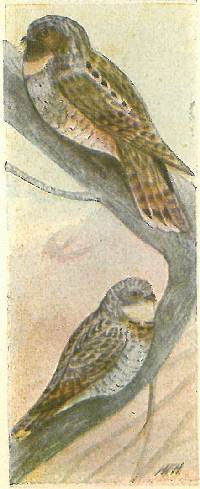
One of the birds that are heard much more often than seen, and in their habits they are very secluded, keeping in the dark woods the greater part of the time, rarely leaving its place of concealment before dark. In pursuit of insects, they are swift and noiseless, their soft plumage giving forth no sound, as their wings cleave the air.
Nest.—Is on the ground among the leaves, usually in dense woods. Their two eggs of a grayish or creamy white are very faintly marbled or marked with pale brown and gray. These birds are only found in southern Arizona, Texas and New Mexico.
The smallest of the family. A handsome species, with plumage mottled black, white and gray, beautifully blended together. To be found west of the Mississippi from British Columbia to southern California. Eggs are a pure white (1.00 × .75).
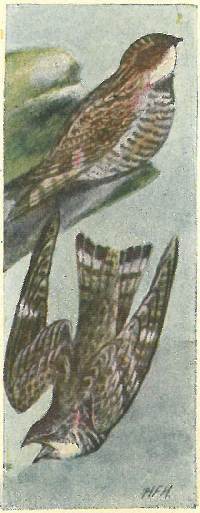
The nighthawk may be distinguished from the Whip-poor-wills by its forked tail in place of the rounded tail of the “Poor-wills.” It also has a white band near the end of the tail, and across the primaries, the latter making a very conspicuous mark when in flight.
Nest.—They lay their eggs upon the ground or on a ledge with no attempt at nest building. The two eggs are a grayish white color, marbled, blotched and spotted with darker shades of gray and brown (1.20 × .95). Found from the plains to the Pacific and from British Columbia to Mexico.
A paler and more of a grayish color than preceding. Habits the same.
The markings of this species are much finer and more mottled with a reddish brown color than the preceding. They are very abundant in Arizona, southern Texas and quite common in southern California.
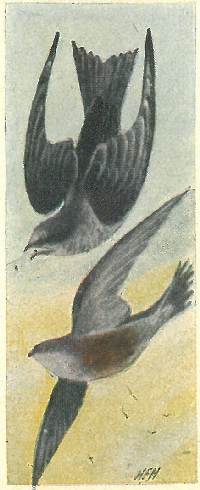
The plumage of the Swift is a dull sooty black, somewhat lighter on the under parts. The tail is slightly forked and does not have the spines which are usual with this family. Although the general habits of this species are well known, but little is known of their nesting; they are seen during the breeding season about the higher ranges of their United States range, and are supposed to nest in the crevices of cliffs at high altitudes.
This small Swift is not nearly as common as the preceding, is much paler in color and white on the under parts and throat. Their habits are much like the last, only that they make use of hollow trees in which to place their nests, which are made of twigs glued to the tree with the glutinous saliva of the birds, forming a very shallow platform in which they deposit three or four pure white eggs. They are on the wing much of the time during the day catching insects, or several pairs seemingly at play in the air, generally at quite high elevations, toward dusk returning to their nesting places.
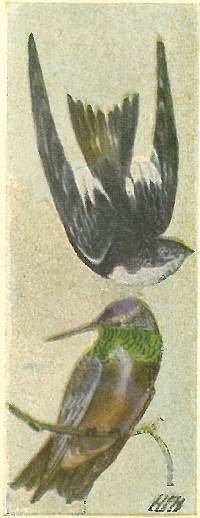
A handsome bird, in fact, the most beautiful and graceful of this family. Its flight is very rapid, and they congregate in thousands about the tops of inaccessible cliffs, where in small burrows in the earth or under the sods, or in crevices they build their nests, which are generally made of roots and grasses and lined with feathers. Four or five dull white eggs are laid (.85 × .50).
Range.—Western United States, mostly in the Rocky Mountains, and in California ranges north to Canada borders.
This is one of the most gorgeous of the Hummers, having the crown a violet purple color, and the throat a changeable brilliant green. Upper parts a bronze green, the under parts almost a black. Female lacks all the brilliant colors of the male. Upper parts dull green, under parts greenish gray, top of head brownish with a small white spot back of the eye. This species saddles its nest upon the branches, generally for its favorite tree selecting a maple or sycamore, and usually at from twenty to thirty feet from the ground.
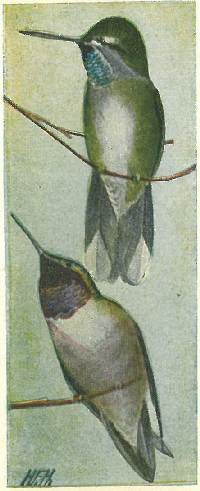
This bird is a trifle larger than the preceding, and, as the name implies, it has an iridescent bright blue throat, with a streak of white extending from the bill to back of the eye, the upper parts of a uniform greenish color, under parts are a greenish gray. Tail dark with outer tail feathers broadly tipped with white.
Nest.—Is built similar to above, but placed at lower elevations, at times very near the ground. They are to be found only in Arizona and the southern borders of the United States.
This is similar in size and appearance to the “Ruby-Throat,” but has the chin and upper throat black, the rest of the throat being violet or amethyst, as seen in different lights. It is a very common bird in the southern part of its range. It nests low, rarely above ten feet from the ground. Nest made of plant fiber, not covered with lichens, but resembles a small piece of sponge.
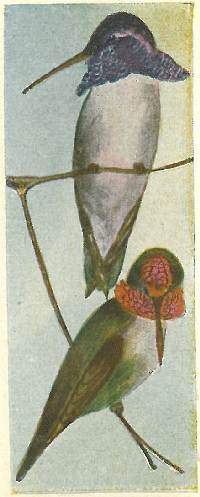
A slightly smaller bird than the last, with the crown and the lengthened feathers of the neck which form a ruff of the most brilliant violet or amethyst, back and rump of a greenish bronze color, under parts whitish with a green cast on the sides. Female lacks the brilliant colors of the male on the head and neck and shows no sign of a ruff.
Nest.—Is usually placed in the forks of small shrubs near the ground, seldom above six feet from it, and made of plant down, with shreds of weeds, bark and lichens worked into the outside portion, and lined with a few soft feathers. Two pure white eggs (.48 × .32).
This bird is marked much like the preceding, but varying greatly in the colors. The crown and lengthened feathers of the neck are a beautiful iridescent purplish pink. Upper parts are the usual metallic green, under parts light gray, with sides greenish. Tail is more forked and has no brown or white like the former. They are very abundant in their restricted range, and frequently raise two broods in a season.
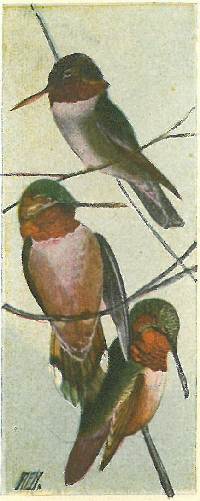
The crown, back and central tail feathers are a metallic green. They do not have the elongated feathers on the throat and no ruff. Under parts dull white, shading into light green on the sides, the throat is a bright lilac. They are very abundant in Arizona and Colorado, where they nest much as does the “Ruby-Throat” in the east.
A beautiful little bird, with the back and tail reddish brown and with a throat of orange red, the feathers being lengthened into a ruff on the sides of the neck. Their nests are made of vegetable fibers covered with lichens and cobwebs, and placed near the ground on vines or low-hanging bushes. Two white eggs.
This is very much like the last, with the back more greenish and the tail being a reddish brown. They are found on the Pacific Coast from British Columbia southward, breeding most abundantly in southern California.
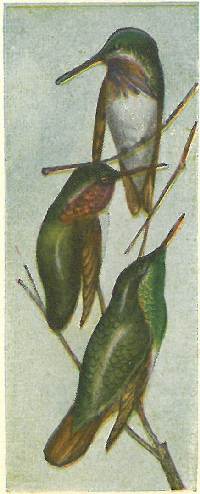
This is the smallest of the family of North American Hummers. It is greenish on the upper parts, growing darker toward the tail, the end of which is a light brown. The throat is a rich violet, showing white at the base of the feathers. They are found from British Columbia southward and from the Rockies westward, most common during breeding in California and Oregon. They build their nests in all manner of locations, from high up in tall pines to within a foot of the ground in low bushes. They are made of plant down and shreds of bark and lichens, breeding high up on the mountains.
Found only on the southern borders of the United States, but is quite common in Central Mexico. Throat is a metallic purple, with feathers elongated on the sides.
Found only on the southern borders like above. Upper parts a dark bluish green, tail and rump light brown.
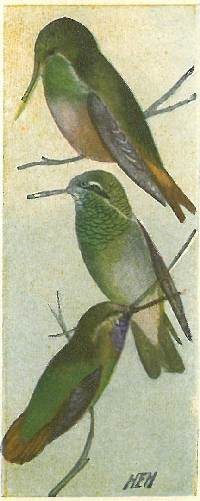
These birds are very similar to the last, but the under parts are of a pale brownish buff color, throat, back and tail coverts metallic green. Breeds in low bushes near the ground.
Found in Lower California, where it breeds and builds very much as does the preceding near the ground. (Not illustrated.)
These birds are of a bright metallic green above and also on the breast, the forehead, sides of head and throat are an iridescent blue, and a white line extends back from the eye. Found in the southern parts of Arizona and Texas into Central America. Nesting habits same as above.
Markings are in every way very similar to the above, being brighter on the throat, showing a more brilliant blue. Found in the southern borders of Arizona and Texas, where it breeds in the lower lands and near the ground. Nests similar to above.

From the time of their arrival Kingbirds are much in evidence about farmyards and orchards. They are very noisy birds, ready for a quarrel at any time and usually come off victorious in whatever they undertake. They seem to delight in driving away crows, and may frequently be seen to alight on the back of one when chasing them. These are found only on the eastern slope of the Rockies and eastward, where they are very common.
Nest.—Is placed in almost any kind of trees in open fields or woods. Nearly every orchard will have one or more pairs breeding. Their nests are made of twigs, roots, or strips of fiber from vines and lined with the down from catkins and horsehair. Three to five creamy white eggs, mottled and streaked with brown and lilac, are laid (.95 × .70).
A more western variety, lighter in color and with a bright yellow breast and under parts. Its habits are much the same as the above in its home building or in trying to find a neighbor to quarrel with. The eggs are the same in size and color.
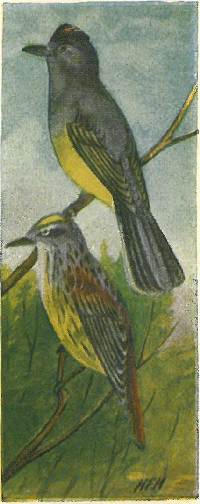
These birds are very much like the last, except that the throat and breast are darker.
This is one of the largest and most handsome of the family. With its bright yellow crown, surrounded with a black border and this by white and another band of black, with the under parts a bright yellow makes him one of the most attractive. They are found, though, only on the southern borders of Texas into Central America. (Not illustrated.)
Unlike any of the previous, and only found breeding in the mountains of Arizona south to Panama. The back is grayish streaked with black, the tail a dull reddish brown, and the under parts yellow, streaked on the sides with dusky; a white throat patch, bordered with black; the crown with a concealed yellow spot bordered with dusky and a narrow white stripe over the eye. They place their nests in the cavity of some tree, and lay from three to five buff colored eggs spotted and blotched with brown and lavender (1.05 × .75).
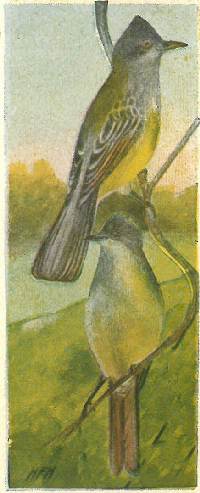
This is more an eastern bird, but is found in Texas and down through Central America. They nest in cavities of trees, it being made of twigs, weeds, grasses, and invariably a piece of snake skin. They lay from four to six eggs of a buff color scratched and spotted with rich shades of brown and lavender (.85 × .65). (Not illustrated.)
The throat and breast are lighter than the previous bird, and the under parts are paler yellow. Its nesting habits are the same as above even to including the piece of snakeskin, or in place of it part of a lizard skin will answer their purpose.
A much more quiet bird than either of the above, in looks as well as in actions. The upper parts are grayish brown, while the under parts, breast and throat are almost white. They build their nests in the giant cactus or in holes of stumps, lining the cavity with roots and grass or bits of rubbish of almost any kind, and generally include the piece of snake skin as do the ones above.
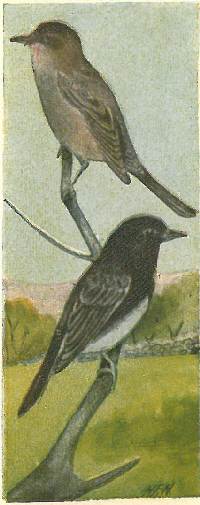
The Phoebe is a bird that will select for its nesting place the heavy beam of some old bridge, or in some old mill where the timbers are falling down, and place its nest in some dark corner, building it of mud, moss and grasses lined with feathers, or in some localities the nests may be placed in the crevice of some cliff or ledge where they lay four or five white eggs, rarely dotted with brown.
It is slightly larger than the eastern variety, with the under parts showing more of a brownish color, and is found breeding from the Arctic to Lower California.
Slightly smaller than the above, and much darker, almost black on the head and back with white under parts. Their habits are very much the same as above, frequenting old buildings in villages where a stream is near by, or in localities where insect life abounds. Their nest is made the same as above, and eggs are the same.
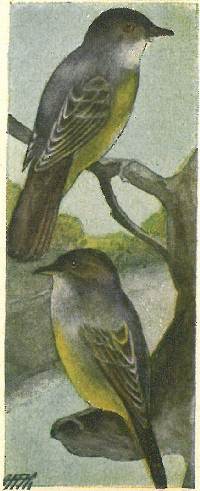
These are nowhere abundant, and in some parts of the country, especially in the central portions, they are very rare. In the western range, they may be found from Alaska to southern California; for breeding places they seem to prefer swampy land, covered with many dead coniferous trees, mixed in with the green trees; their nests are placed well up in the trees and are made of twigs, loosely put together, and lined with small roots and moss. The three or four creamy white eggs are spotted with brown and lilac, forming about the larger end (.85 × .65).
Very much like the eastern variety in looks and habits. To be found breeding from Alaska to Lower California. Their nests are placed on horizontal branches, made of plant down, grass and fibers; very compact, and much resembling a knot on the branch. Three or four white eggs with small spots about the larger end (.80 × .55).

Very much like the last, but having more of the yellow cast on the under parts; it may be found breeding from Alaska to southern California. Its favorite nesting place is along some stream, bordered with willows or alders, and the nest is placed on the lower branches near the ground; it is nicely made of fibers and plant down; three or four white eggs, spotted with brown (.80 × .55).
Upper parts an olive brown, becoming darker on the head; under parts white, and also a white ring about the eye; two wing-bars a pale buff color, and the breast a light gray. They seem to prefer much the same localities for their nesting site as do the “Western.”
Nest.—Is usually built very low in willows or alders, bordering brooks or ponds, and is made of plant fibers, lined with the down, and sometimes horsehair; three or four creamy white eggs are marked with blotches of brown about the larger end (.70 × .54).

A western form of the “Least Flycatcher” of the east, differing but very little in appearance or habits from its eastern relative. Upper parts an olive gray color, with the breast the same, but a little lighter. Their nesting place is usually a fork of some small tree, or upon some horizontal branch at low elevation, and is a nicely woven, compact structure, made of plant fibers, strings, hair and cobwebs. Three to five pale creamy white eggs (.65 × .50).
Similar to the last, but much lighter below. They are much more abundant than the last, and are found from Oregon to Mexico, where they breed more in open woods and thickets. Their nests and eggs are practically the same in every way.
This slightly larger species is more grayish above, and lighter below. It is found in Arizona and Mexico, into southern California. No record of its nesting habits or eggs can be given.
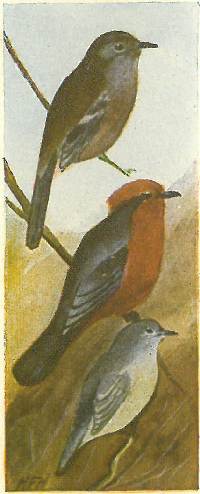
This small variety is not at all common in any locality, but is found in Arizona, Mexico and Lower California, to southern California. It is brownish gray above and of a buff color below. The nests are placed similar to the preceding, but more in the mountain regions; eggs are the same, being a trifle larger.
This is one of the most brilliant colored of the Flycatcher family, as shown in the illustration. The female is almost of an entirely light gray color, barely tinged with pink on the under parts. They are very common in southern Texas, Arizona and New Mexico.
Nest.—This is one of the prettiest nests made, generally of twigs and plant fiber, lined with down, wool and feathers, and frequently covered with lichens, held in place by a winding of cobwebs; three or four buff eggs, boldly blotched with brown and lavender (.70 × .50).
A light gray bird, found in Texas and south, into Central America.

This is the largest of the Larks. It has the throat white, with no trace of yellow; the horned tufts are black, and curve upwards. Found in Alaska, south to Oregon (not illustrated).
Found from British Columbia south, in winter to southern California, Texas and New Mexico. They are one of our handsome winter birds, with horn-like tufts of black on either side of the head; forehead, patch under the eye and band on the breast black; yellow throat, and white under parts; upper parts, a light pinkish shade of brown. Three or four eggs, white, marked with shades of brown, are placed in their nest of grasses and rootlets, on the ground, usually concealed under a tuft of grass (.92 × .65).
Similar, but back deeper brown. Southern and Lower California.
The same as above, but still more rufous. Central California.
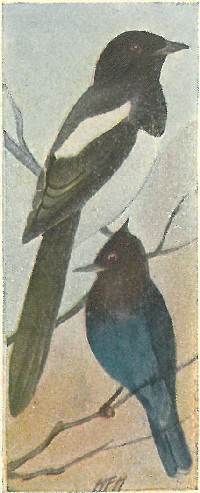
Like the “Blue Jays,” the Magpies are great talkers, and are usually found in colonies where they can carry on conversation in their own way with each other. They are a large handsome bird, with pure white under parts and wing coverts, and the upper parts, head, tail and breast are a bronzy black, with iridescent changes. Tail very long, and graduated. They are very bold birds, inquisitive, and great thieves. Their food consists of small rodents, a large variety of insect life, and the eggs and young of small birds.
Nest.—Is a bulky affair, placed at almost any elevation, composed of sticks and small twigs, with an opening on the side; the inside of the nest is lined with finer materials, grass and plant fiber. Four to eight grayish white eggs, spotted with brown and drab (1.25 × .90).
Range.—From Alaska south to central California. Nests are quite bulky; three to six greenish eggs, spotted with shades of brown (1.25 × .90).
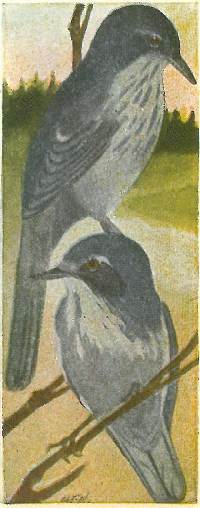
These birds are abundant in the Great Basin between the Rockies and the Sierra Nevadas, breeding in scrubby trees or bushes at low elevations and usually near some stream. They have the crown and forehead bluish, and the under parts are gray, streaked with a darker shade on the breast. Their food consists of acorns and a variety of insects.
Nest.—This is usually of small sticks, loosely arranged, with smaller twigs and roots for a lining. Four to six eggs, of a pale green, faintly spotted with shades of brown (1.20 × .90).
These are the most common of the Jays on the Pacific coast of California, Oregon and Washington. They are more tame or fearless than most of the family, and frequent the trees about houses, and are given the bad name of robbing the nests of other birds of their eggs and young. In color these are just the reverse of the previous one, being brownish below, and gray above.

A common bird in Arizona and south into Mexico. The upper parts are a bluish gray, shading into a brownish gray on the head; under parts are a pale gray. They are a very sociable bird during the breeding season, and often several pairs will nest in the same clump of trees, usually placing their nests at low elevations.
Nest.—Is made similar to the preceding, but the four eggs are more of a bluish color, without markings (1.20 × .85).
This is almost the counterpart of the Canada Jay of the east, with the exception of having more white on the head, and only a small space on the back of the neck. He is the same “old coon” as the eastern bird about camps, and is rightfully called “Camp Robber.” Their nesting habits are the same as above, but their eggs are drab, spotted and blotched with brown, of varying shades (1.15 × .80).
Like the last in every way, but with a blacker head, forehead white.
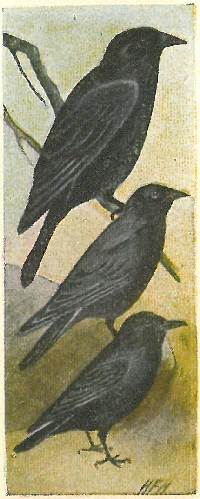
This is a large edition of the Crow, and is found west of the Rockies from British Columbia southward. Their plumage is a bluish black, with lengthened and stiffened feathers on the neck. Their general habits are much the same as the Crow. Their food consists principally of carrion, fish, and eggs and young of smaller birds. They nest on the high cliffs in almost inaccessible places, building large nests of sticks, in which they deposit four eggs of a pale greenish white, spotted and blotched with shades of brown and drab (1.95 × 1.25).
A smaller bird than the above, and has the base of the neck feathers white. It is a more southern variety, and is found in Arizona and on the Mexican borders. They build at low elevations, making their nests of sticks and twigs. Four pale blue eggs, spotted with dark brown (1.75 × 1.20).
This is one of the smaller Crows, found only on the coasts of Oregon to Alaska, where it feeds almost wholly upon fish.
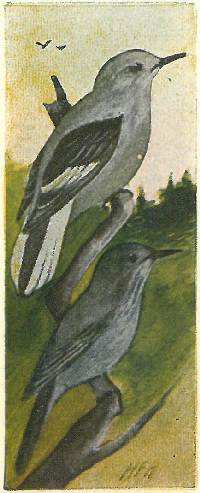
Found in the mountains of western North America, from Mexico to Alaska. In habits they much resemble the Crow or some of the Jays. Their food consisting largely of seeds from the pine cones, insects of many varieties, larvæ and berries. They seem to prefer the tops of the higher mountain ranges, coming down into the valleys for their supply of food. Their nesting sites are well up in the mountains, where they build their nests in the coniferous trees, of twigs, weeds, strips of bark and plant fibers, making a deep cup-shaped nest in which they lay from three to five greenish gray eggs, spotted over the whole surface with brown and lavender (1.30 × .90).
To be found in the pine regions of the Rockies and west, and from British Columbia to southern California. They are very sociable birds, keeping in colonies, and always have much to talk about among themselves; after the breeding season they may be seen in large flocks. Three to five bluish gray eggs, are spotted with different shades of brown (1.20 × .85).
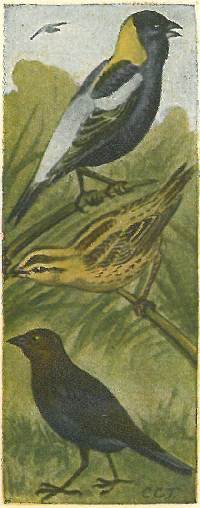
This bird is found over most of North America from the southern parts of Canada south, and has been gradually extending westward as far as California. During mating season it is hard to find any other bird so completely filled with music as are these birds. They are also quite sociable birds, and several pairs of them may be found nesting in the same piece of meadow land, and filling the air with their sweet, wild music. They place their nest in a shallow hollow on the ground; it is lined with grass and frequently so covered as to be almost arched over to conceal the eggs. Four or five eggs of a grayish white, thickly blotched and spotted with brown of different shades and lilac, generally covered with ground color on the larger end (.84 × .62).
It is to be found throughout the United States and the southern portion of Canada. They are the only birds which we have that neither make a nest of their own nor care for their young. They will deposit a single egg (sometimes two) in the nest of some other bird, usually of a smaller variety.
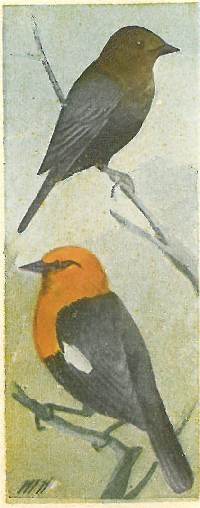
The same as above, being more of a bronze color, found in Arizona and Mexico.
Habits as above. Plumage is glossy black, with brassy reflections. They are abundant in southern Texas, and in Mexico (not illustrated).
A large and handsome bird, with bright yellow head and breast; body black, with a white patch on the wing. They are a western bird, being found from the central United States to California. They breed abundantly in suitable marshes throughout their range. Their nests are made of strips of rushes, interwoven and fastened to the upright rushes only a few inches above the water. The four to six grayish white eggs are spotted with shades of brown and gray (1.00 × .70).

An eastern bird, found as far west as the eastern part of the Rockies. Very common in many parts of the east, where it builds much the same as does the previous, laying four or five eggs, bluish white, spotted, blotched and scratched with shades of brown (1.00 × .70).
Similar, but with more of a buff in place of the white on the wing. In southern California and Arizona (not illustrated).
The male of this species do not have the light margins to the red on the shoulders, as do the others. They are found on the Pacific coast from Washington to southern California. Eggs and nests the same.
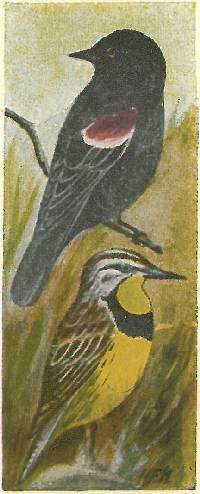
This species is a much deeper red on the shoulders, and the buff color on the preceding is white on this bird. They are restricted to a small range, the Pacific coast of California and Oregon, and are not nearly as common as the eastern variety. Their nesting habits are the same, and the eggs are indistinguishable.
This variety is somewhat paler than the eastern bird. In habits it is the same. The nests and eggs cannot be separated from the eastern. There seems to be one great distinguishing quality between the two, and that is in their song or notes. The first one that I had the pleasure of hearing was in Oregon, and my first thought was of our eastern Bobolink, but on seeing the bird in flight, I at once knew that it was a new song, sung by our eastern Meadowlark in appearance. They feed on insect life, beetles, etc. They lay from four to seven eggs, spotted with shades of brown (1.10 × .80).
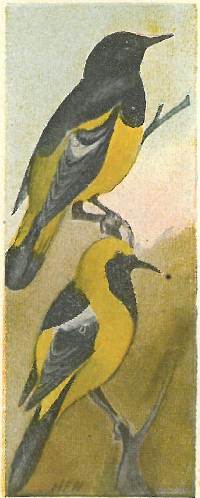
This is not a common species in any part of its range, from southern California to Texas, and in Mexico. It is a handsomely marked bird, with its clear black and yellow. They build a hanging nest, usually suspended from the under sides of the leaves of the yucca palm, or from small branches of low trees. Three to four bluish white eggs, specked and blotched with brown about the larger end (.95 × .65).
This is a deeper yellow; the face, throat, back, wings and tail being black, the wings with two white bars. Found in Texas and south into Mexico. Nests are made of hanging moss (not illustrated).
This is very much like the last, but lighter, and is found common in Arizona, New Mexico and southern California. Its favorite nesting place seems to be a bunch of Spanish moss, looping up the ends and weaving it closely together, and forming a pocket inside, which they line with dried grasses and yucca fibers.
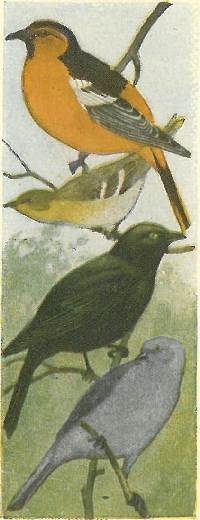
This is a western representative of our eastern bird, the Baltimore Oriole, and their ranges overlap each other on the eastern slope of the Rockies. They build a hanging nest, and in the southern part of their range use the Spanish moss and mistletoe for the foundation of the nest, lining the opening with grasses, hair and small fiber. Three or four white eggs, spotted and streaked with shades of brown (.94 × .62). These birds are of great benefit to the small fruit growers in eating the many injurious insects.
This is a bird of the east, but is found on the eastern slope of the Rockies, and straying into southern California to the Gulf of Mexico. Breeds along the northern borders of the United States, northwest to Alaska. The female is very much lighter than the male, and of a brownish drab color. They build large substantial nests of moss, twigs and grass, lined with finer material of the same, and placed in low bushes or trees only a few feet from the ground. Three to five eggs, pale bluish green, blotched and spotted with brown (.96 × .71).
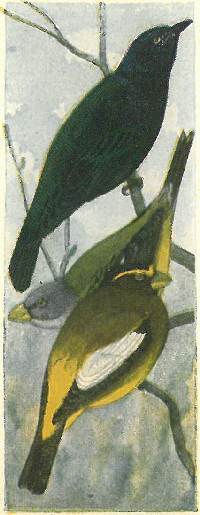
Found throughout western North America, breeding from Alaska to southern California. They differ from the preceding in having a purplish reflection on the head and upper parts, and greenish black body. They nest abundantly throughout their range, either in bushes or trees at low elevations, or upon the ground; the nests are made of sticks, roots and grasses, lined with finer grass. Three to five eggs are laid, which are very variable in marking, a dull white, spotted and blotched all over thickly with brown of different shades (1.00 × .75).
Western North America, and breeding from British Columbia to central California. They build in the evergreen trees upon the mountain side or along some stream in the willows; they are always frail structures made up of a few loosely put together twigs and roots. Three or four pale greenish eggs, spotted sparingly with brown, are the usual complement (.90 × .65).
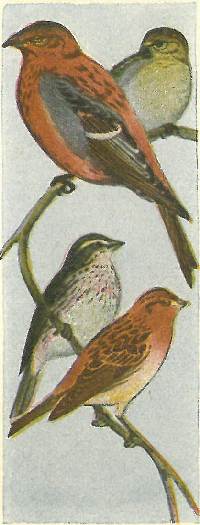
These are one of the most unsuspicious birds that we have, and can be approached to within a few feet. The male is a bright red above and an ashy gray below, having much less of the red than his eastern relative. The female is a dull ashy gray, with a yellowish brown on the top of head and rump. They like the cooler places in which to live, and are found about the snow lines on the mountain, where they feed largely upon the seeds of the coniferous trees, in which they place their nests, making them of fine twigs and rootlets, and lining with grass and moss. They lay three or four eggs, light greenish blue, with splashes of brown and fainter markings of lilac (1.00 × .70).
This is found from British Columbia to southern California. It breeds well up in the mountains, usually in evergreens. Three or four eggs of a greenish blue, spotted with brown (.85 × .65).
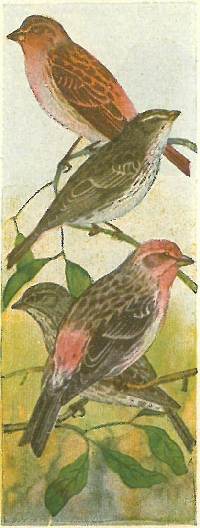
It is found west of the Rockies, breeding from British Columbia south to New Mexico, well up in the mountain regions, as far as the timber line extends. The back, wings and tail of this are darker than the preceding species; the purple color being more of a rosy tint. Their nests are made of twigs and rootlets, loosely put together, and almost flat; they lay three or four eggs not to be recognized from the last.
This is one of the most familiar birds on the Pacific coast. With his bright colors, and the more quiet colors of his mate, and the habit they have of keeping close to civilization, building their nests in the vines about the porches of the houses, both in the country and even in the cities, they are great favorites with every one. Their clear and pleasant song is kept up continually during the day, and where two or three pairs are nesting nearby, there is no lack for bird music. Their nests are made of fine rootlets and grass placed in almost any bush, tree or vine, if near some dwelling.
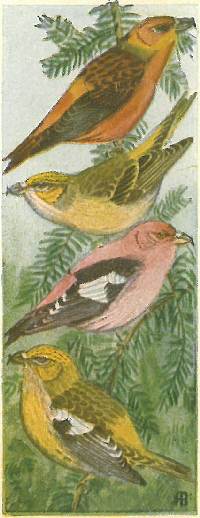
Found throughout the greater part of North America, and breeds in suitable locations on the mountain sides among the coniferous trees. On the Pacific coast, breeding from Alaska to southern California. In abundance they vary each year greatly, according to the food supply of cones in the evergreen trees from which they secure their seed supply; their twisted bill quickly opening up the cones and cleaning out the small seeds. Their nests are made of fine roots and grasses, and three or four eggs, greenish white, spotted and lined with shades of brown, are laid (.75 × .55).
These are of a lighter and more rosy color than the preceding, and also have a large white patch on the wings. The female is marked the same, with grayish and buff in place of the red on the males. Nesting habits and locations are the same as above. The eggs average a little larger and heavier marked (.80 × .55).
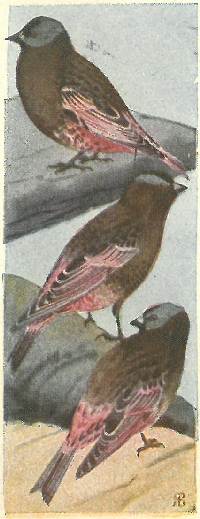
This is the largest of the family; they are pretty birds, with dark chestnut back and breast, and with the rump, wings and tail with a rosy tint. These are birds of the mountains and high altitudes, above or near the snow line. They are found breeding on the islands of Bering Sea, and in the western part of Alaska. They nest in crevices of the rocks or under ledges, making their nests of grasses and roots. Their four or five eggs are pure white (.97 × .67).
This is a lighter colored bird than the above. It is found on the eastern slope of the Rockies and has been found breeding in the Sierra Nevadas, in crevices of the rocks, after the same manner as the above. The eggs cannot be distinguished from the above.
These have more gray on the back of the head; otherwise the same as preceding in habits and nesting.
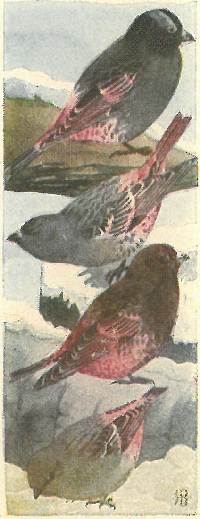
This species is the same in markings as the Gray-crowned, excepting that the brown is replaced with almost black on the back and breast. The females of this family are much the same as the males, only not as bright in markings, and the young are the same as the females. Found in the northern Rocky Mountains, breeding in the mountains south to Colorado. They are all restless birds, seldom making a long stop in one place, but flitting from one locality to another. After the breeding season, they congregate in large flocks and keep together about the snow line, getting their supply of seed and insect food. Their nesting habits and their eggs are the same as the Gray-crowned.
These are to be found more southerly in the Rocky Mountains than any of the others, breeding in Colorado, and wintering in New Mexico. Their nesting habits and eggs are the same. Most of this family keep above the timber line during the summer, and only come down into the valleys as the heavy snow comes.
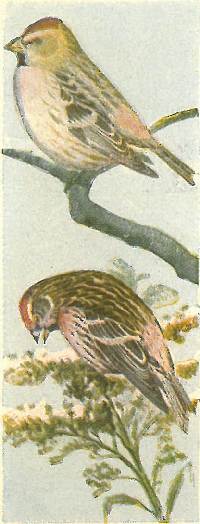
These pretty little birds, with their caps of bright crimson and rosy breasts, are birds of the coldest regions, breeding in the Arctic regions, and wintering to the northern parts of the United States.
Nest.—They build very large nests, mostly of small sticks and grass, and lined with fine grass and feathers, which are placed usually within a foot or two of the ground in scrub bushes. Their three to five eggs are a light bluish green, with specks of brown, mostly about the larger end (.65 × .50).
Its range is the northern part of North America, breeding in Alaska, and wintering as far south as southern Oregon, or into California on the western coast, in the mountain regions above the timber line. In Colorado, they have been seen at 10,000 feet, and with the temperature far below zero. Their nesting habits are the same as the above, and eggs are the same.
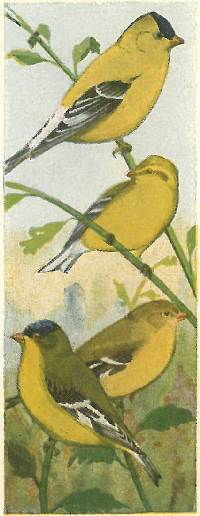
A paler form, found in the Rockies, south to Colorado (not illustrated).
A western form of the eastern bird, rarely reaching the five inches in length, and of a paler color, both the black and the yellow. It is common on the Pacific coast, from Washington to southern California, breeding in willows and low bushes. Nest is made of plant down, very compactly built, usually in a crotch. Four to five eggs, plain bluish white (.60 × .45).
Found from Colorado to Mexico in the Rockies (not illustrated).
In southwestern United States from Central California to Mexico.
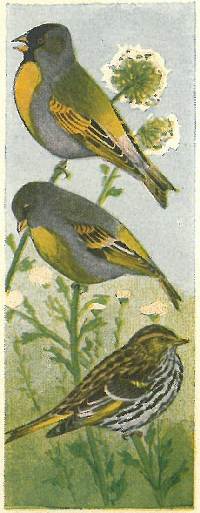
This bird differs from the others of this family in being mostly gray in place of the yellow, having the head and throat black. They are found quite commonly on the Pacific coast of California, and south to Mexico. Their nests are nicely made, cup-like structures of plant down, in which they deposit four white eggs.
These are a more northern bird, breeding mostly to the Canadian zone, and in the Rockies and higher mountains to the west. They feed largely upon weed seeds and seeds from the different coniferous trees, the latter of which they most often frequent, building their nests in these trees of twigs and rootlets loosely put together and placed on the crotch of a horizontal limb; usually four eggs, of a greenish white color, spotted finely with reddish brown (.65 × .45). They have a habit, while feeding, of clinging to the under side of a branch or cone, similar to the Chickadee, and, if disturbed when on some favorite tree, will make a short flight and circle back to the same tree.

To be found in the whole of the northern hemisphere, breeding within the Arctic Circle and wintering south to the central portions of the United States. They are one of the birds that change their dress completely from winter to summer, in color. In winter they are a clear black and white, while in summer the black is changed for a coat of chestnut or brownish. They are to be found in the winters, on the hillsides and in fields where the weeds are showing through, feeding upon the small seeds, and at this time they are as restless and uncertain as the snowflake itself, from which it is called. They nest on the ground, making it of dried grasses and lining with finer grass and feathers; the four or five eggs are a dull white, spotted and splashed with shades of brown, mostly on the larger end (.90 × .65).
This species is still more white than the preceding, having only a few specks of black on the tips of the primaries, and the central tail feather. They build, in crevices of the rocks on the ground, a nest of grass, lined with moss and feathers.

Their breeding grounds are in the northern part of Alaska in summer, and in winter coming as far south as Oregon and Colorado, when they may be frequently found in with flocks of Snow Buntings, and, like the Snowflakes, they breed on the ground in a depression in the moss or under some boulder, making their nest of grass and lining it with feathers. Their four to six eggs are grayish, nearly covered with spots and blotches of shades of dark brown (.80 × .60).
The chestnut shoulders and outer white tail-feather will distinguish this from any others of the sparrows, and the sides are more of a gray color than the eastern variety. Its habit of singing later in the evening gave it the name of “Vesper.” Found on the Pacific coast, from British Columbia to Mexico. Nest is made of grass, placed in a depression on the ground. Four dull white eggs, blotched with brown (.80 × .60).
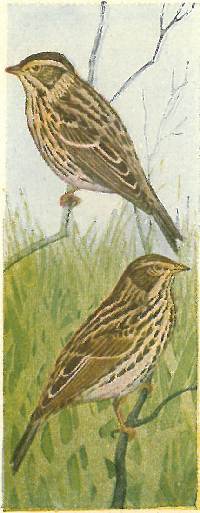
This is a slightly paler form of the preceding, and is very common in the fields and meadows, from northern Alaska to Mexico. They are birds but very little seen, keeping in the grass the greater part of the time. Their nests are hollows in the ground lined with fine grass and concealed by tufts of grass. They usually deposit four eggs, grayish white, blotched heavily with brown (.75 × .55).
Found on the salt marshes of California to Lower California. It is a darker and brighter bird than the preceding (not illustrated).
Found on the marshes of southern and Lower California. Is darker and more streaked below. Nesting habits the same; eggs darker.

The large and stouter bill, paler, and more of a grayish brown color, will distinguish this from any of the preceding. They are fairly common in the salt marshes of southern and Lower California. Their nesting habits and eggs are practically the same as those mentioned previously.
Breeds on San Benito Islands, winters in southern Lower California. Nesting habits are identical (not illustrated).
These sparrows breed abundantly in parts of the Dakotas on the plains, and winter in eastern Colorado, through Arizona to New Mexico. The tail-feathers of this species are much more pointed than on any of the preceding.
Nest.—This is placed on the ground in clumps of grass, and is made of fine dried grass. Usually four eggs are laid of a dull white, blotched and spotted with shades of brown and lilac (.80 × .60).
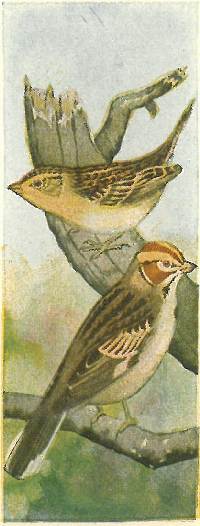
These birds are common in dry fields and pastures, where their faint lisping song is heard throughout the day. Nest is usually a deep structure in a hollow in some dry field, and usually placed near some rock or suitable place where they can watch the locality for danger. Four eggs are laid; white, finely dotted with chestnut (.72 × .55).
More slender in form than the preceding; breeding above the line and winters through eastern Colorado to southern Texas. Nesting habits and eggs similar to above (not illustrated).
One of the most common, as well as the most handsome of the sparrow family on the western coast; with its bright chestnut on the sides of the head, and black and white on the crown. They nest in low bushes, or on the ground in a clump of grass; four eggs are laid; white with dark brown markings, mostly about the larger end (.80 × .60).

This bird, a favorite with the people of the northwest, has been rightly called the “Northern Nightingale.” Their sweet song may be heard all during the day about dwellings or remote from them, or even in the night they have a habit of awakening and giving out the same sweet notes. In habits they much resemble the above, feeding upon the ground among the dead leaves in search of seed and insect food.
Nest.—This is placed on the ground in a clump of grass, and is made of fine grasses; four to six eggs of a pale greenish blue color, spotted and splashed with shades of brown (.90 × .65).
The crown of white in the above is replaced with a golden color. These are common birds about the cities of California during the winter months. Habits the same as above, and also their eggs.
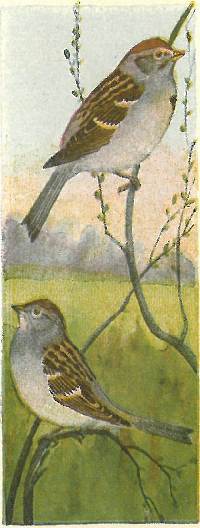
Somewhat resembling the “Chippy Sparrow,” but is larger and has a dark spot on the breast as an identification mark. It breeds in the far north, above the northern borders of the United States, and in winter is common through Oregon, California, into Arizona and Texas.
Nest.—This is usually placed in low trees or bushes or on the ground made of grasses and lined with feathers. They lay three to five greenish white eggs, spotted with different shades of brown (.80 × .55).
This is one of the most helpful birds to our gardens, living upon insects injurious to vegetation and on the seeds from the garden weeds. They will nest in trees and shrubs, or vines about the house, making a small compact nest, mostly of rootlets and horsehair. They lay from three to five greenish blue eggs, with few spots of brown, mostly about the larger end (.70 × .52).
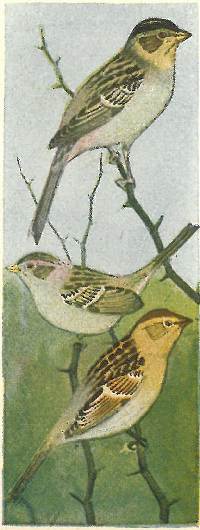
These are much like the Chipping Sparrow in every way, with the exception of color, the brown being replaced by the clay-color. Breeds in the Northern United States and into Canada; winters south to Texas and Mexico, rarely in eastern Colorado. Their nest is usually placed on the ground, but may be found in low shrubs in some localities; four eggs are the usual complement, of a light greenish blue, with spots of brown about the larger end (.65 × .50).
This is very similar to above, but much more streaked with dark above. It is to be found from British Columbia south to Mexico, especially in sections where the sage brush is found, and in southern California near the coast. Its nesting habits are much the same as the above, and the eggs are indistinguishable.
This is a southern form of the Chipping Sparrow, and is found in New Mexico and Mexico.
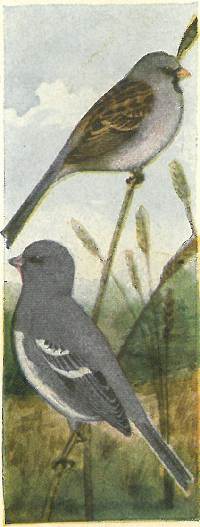
This is easily identified by the black chin, throat and forehead. It is quite common in parts of southern California, and south into Arizona and New Mexico. The habits are similar to those of the Field Sparrow, their eggs differing in being unspotted and are a bluish green (.65 × .50).
This is slightly larger than the common “Black and White Snowbird” (Hyemalis). It is also a paler bird and the wings are crossed by two white bars. It is found in the central Rocky Mountain regions, where it breeds in the northern part, and winters to eastern Colorado.
This is common “Black and White Snowbird” of the east, and is the same as above, but darker and does not have any white wing bars. They breed mostly north of the United States, nesting on the ground, often under some boulder, making their nest of roots and grass in which they lay four greenish white eggs, spotted with brown about the larger end (not illustrated).
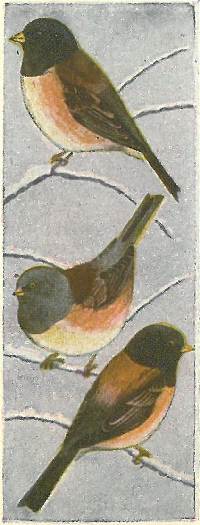
There are several of the sub-species of “Hyemalis,” all of which are very much alike in habits; varying in color and location. The Oregon Junco is found from British Columbia to southern California, breeding on the mountains of Oregon and northward. In color, this differs much from the preceding, with more black, and on the back a brownish color. The nesting habits and eggs are very much the same as the preceding.
These breed at high altitudes in the mountains of Montana, Wyoming and Idaho, and winter south to Mexico.
Found most commonly in the Sierra Nevadas from Oregon to southern California. The difference in coloring is shown in the illustrations of this and the two preceding.
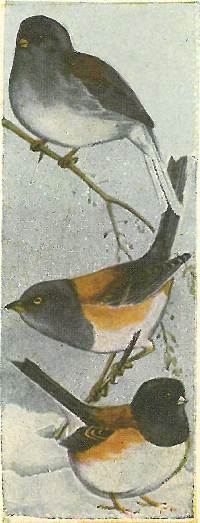
The same as the Slate-colored, with the exception of having the back a reddish brown. The nests of all the Juncos are placed on the ground, and the markings of their eggs vary but little.
Found in the mountains of southern and Lower California. This is a gray-headed variety with brown on the back and sides.
One of the smallest of the family, and found locally only on the Guadalupe Islands off the lower California coast, where they nest commonly in the pine groves, among the needles on the ground, or frequently protected by some overhanging stone. Their nest and eggs are the same as the others. Eggs bluish white, with fine dots of brown about the larger end (.77 × .60).
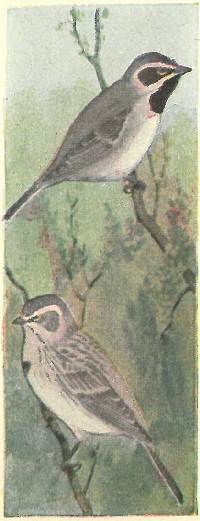
This is an abundant bird among the foothills of southwestern United States, in Texas, New Mexico and southern California. It is found in the hot desert plains, where it builds its nest in low bushes, of the sagebrush or cactus, within two or three feet of the ground. It is made up of twigs, roots and fine grass, and lined with feathers and horsehair. They lay three or four bluish white eggs (.72 × .55).
In the hot valleys and foothills of the southern half of California and in the Colorado Desert, south to Lower California, these grayish, black and white sparrows are found abundantly in localities where the sagebrush is common. They build their nests of roots and twigs, loosely put together, and usually lined with grass, feathers and horsehair, in the low sagebrush within two feet of the ground, or quite often placed on the ground under the cover of one of these bushes. They lay three or four pale greenish eggs, heavily blotched and spotted with shades of brown (.75 × .60).

These are a very quiet and shy sparrow, rarely singing except at their breeding season, and to be found commonly throughout the sage deserts of the Great Basin, from Oregon and Montana to Lower California and New Mexico. They nest either in small sagebrush or upon the ground, making their nests of shred from the sage and grasses, lining it with feathers and hair. They lay from three to four grayish eggs, with heavy markings of shades of brown about the larger end (.75 × .60).
Somewhat smaller than the last, and found from eastern California east to Nevada (not illustrated).
A larger gray sparrow, streaked with brown, and black spots. A southern bird, found in Arizona, Texas and Mexico (not illustrated).
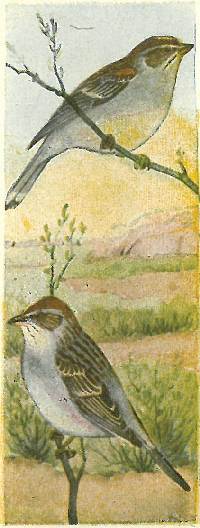
Found on the arid plains from Texas to Kansas, where it breeds much the same as does the Sage Sparrow.
This small and paler sparrow is found on the plains of Mexico and north to Arizona. In appearance and habits it is similar to the Chipping Sparrow, and the two are frequently found in the same locality. They nest in low bushes, making them of coarse grass and lined with down and hair, in which they place four sunmarked, bluish white eggs (.70 × .60).
Slightly larger than the former, and the color more of a brown streaked with darker, and still more of a reddish brown on the crown. It is found throughout California along the coast to Lower California. They build on the ground, concealing their nest in a clump of grass or under some bush. They lay from three to five pale bluish white, unmarked eggs (.80 × .60).
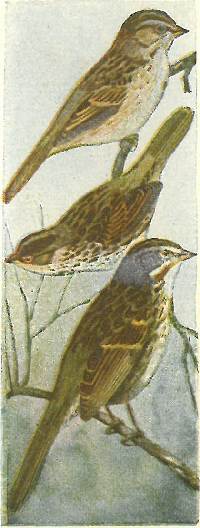
A bird of song, as the name indicates, and their song can be heard in every state of the Union and in Canada. This is the most subdivided of any of the bird family; more than twenty sub-species are listed, all having about the same song and general appearance. In some localities they will be a darker brown, and in the light desert sands they are very light in color. It is almost impossible to distinguish one from another even when in the hand. Their eggs also have the same variation, and cannot be positively identified one from another. They all build either in low bushes or upon the ground. Usually four eggs, greenish white, blotched and spotted with all shades and patterns of brown (.80 × .60).
Found in the central valleys of California, casually to Nevada.
In the Pacific Coast belt from Alaska to southern California.

To be found most commonly in the central and western parts of North America, rare in the eastern part. In appearance they are very much like the Song Sparrow, but in their habits are more retiring, and keep more closely in the grass, and out of sight. They nest in tufts of grass within a few inches of the ground, or in a slight depression in the ground. The nest is made of twigs, roots and grasses. Their eggs are similar to the Song Sparrows; three or four in number, greenish white, heavily marked with brown (.80 × .58).
These are large reddish brown sparrows, thickly marked with spots of darker brown on the back and under parts. They are to be found from Alaska to southern California.
Nest.—In low bushes near the ground. Four pale greenish eggs, marked with brown (.94 × .68).
This is quite a little larger than the above, has a much thicker bill, and is to be found throughout California in the mountains.
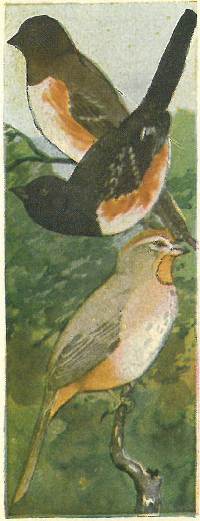
This family are all ground birds, and are usually found scratching among the leaves for their food supply of seeds and insects. This is a much darker bird than his eastern relative. The females are marked much the same as the males, replacing the black with a brown. They build their nest on or near the ground, of twigs, grass and with a finer lining of grass, and usually it is well concealed in bunches of grass or under some brush pile. They lay four or five eggs of a pale gray or white, much spotted with brown (.95 × .75).
Darker and with few white markings. Southern California (not illustrated).
These birds have more brown, and nest in bushes or trees and not so much on the ground. Their eggs are more strongly marked. They range from Colorado to Texas and Arizona.

A larger and still darker variety, with but very little white if any. It is found in California, from Shasta County to the southern part of the state. They are not as shy as the Towhee family generally are, and frequently come about habitations, where they will scratch about barnyards like chickens. They nest within a few feet of the ground, building much the same as other members of this family. The eggs are also very similar to the others.
More of a reddish brown. Found in Arizona, New Mexico and southern California, where it breeds on the coast range.
This member of the family has characteristics of his own entirely different from any of the others. They are birds of the brush, and rarely appear above the shrubbery in which they nest.
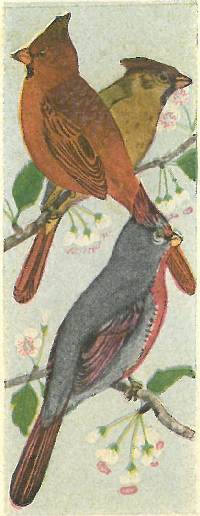
These are birds of vine grown gardens and thickets, where, with their beautiful song, brilliant plumage, and quiet disposition, they make themselves the favorites of mankind. The bill is very large and stout, but the general makeup of the bird, with its long crest, is much to be admired. They build their nest of twigs, roots and grasses, loosely put together, which is placed in bushes, vines or low trees. Their three or four eggs are a pale bluish white, with varied markings or spots of shades of brown, mostly about the larger end (1.00 × .70). Found in Arizona and into Mexico.
The bill of these birds is more hooked, short and stout like the parrots. Their crest, which is not as heavy as the Cardinals, they have the habit of raising and lowering often, changing the whole appearance of the bird. Their nesting habits and eggs are similar to the last.
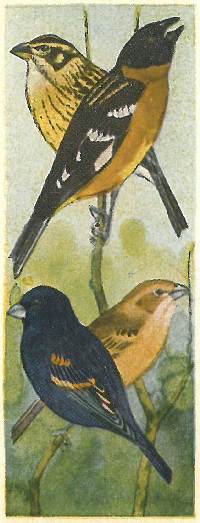
This species similar in size to the Rose-breasted Grosbeak of the eastern sections (which is sometimes found west to Colorado), does not have the bright colors of his eastern brother. In habits they appear to be much the same, their song is wonderfully sweet and clear. They are very quiet birds, and when nesting will almost allow one to touch them before leaving. Their nests are simply a few straws and sticks, loosely laid on the forks of some horizontal branch of a bush or low tree, so frail that frequently their eggs can be seen from beneath. They lay four eggs of a bluish green, spotted and blotched with different shades of brown (1.00 × .70).
Found more in the open woods, in small groves and along the roadside in the small brush. It seems out of place to have three members of the same family with such a difference of plumage. One with rose, white and black; the next with black, brown and yellow; and this bird, a blue and black. Their nesting habits and also their eggs are much the same as above, the eggs being a little smaller (.85 × .62).
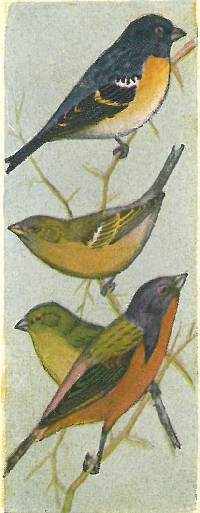
An eastern form, of an indigo blue on the head, shading to lighter on the under parts and towards the rump. It is found as far west as Colorado and into Texas (not illustrated).
Similar to the above, but lighter, while the under parts and breast are brownish. The wings are barred with two bands of white. It is found from British Columbia to Lower California and from the western coast to eastern Colorado. The nesting habits and eggs of the two are identical. They build in bushes or lower branches of trees, only a few feet from the ground, three or four eggs of a pale bluish white, unmarked (.75 × .58).
These are the most varied in color markings of any of our North American birds, having bright colors. Found in southern and Lower California, Arizona and into Mexico. Like the above they are to be found in thickets and hedges, where they build their nests within a few feet of the ground.
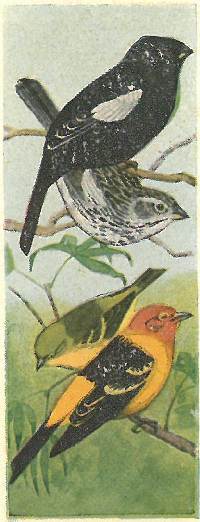
The male is a prettily marked bird with a yellow line over the eye, on the side of the throat, edge of wing and front under parts; black patch on the breast, white throat and a bright chestnut patch on the wing. It is found rarely in Colorado and into southern California (not illustrated).
Bill very short and thick, and light color. The male in summer is a dull black all over, with the exception of white wing-coverts. Their habits are similar to the above. They have a fine song, which they often give while on the wing, after the manner of the Bobolink. The female is a sparrow-like looking bird, mottled brown and white. They are birds of the plains, from Canada to Texas, occasionally in California and Colorado. Nest on the ground, laying four pale blue eggs (.85 × .65).
Found from British Columbia to southern California, breeding in mountains. Three or four eggs, bluish green, spotted with brown (.95 × .75).
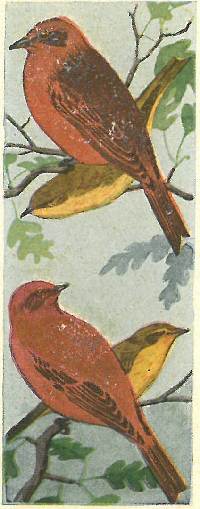
A pale colored bird as compared with the Scarlet Tanager of the east, lacking also the black wings of its eastern brother. The female is a pale yellow on the under parts and an olive above. Their range is throughout Arizona and into Mexico. The nest is built upon horizontal branches of trees at varying heights from the ground, and is made of twigs, grass and hair, usually a frail structure, in which they lay four eggs of a greenish blue, spotted with shades of brown (.92 × .64).
Western United States, breeding from Central California to Texas and the borders of Mexico. Their breeding habits are the same and the eggs are not distinguishable from the others, all of them varying in the markings, but practically of the same size and general color.
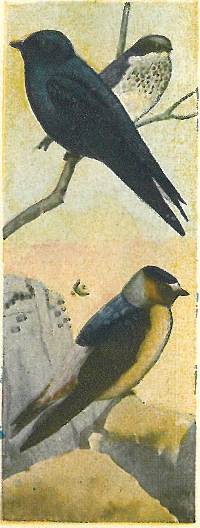
The male of this is not to be distinguished from the eastern Purple Martin, and in the female a lighter gray on the forehead is the only difference. They nest in cavities of trees or in boxes provided for them in the cities and towns, both in the east and west, as they are to be found breeding throughout the United States and into British Columbia. They make their nests of twigs, roots and mud, usually lined with feathers, and lay from four to six white eggs (.95 × .65).
Their range is throughout the whole of North America; they can easily be recognized by their brownish throat and breast, white forehead and black cap. Their nests or homes are built of mud, securely cemented to the face of cliffs, or under the eaves of buildings. They make them round or gourd-shaped, with a small opening in the side, and lining the inside with grass and feathers. They lay four eggs, creamy white, spotted with shades of brown (.80 × .55).
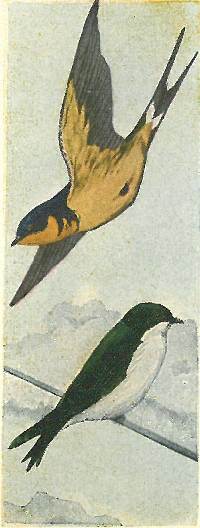
Their range is throughout North America, breeding generally from Alaska to southern California, and over the eastern part of the United States. They nest in barns, sheds or in any buildings where they are not likely to be disturbed, building their nests of mud on the rafters or beams near the roof, and lining it with feathers. They are a familiar bird in all parts of the country, and one of the most graceful while on the wing, skimming over the ponds and meadows in search of the insect life which constitutes their food. Their eggs are similar to the Cliff Swallow, creamy white, spotted with shades of brown and chestnut (.80 × .55).
Perhaps this is more commonly known as the White-bellied Swallow, and it is found in the whole of temperate North America, breeding from the middle United States northward. They nest in holes of trees and stumps naturally, but accept the bird houses that are put up for them in suitable locations near ponds or wet marshes. Their eggs are the same as above, both in number and markings.

In the Rocky Mountain regions of the United States and west to the Pacific, breeding throughout its range. A most beautiful species with its blue, green and purple back and white under parts. They are abundant in favorable localities in California, building their nests in holes of trees, at times well up in the mountains, in the tops of some of the largest redwoods and pines, using woodpecker holes, and at times placing their nest in a crevice of the cliffs. Their nests are made of grass and fine roots, and nicely lined with feathers. Their four to six eggs are pure white (.72 × .50).
The whole of North America north to the limit of trees, and south to the Gulf of Mexico, breeding from the middle portion of the United States northward. These birds build their nests in sand banks in almost all sections of the country, digging a small tunnel from one to three feet in length, enlarged and lined with grass at the end. They lay from four to six pure white eggs (.70 × .50).
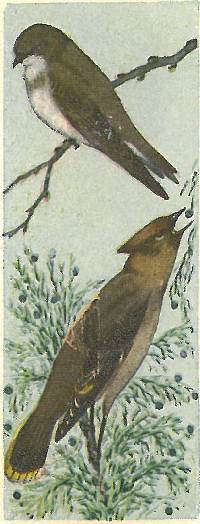
This species is about the same size as the last, and similar, but with the throat and breast grayish in place of the white. The outer webs of the outer primaries are recurved, forming a series of hooks. It nests in holes of embankments or in the crevices of cliffs, or among the stones of bridges and buildings. Their eggs are four in number and are pure white (.75 × .52). The range of these birds covers the whole of the United States, breeding from Mexico to British Columbia.
A northern variety, breeding in Alaska and northward, winters to California and the northern states of the United States. It may be identified from the following by the markings on the wings of white and yellow, and the larger band of yellow at the end of the tail. The wax-like appendages on the wings and tail may be found on both species.
Their nests are made of rootlets, grass and moss, and placed in bushes or trees at a few feet from the ground. Usually four eggs are laid, of a grayish color, sharply spotted with brown (.95 × .70).
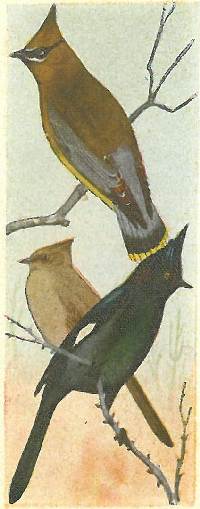
These are a North American bird, and great travelers in large flocks all over the country, separating at breeding time, and mating up, with a pair or two selecting some orchard or suitable locality to remain during nesting time. They breed throughout the northern United States and north into Canada. Their nests are placed in almost any kind of tree, on horizontal limbs, made of twigs, rootlets, string and grass, in which they lay usually four eggs of a dull grayish color, spotted with dark brown, mostly about the larger end (.85 × .60).
These are found from central California to Texas and into Mexico. In habits they are very much like the preceding, and the female is quite similar in looks, while the male is a rich shining blue black, with a long pointed crest, and a white patch on the wings. Their food consists of insects and small berries. They build loosely constructed nests, with a more compact lining of plant down. They lay two or three eggs of a light gray, spotted with brown (.88 × .65).

One of the largest of the family in the United States, the breast being barred with wavy lines of gray above the paler gray, with the wings and tail having much white, showing especially in flight. They are bold birds; carnivorous in their habits, living upon other small birds, insects and small rodents. In winter they have been known frequently to live about cities, catching the English Sparrows in the parks and city streets. They tear their food to pieces with their bill, which is shaped similar to that of a hawk’s, while their feet are small and weak, not at all resembling the hawk’s feet. Their nests are placed in thickets or thorny bushes, and are made of shreds of vines, grasses and plant down. Four to six grayish white eggs are laid, these being spotted and blotched with shades of brown (1.05 × .75).
In size the same as the White-rumped Shrike, and in habits and general appearance much the same, being somewhat darker, more on the under parts and sides. Eggs similar but smaller.
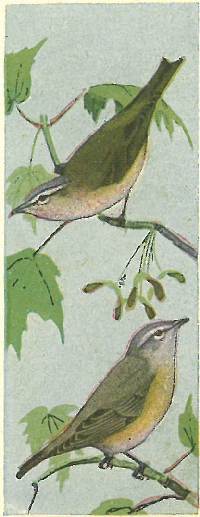
One of the most common of the family throughout its range, from the eastern slope of the Rockies over the United States. Wherever they may be found, their song is heard continuously during the day, from early morning until late in the evening, it consisting only of two or three notes, first a rising inflection, then a falling, and repeated over and over, even while they are feeding. The nests are placed within a few feet of the ground on an overhanging limb, suspended from a fork, and made of strips of bark, plant fiber and often with pieces of string and paper included in its construction. Three or four eggs are white, specked sparingly with brown (.85 × .55). This is one of the favorite nests in which the Cowbird deposits its eggs.
These are nearly as common as the above, but probably not as well known, as they keep well up in the tops of the taller trees, where they also build their nests, very much the same as the Red-eye. Their song is much more pleasant. Four eggs, like above (.72 × .52).

To be found west of the Rockies from British Columbia south to Lower California and Mexico. In southern California, it is found breeding much more commonly than the Western Warbling Vireo, placing its nest high in the oaks and coniferous trees. It belongs to the same musical family, keeping up its song from morning until night. The nest is made of similar material to the previous, and the eggs are the same, except in size (.75 × .58).
A smaller variety, the male marked with a black cap. Breeds in Texas, north to Kansas. Winters in Mexico (not illustrated).
Similar to last, without the black cap. Found in central and southern California. Nesting habits similar to others of the family. Eggs white with a few spots of brown about the larger end (.70 × .50).
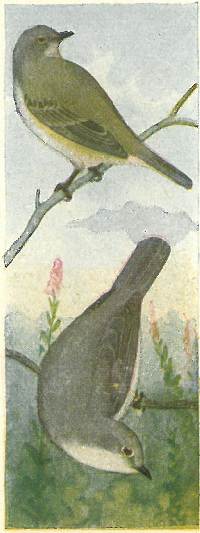
Like Hutton, but a trifle smaller and darker. Found from British Columbia to southern California, breeding in Oregon (not illustrated).
Much like the last, and found nesting in southern California, Texas and Arizona. Their nest is a neat, compact, cup-shaped structure, made of shreds of vines and fine roots, and lined with fine grass. The four eggs are white, spotted finely with brown about the larger end (.70 × .80).
Found in the southwestern United States, from western Texas, and southern California, into Mexico. They are not uncommon birds in the mountains of Arizona, where they nest in low bushes or trees, building their nest similar to the Red-eyed vireo in the horizontal fork of some overhanging limb, within a few feet from the ground. Usually four white eggs, which are finely spotted with brown about the larger end (.72 × .53).
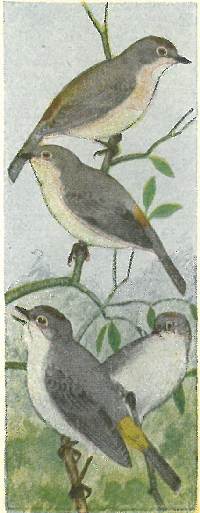
This eastern bird, with its black and white markings, is found in southern Texas, and has been seen accidental in California and Washington (not illustrated).
Range.—Southwestern United States and Mexico. It breeds quite commonly in Arizona, where it builds in almost any situation, in the loose bark on tree trunks, in deserted woodpecker holes, in the cactus or in small bushes near the ground. The nest is made of fine grass, leaves and feathers, in which they lay usually four white eggs, spotted and wreathed with brown about the larger end (.60 × .50).
Range.—Rocky Mountains, from Colorado to Arizona, and winters in Mexico. They are much like the last, but have a patch of yellow on the rump and breast. Their nest on the ground, beside some rock or stump, is made of shreds of vines and grass. Three or four white eggs, specked and wreathed with brown (.62 × .50).

Found in the Pacific coast regions, breeding from central California north to British Columbia. Winters south to Mexico. In Oregon and California, these birds are quite common in favorable localities on the mountain sides. They build their nest on the ground in a slight depression, making it of twigs and grasses, and usually well concealed with overhanging grass or brush. Their four eggs are a creamy white, with fine spots of brown and lavender, forming a wreath about the larger end (.60 × .45).
Range.—Central North America, breeding in the Rockies locally, from Alaska to Mexico. Crown with a concealed, dull orange patch. Nesting habits and eggs same as above (not illustrated).
This bird is found breeding from Alaska along the Pacific coast to southern California. Nest placed in similar locations, and the eggs are the same as above (.60 × .45).
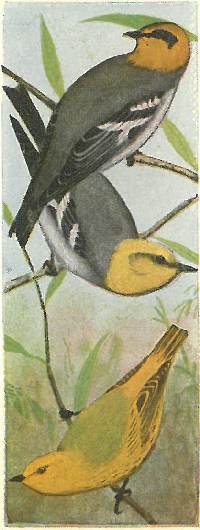
Range.—In the mountains of Arizona and New Mexico, southward. They may be easily identified by their orange-brown head and neck, with a broad black band through the eyes. Their nests are placed at high elevations in coniferous trees on the mountain sides. They build a very compact nest, saddled upon a horizontal limb, the nest having a resemblance to a knot; it is made of moss, lichens, etc., and lined with fine rootlets and down from plants. Their four eggs are a pale gray, completely covered with spots of dark brown, the heaviest at the larger end (.64 × .48).
Range.—The whole of North America, breeding throughout its range. They are active little bunches of yellow, as they gather in their many insects for food, all the while singing their happy song. They place their nests in almost any kind of trees, but seem to prefer willows and alders near some brook or pond, where insect life is abundant. Their nest is a compact, cup-shaped structure, made of fibers and grasses, lined with plant down or cotton.
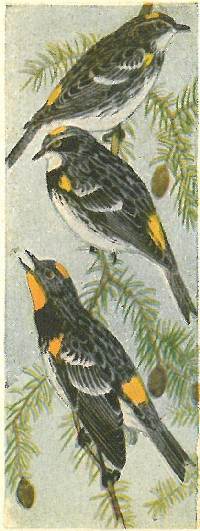
Range.—Most of North America. On the Pacific coast, it is found from central Oregon to southern California. It is quite commonly known as the Yellow-rumped Warbler, both in the east and west. They differ from the following, mostly in the throat markings, this one having a white throat and much more black on the head and breast, while on the following the throat is yellow. They nest in the lower branches of coniferous trees, making it of grasses, rootlets and fiber, in which they lay usually four eggs, white, spotted with shades of brown and lilac, more heavily about the larger end (.70 × .50).
This species is found in the western United States from British Columbia to Mexico, and rarely east of the Rockies. They are more of a dull-colored bird than the preceding. Their nesting habits and eggs are identical with the last (.68 × .52).
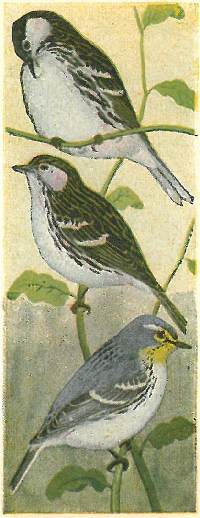
Range.—This is an eastern bird, found west to the Rockies and accidental in California. The white over the eye, white wing patch, and the band of white across the tail will identify this species (not illustrated).
Range.—North America, mostly east of the Rockies, but found in the Rockies from Alaska to Colorado. They nest on the lower branches of coniferous trees, made of roots and strips of vine, and lined with feathers and lichens. Four dull white eggs, spotted with brown (.72 × .50).
Range.—Western North America, British Columbia to Lower California and Arizona. Nest usually in pines near the tops of the trees, made of roots, fibers and lined with plant down. Eggs white, with light spots of brown (.65 × .45).
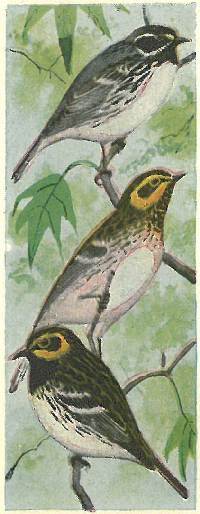
Range.—Western North America, British Columbia to Lower California. A small bird, with a black throat and breast, forming a circle about the neck, and black on top of the head. They are found mostly in the woodlands, bordered with thickets, in which they will place their nests, within a few feet of the ground. It much resembles that of the Yellow Bird, being compact and made of the same materials. Three or four eggs are creamy white, spotted with brown, forming a wreath about the larger end (.65 × .52).
Range.—Mostly in the eastern part of North America, but occasionally in the southern Rockies, Texas and Arizona. Black throat and breast, with bright yellow cheeks and olive head and back (not illustrated).
Range.—Western United States. A similar bird to the above, with black on top of the head in place of the olive. Nesting habits are practically the same, as are also the eggs.
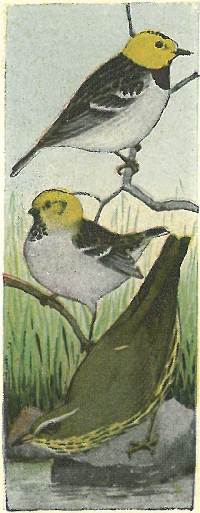
Range.—Western North America, from British Columbia to southern California, Texas and Arizona. These are to be found in the high, mountainous regions among the coniferous trees, where they build their nests on the outer limbs of tall pines, almost impossible to find. Their nests are made of grass, and the needles from the pine, and not much of a nest as compared with some of this same family. They lay four white eggs, spotted and wreathed with shades of brown (.68 × .52).
Range.—From Alaska to Mexico, breeding in the northern portions. They are a quiet bird, solitary in habits, nesting in stumps near the ground or among roots of fallen trees. Four white eggs, spotted and blotched with brown and lilac (.80 × .60).

Range.—Western North America, from British Columbia to southern California, breeding throughout its range. They are common warblers of the Pacific coast, to be found on or near the ground in thick shrubbery, where they build their nests within a few feet of the ground. This is made of grasses and shreds of vines, and lined with finer grasses and hair. Four eggs are laid, white, spotted and quite heavily marked with shades of brown (.72 × .52).
Range.—Western North America, from British Columbia south to Arizona, but not near the Pacific coast. It is one of the seven or eight forms of the Maryland Yellow-throat, the greatest difference in them being in the locality in which they are found. They place their nest in a clump of grass, well concealed, laying usually four white eggs, with few spots of brown (.70 × .50).
Range.—The Pacific coast. Habits, nest and eggs same as above.
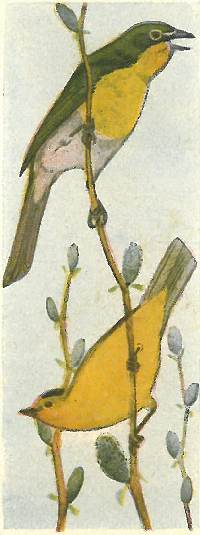
Range.—Western United States, breeding from British Columbia to Mexico. They are an attractive bird both in looks and habits. They are great singers, but nature seemed to give them no special song of their own, and they make good attempts to mimic the song of any bird in their locality, and keep continually at it. They like the bramble and vine-covered hillsides, where it is hard to obtain a sight of the bird. They build their nests in the thickest of such places a few feet from the ground, made up of shreds of vines, leaves and twigs, lined with grass. Four white eggs, spotted with fine dots of shades of brown (.90 × .70).
Range.—Western North America, breeding in Oregon, Washington and California to Mexican borders. These little birds, with their deep yellow under parts and breast, and little cap of jet black, are quite common about many of the orchards and gardens when the trees are in full blossom, taking insects that abound at that time. They nest in moist grounds in a slight depression or in low bushes, made of fibers and grass.
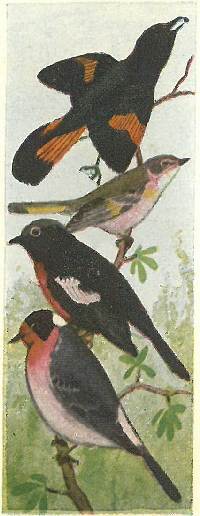
Range.—North America, found more commonly east of the Rockies, but less common in Oregon, California and to Arizona. These birds are always the most conspicuous when in flight, at that time showing off to the best advantage their bright orange markings on the wings and tail of the males, and the bright yellow of the females. They build a neat, cup-shaped nest of plant fibers and down, which is placed in the crotch of small trees, in which they lay four white eggs, spotted with different shades of chestnut and black (.65 × .50). They are very active, and constantly flying from place to place, taking insects while on the wing, which constitute their food.
Range.—New Mexico and Arizona. These have much the same habits as the above, except that they build their homes in cavities of rocks or on the ground in swampy places.
Range.—Arizona and New Mexico.
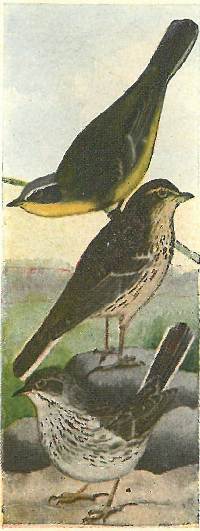
Range.—Alaska and Bering Sea in summer, where they are fairly common on the islands and coast. They nest on the ground, under or beside stones and in bunches of grass; it is made of roots and grasses, lined with moss and animal fur. They lay from four to six white eggs, thickly covered with spots of brown (.75 × .55).
Range.—It breeds on the high mountains of Colorado, California, Alaska, north to the Arctic Zone. During migration they may be found over most of the United States in quite large flocks. Their nests are placed on the ground in tufts of grass, and are made of fine grass and moss, lined with feathers and hair. Four to six eggs are grayish, heavily blotched with brown (.75 × .55).
Range.—Breeds from Manitoba to Montana and Dakota, and west to the Rockies. Habits, nest and eggs are similar to preceding.
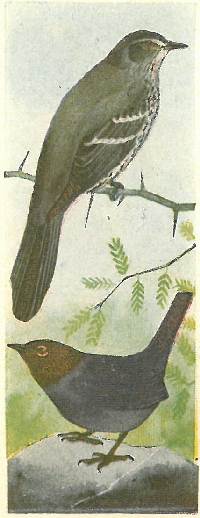
Range.—From Lower California and Mexico on the plains to Montana. This is an abundant bird in the sage regions of the plains throughout its range, and are frequently called the Mockingbird, on account of the varied song which they give from the top of some sagebrush or cactus, in which they nest. Four eggs, greenish, spotted with brown (.60 × .55).
Range.—Mountains of western North America from Alaska to Mexico. Among the rapid streams that are falling down the mountain side, these gray birds are to be found. They are strange members of bird life; they do not have webbed feet, and yet they swim on, or under the water, using their wings as paddles. They have a thrush-like bill, the habit of teetering similar to the sandpiper, and a song that is not to be forgotten if once heard. They nest on the rocks of these rapid streams, making their nest of moss, a bulky affair with an opening in the side, in which they deposit their four or five eggs of pure white (1.00 × .70).
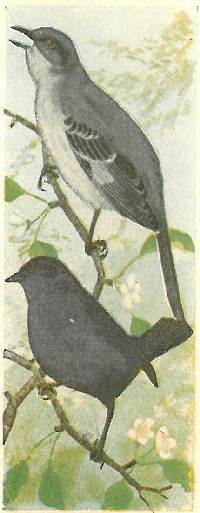
Range.—Texas to California and southward, breeding commonly from central California southward. These birds not only have a song of their own which puts them in the opera class, but, as their name implies, they can mimic or mock nearly anything in the bird line for song or bird notes. They are not satisfied with a few notes early in the morning and evening, but will keep their song in full play all day, without hardly seeming to take time to hunt up a few worms or insects, as if eating was not to be considered when he could sing.
They nest usually low down in bushes and thickets, and construct a bulky nest of sticks, roots and grass. Three to five eggs are of a greenish color, spotted and blotched all over in many patterns with shades of brown (.95 × .72).
Range.—Mostly eastern North America, but extends over the Rockies, occasionally to the Pacific coast. It is a fine songster and almost as much of a mimic as the Mockingbird. Breeding habits are much the same, but eggs are bluish green (.95 × .70).
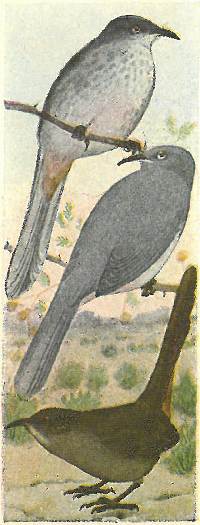
Range.—Arizona to Mexico, breeding abundantly in the desert regions of Arizona, where the cactus is mostly to be found. They all seem to belong to the happy family of songsters, and there is no lack of bird music in localities where these birds are in any numbers. Their nests are usually placed in cactus, or on the ground under them, and are made up of twigs, dried grass and moss. Usually four eggs are laid, bluish green, spotted with brown very finely all over (1.00 × .80).
Range.—Arizona and Mexico to southern Colorado. It breeds in Arizona and southern California. General habits are the same as above. While it may not be as common as the above, it is possibly a better singer. Eggs are the same, spots larger (1.00 × .72)
Range.—California, from Shasta county to Lower California. The habits and song, as are also the nest and eggs, much like the above (1.12 × .82).
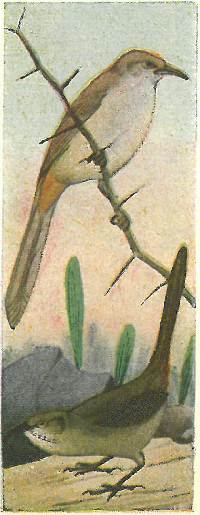
Range.—Southern and Lower California to Mexico. This is the lightest in color of any of the family, and has taken on the color of the sand of the low hot deserts in which it lives. Where it is so hot and dry that even the cactus and thornbush are stunted in their growth, where the ground is covered with the small varieties of cacti, with spines like needles. In such a place one cannot imagine that a bird would be as full of song as in a shaded piece of woodland, yet this bird has the same qualifications, and morning and night his voice may be heard, pouring out as rich a song as his brother of the north. Their nest, composed of twigs, weeds and lined with grass, is usually very bulky, and placed in low mesquite trees or cactus. The eggs are lighter in color than above, and with fewer and finer spots of brown (1.10 × .75).
Range.—From Utah and Nevada to southern and Lower California and Texas. This species is somewhat darker, and more rufous on the under tail coverts than the above.
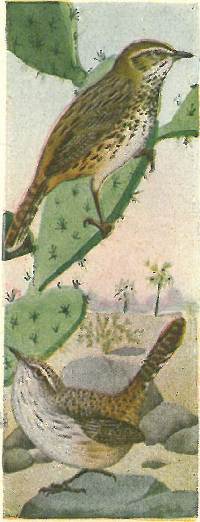
Range.—Southern part of California, to Texas, and north to Nevada and Utah. They are the largest of the Wrens, and look the least like that family of any of them. They are a common bird in the desert lands, where the cactus abounds, but lacks the sweet song of some of the smaller members of the family. Their nests are bulky, ball-shaped structures, made up of sticks, moss, grass, and lined with feathers. There is an opening on the side for an entrance, and it is usually placed in a thorn bush or cactus. Their four to seven eggs are creamy white, dotted thickly with chestnut (.95 × .65).
Range.—Western coasts from British America to Mexico. These bird are equally at home on the mountain sides or in the deep canyons, building their nests in the crevices of rocks or stumps, where they lay from five to eight white eggs, with fine spots of brown about the larger end (.72 × .50).
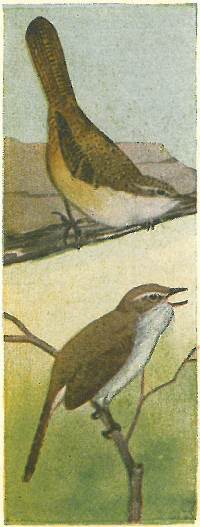
Range.—Rocky Mountain ranges, from Colorado to Mexico, breeding throughout its range. As he is gathering his supply of food among the huge boulders and in the large rocky canyons, where he makes his home, you will, at short intervals, hear his loud joyous song, a song that puts to shame that of his largest relative of the plains. They build their nest of small sticks, leaves, grass and feathers, which is placed in the crevice of some rock, either down near some swiftly running mountain stream or high up in the cliffs above. Their three to five eggs are white, with spots of brown and lilac well covering the under color (.72 × .52).
Range.—Coast regions of California. These are active and restless little birds. Eating and singing, and singing and eating is all this life holds for them. Nesting in bird boxes, holes in trees, in sheds, or almost any locality in which to place their six eggs (.65 × .50).
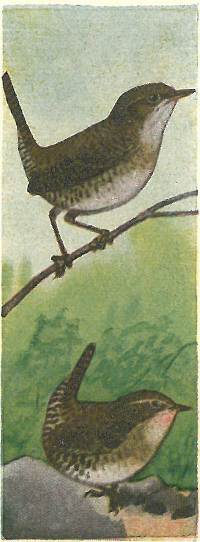
Range.—Pacific coast, from British Columbia southward to Lower California. These happy little songsters are to be met with more about civilization, and seem to prefer the cultivated lands to the wild. They build in bird houses or holes of trees, and no matter how large the tenement may be they will keep busy until it is filled, leaving only space enough for their nest. They lay from five to seven eggs of a pinkish color, with a wreath of brown dots about the larger end (.65 × .52).
Range.—From Alaska to New Mexico, through North America. This is the smallest of the family, and is also one of the most quiet in song. They are active little fellows, just a bunch of feathers, with a short stub of a tail up over their backs when observed, and getting about the brush heaps and stone walls like little mice. They nest in walls or crevices of rocks, and stumps, building of twigs, leaves, grass and feathers, in which usually six or seven eggs, creamy white, finely specked with brown, are laid (.60 × .48).
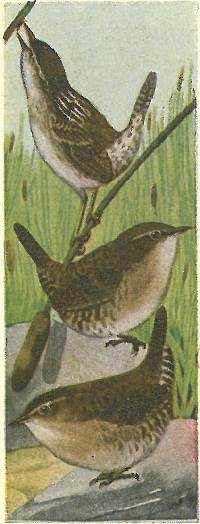
Range.—Aleutian Islands and Alaska. This is a somewhat larger variety of the preceding, and is found only in the far north. Its breeding habits are the same, as are also the eggs, which average a little larger (.65 × .51).
Range.—Western Aleutian Islands to Alaska. Very similar to the above, both in song and general habits. They nest in the crevices of rocks or between boulders, making their nests of rootlets and grass, lining it with hair and feathers. Usually six eggs are laid, white with a few specks of brown (.58 × .46).
Range.—Pacific coast, from British Columbia to southern California. This is a western form of the Long-billed Marsh Wren, found more east of the Rockies. They build a globular-shaped nest of grass and rushes, attached to upright rushes just above the water. Five eggs are laid, of a pale chestnut color, with darker markings (.64 × .45).
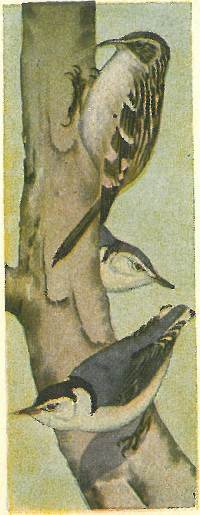
Range.—From Alaska, in the Rocky Mountains, to southern California and Mexico, breeding throughout its range. A quiet, small, brown colored bird of the deep woods, where its lisping note may be heard, if the air is very quiet, and one is looking for bird life. When found, it will generally be climbing up the trunk of some tall tree, searching the crevices of the bark for the small insect life on which it feeds; when near the top, a downward flight to the base of another tree. Always flying down, and climbing up. Their nest is placed in the loose bark, and is made of fiber, moss and grass. They lay from four to seven white eggs, spotted with chestnut (.58 × .48).
Range.—Pacific coast region, from British Columbia to southern California. These are similar to the White-breasted bird of the east. Unlike the above, although these are tree climbers, they are as often found coming down the tree as climbing up. They build in cavities of various kinds of trees, laying five or six white eggs, quite heavily marked with brown and lilac (.80 × .60).
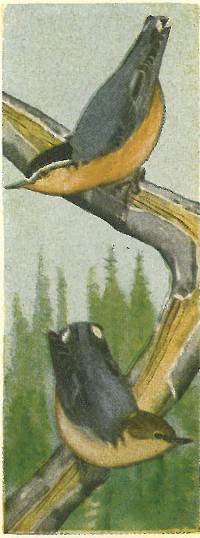
Range.—North America, breeding in the northern part of the United States and northward. Like the former, these are great acrobats, looking into every crevice of the bark in search of their supply of food, caring little whether they are going up or down in their search. After the breeding season these birds are often found in flocks about the coniferous trees, and appear to be very sociable, keeping up a continuous “yank, yank,” among themselves. They have no other song.
Their nest is usually placed in a cavity of some tree at quite an elevation from the ground, being lined with strips of bark and feathers. They lay from four to six white eggs, thickly spotted with shades of brown (.60 × .50).
Range.—West of the Rockies, from British Columbia to southern California and Mexico, breeding throughout its range. These are the smallest of the family, and their habits and nest and eggs are the same as the preceding. Their eggs being slightly smaller.
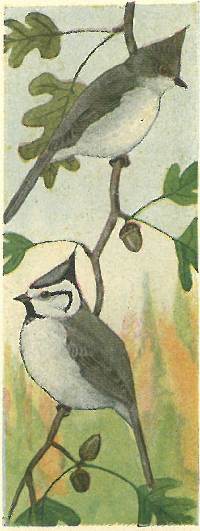
Range.—California and Oregon, west of the Sierra Nevadas. These are quite common throughout their range; they are quite a little bird, with only a few “quit, quit” like notes, and in color they are as quiet as in habits. They build in cavities of trees or old stumps, their nest lined with grasses, hair and feathers. Their five to eight eggs are white, rarely with a few specks of brown (.70 × .50).
Range.—Texas, south into Mexico. Similar to above, but darker and with the crest black and forehead white. Nesting habits same as the above (not illustrated).
Range.—Arizona and Texas into Mexico. This plain colored “tit,” with the only markings about the head, black crest and breast, with white above and below the eyes, is common in parts of Arizona, where it builds within a few feet of the ground in cavities of trees. Nest and eggs the same as the Plain Titmouse (.70 × .50).
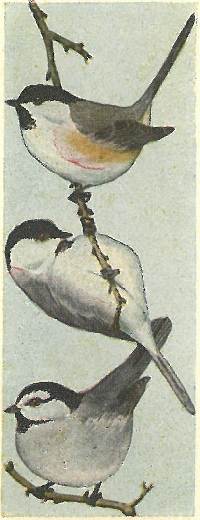
Range.—Northwest coast, from British Columbia to Oregon. These lively little birds are willing to make friends with almost anyone, and will get so tame that they will take pieces of suet from the hand. Their well known call of “dee, dee, dee” often repeated, is a cheerful sound, but their other note of “phoe-be,” or, as it seems to me they say “great-way,” is rather mournful and suggests that they are tired and have a “great-way” yet to go. They build in old stumps, usually near the ground, lining the cavity with grass, hair and plant down, in which they deposit from five to eight white eggs, spotted with brown (.60 × .45).
Range.—Arizona into Mexico. Has more black on the throat. Habits and their nest and eggs are much the same.
Range.—Western North America, Rocky Mountains west. Habits same as the preceding.
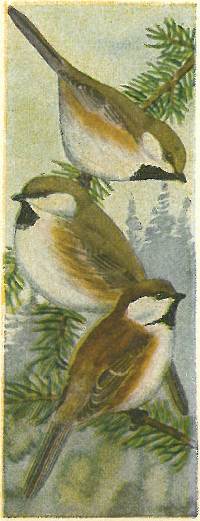
Range.—Alaska and eastern Siberia. One would naturally think that these little animated bunches of feathers would freeze in the far north where they make their homes. But they are the same sprightly little “chick-a-dee-dee-dee” that we have farther south, and do not seem to mind the severe cold at all. In habits, nest and eggs, these birds are so near alike that it is impossible to identify them.
Range.—Western half of British America. Habits the same as above.
Range.—Alaska to Oregon on the Pacific coast, and occasionally to central California. Habits the same as preceding.
Range.—Middle section of California, near the coast (not illustrated).

Range.—Pacific coast of California, Oregon and Washington. In habits all of these birds are similar to the Chickadees. They are full of life, and in searching for insects are as much at home when upside down on the outer end of a bunch of pine needles as are the Chickadees. For nest building they have no superiors, making long gourd-like structures of fibers, moss, and grass, woven closely together, lined with feathers and wool, suspended from twigs at a low elevation or woven into some thick brush; they have a small opening near the top for the doorway. They lay from four to nine pure white eggs (.54 × .40).
Range.—Oregon, Colorado, to southern California and Texas. The habits are identical with above. Nests are made the same, and from eight to twelve inches long.
Range.—Arizona, Texas and New Mexico. Habits the same as above.

Range.—Colorado and southern California to Mexico. This bird is simply nothing more than a Bush-tit with his Sunday clothes on, or not a full suit, but a bright yellow head and neck dress. They are abundant and active little fellows in the thick chaparral brush, where they build a nest more bulky than the “tit” but not as artistic or compact. They are placed in thorn or other bushes within a few feet of the ground, made of twigs and weeds, and lined with fur and feathers. Their eggs, four to six, are white. For amusement, they construct one or two additional nests, in which they remain at night.
Range.—From southern California north to Oregon along the coast. These are much like the Chickadee in habits, only much more secluded, frequenting the deep ravines along the mountain sides, where they build their nests of twigs, fibers of vines, grasses and feathers, in bushes near the ground. Four or five greenish blue, unmarked eggs are their complement (.70 × .50).
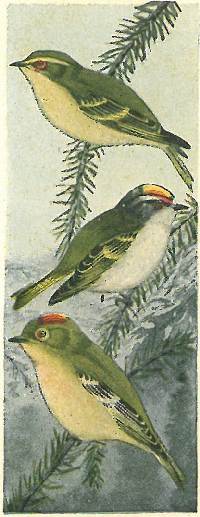
Range.—In Alaska casually. Breeds in the extreme northern part of Asia. Their nest and eggs have not been found on this continent as far as we know at present. They build on the ground in a tussock of grass, laying from three to five white eggs finely spotted with chestnut (.70 × .50).
Range.—Alaska to southern California, on the Pacific coast. These little birds are found commonly in company with small flocks of the Chickadee, and like them may be seen hanging on the under side of the outer ends of the coniferous trees in search of their insect food. They nest in the northern part of their range, building large, comfortable-looking structures of needles from the pines, strips of vines and grass, nicely lined with feathers. Four to eight eggs, dull white, spotted with brown and lilac (.55 × .42).
Range.—North America, breeding mostly north of the United States or in the Rocky Mountain regions farther south.
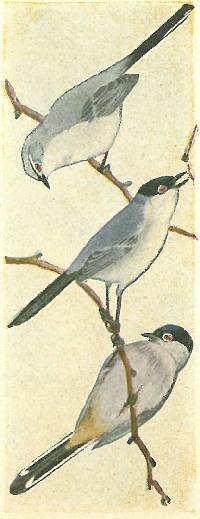
Range.—Western United States, breeding in northern Colorado and California. These birds in their actions somewhat resemble the Redstart, with their long tail, and quick flights into the air for insects and back again to the same twig, possibly near where their nest is placed. They build one of the prettiest of nests, very deep and cup-shaped, and on the top of some moss-covered limb at twenty to forty feet from the ground. Making the nest from plant down and moss, completely covered with lichens, so that it resembles a large knot on the limb, much like the nest of the Ruby-throated Hummingbird. Four or five dull white eggs, spotted with brown (.58 × .45).
Range.—Southern California, Texas into Mexico. Breeds like the above quite commonly in southern Texas; eggs a little smaller.
Range.—Southern and Lower California, on the Pacific coast.
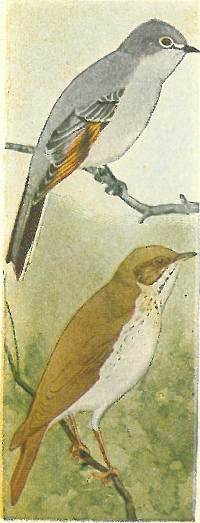
Range.—From British Columbia to southern California, through the western United States. They nest at high altitudes among the mountain tops, placing their nest upon the ground, among the rocks along the mountain streams. They build a large, loosely constructed nest of roots and twigs, lined with pine needles and moss, in which they lay their four or five white eggs, spotted with shades of brown more about the larger end (.96 × .70).
Range.—Western United States from British Columbia to southern California. It breeds and is quite abundant in the foothills and canyons of the mountain ranges. It is a western form of the common eastern “Veery,” and its breeding habits are the same, nesting in an old stump on or near the ground, making the nest of grasses and leaves, usually quite bulky. They lay four unspotted bluish green eggs (.90 × .65). Their song is peculiar and not as attractive as others of the Thrush family.
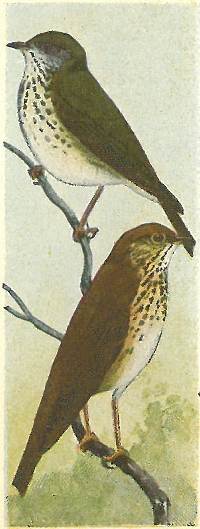
Range.—From British Columbia northward, and winters south to Mexico. Their nests are placed on or near the ground in a stump or tussock, usually in very moist places, and are composed largely of leaves and mosses. Their three or four eggs are a bluish green, spotted and blotched with reddish brown (.88 × .64).
Range.—From Alaska to Central America, breeding in the northern part, in Oregon and Alaska. Their nests are made and placed usually the same as the above, the eggs being of the same size, but of a lighter color. The Thrushes feed on small insect life and many of the small fruits and berries.
Range.—North America, breeding on the western coast in Alaska, Oregon, California and Colorado. Their nesting habits, eggs and song are the same as the Russet-backed (not illustrated).
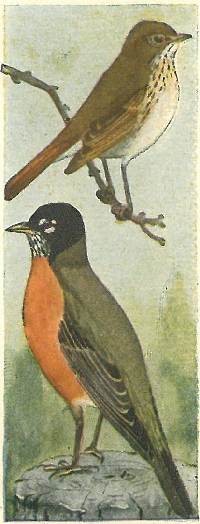
Range.—Alaska to Mexico, breeding in its extreme northern range. These birds are noted for their sweet and musical song, which may be heard from the swamps and thickets in which they make their home. They nest either on or near the ground, building it of shreds of vines, leaves and grasses. Four bluish green eggs, unmarked, are usually laid (.85 × .65).
Range.—Rocky Mountain region, from British Columbia to Arizona. Tail is much lighter than above, and bird larger. Their habits in home life are the same, this bird having the stronger and sweeter voice of the two (not illustrated).
Range.—West of the Rockies, from British Columbia to Mexico. This is not the familiar bird that is found in the east, but is very secluded, and its song is seldom heard. Nest is made of leaves, grass and twigs, plastered with mud. Four greenish blue eggs (1.15 × .80).
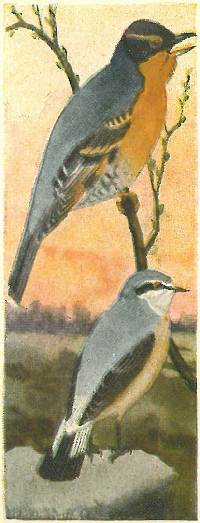
Range.—Pacific coast, from Alaska to Mexico, breeding in Oregon, Washington and California. They breed quite abundantly in the northern ranges in California and north to Alaska. Their nest is placed in small trees and bushes, usually near the ground, and is made of twigs, weeds and grass, lined with moss. Their eggs, usually four in number, are greenish blue, sharply spotted with few spots of dark brown (1.12 × .80). They have a pleasing song, which is rarely heard in their southern range.
Range.—Alaska and accidental in Colorado, breeding in Asia. They nest in crevices of cliffs or in stone walls, building a rude nest of sticks and weeds, lined with hair and feathers. Their four or five eggs are a pale greenish blue (.90 × .60).
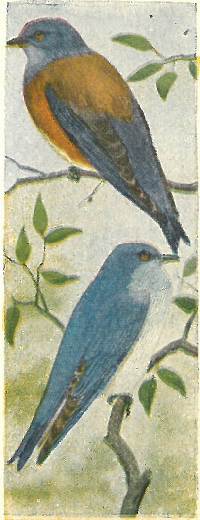
Range.—British Columbia to Lower California, along the Pacific coast. These familiar birds build in cavities in trees, or in bird houses, and make themselves at home near dwellings, especially if in the vicinity of orchards of any kind. The note of the western bird has the same familiar warble as their eastern relative. They live on small insects and caterpillars, and some of the small berries. Their four eggs are a pale bluish white (.80 × .60).
Range.—Rocky Mountains from Colorado to Texas (not illustrated).
Range.—Rocky Mountain regions from Canada to Mexico. Their habits are just the same, eggs averaging slightly larger.
[A] [B] [C] [D] [E] [F] [G] [H] [I] [J] [K] [L] [M] [N] [O] [P] [Q] [R] [S] [T] U [V] [W] X [Y] Z

THE COUNTRY LIFE PRESS
GARDEN CITY, N. Y.